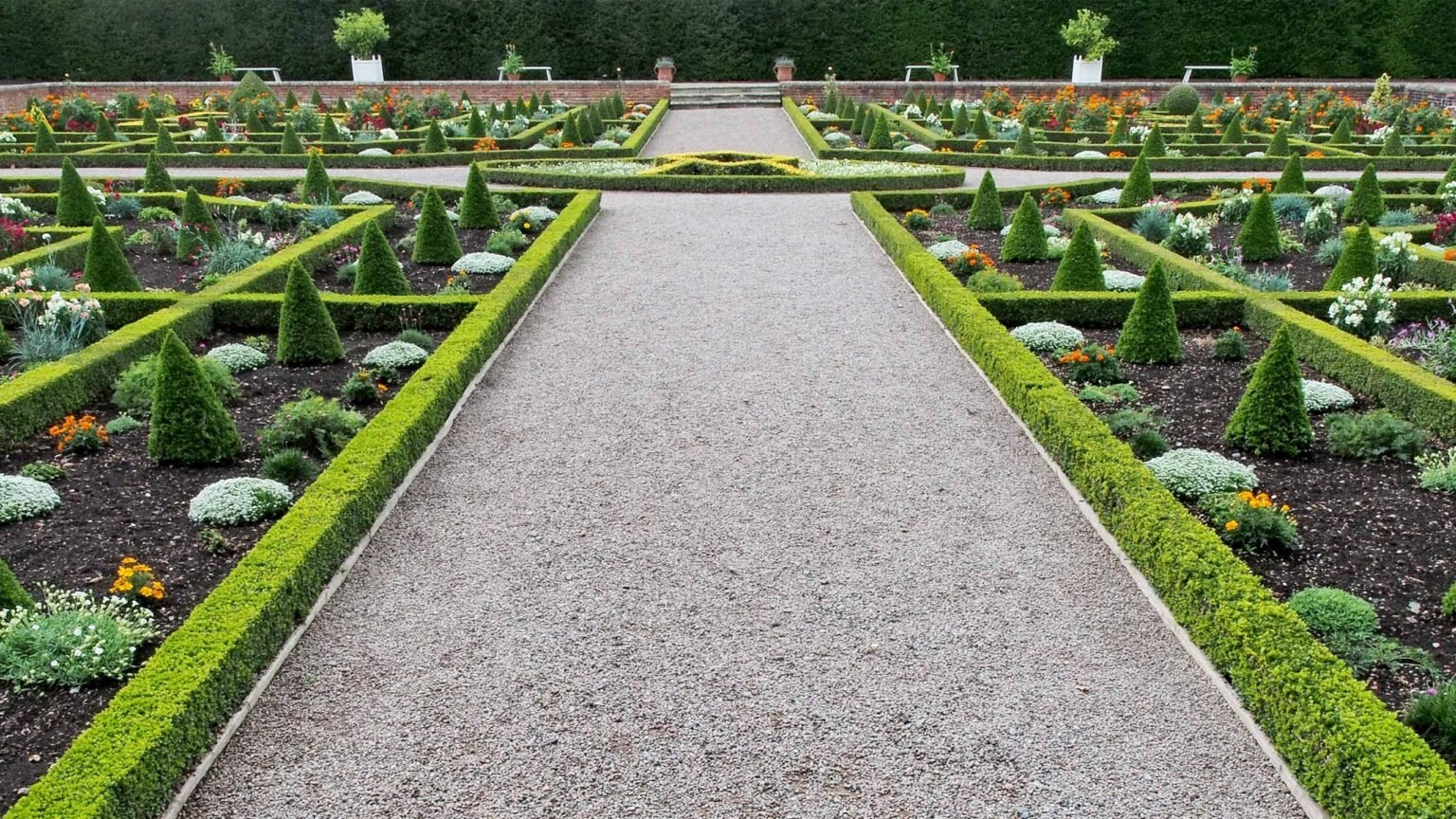
Introduction – History of Formal Gardens
Formal gardens have a long and rich history, dating back to Ancient civilizations such as the Persians and the Greeks.
These early gardens were designed with strict symmetry and geometric shapes, often incorporating fountains, pools, and carefully pruned trees and hedges. Their exact genesis is unclear, but it is likely that the development of reason, logic, maths and geometry all played a part in humans seeking ordered gardens where nature had been controlled and managed. Formal gardens require continuous maintenance and care, so there is a strong subtext to notions of virtue and Stoic principles in these types of gardens. These meritorious traits are contrasted with the “showiness” of formal gardens, giving them an inherent paradox between their virtue and vanity.
During the Renaissance period in Europe, where reason and classical sensibilities were at the forefront once again, formal gardens underwent a significant transformation. The Italian Renaissance was a time of great artistic and cultural development, and this was reflected in the design of gardens. The concept of the “garden as a work of art” emerged. Gardens were designed with intricate patterns, topiary, and symmetrical features, in an ordered fashion. This contrasted with more naturalistic medieval gardens, whose purpose was more functional, being a source of food (and often defence). So the Renaissance saw the transition of gardens moving from largely function to form, with aesthetics being elevated, and gardens being used to signal wealth, prosperity and our ability to control nature.
A depiction of the Hanging Gardens of Babylon.
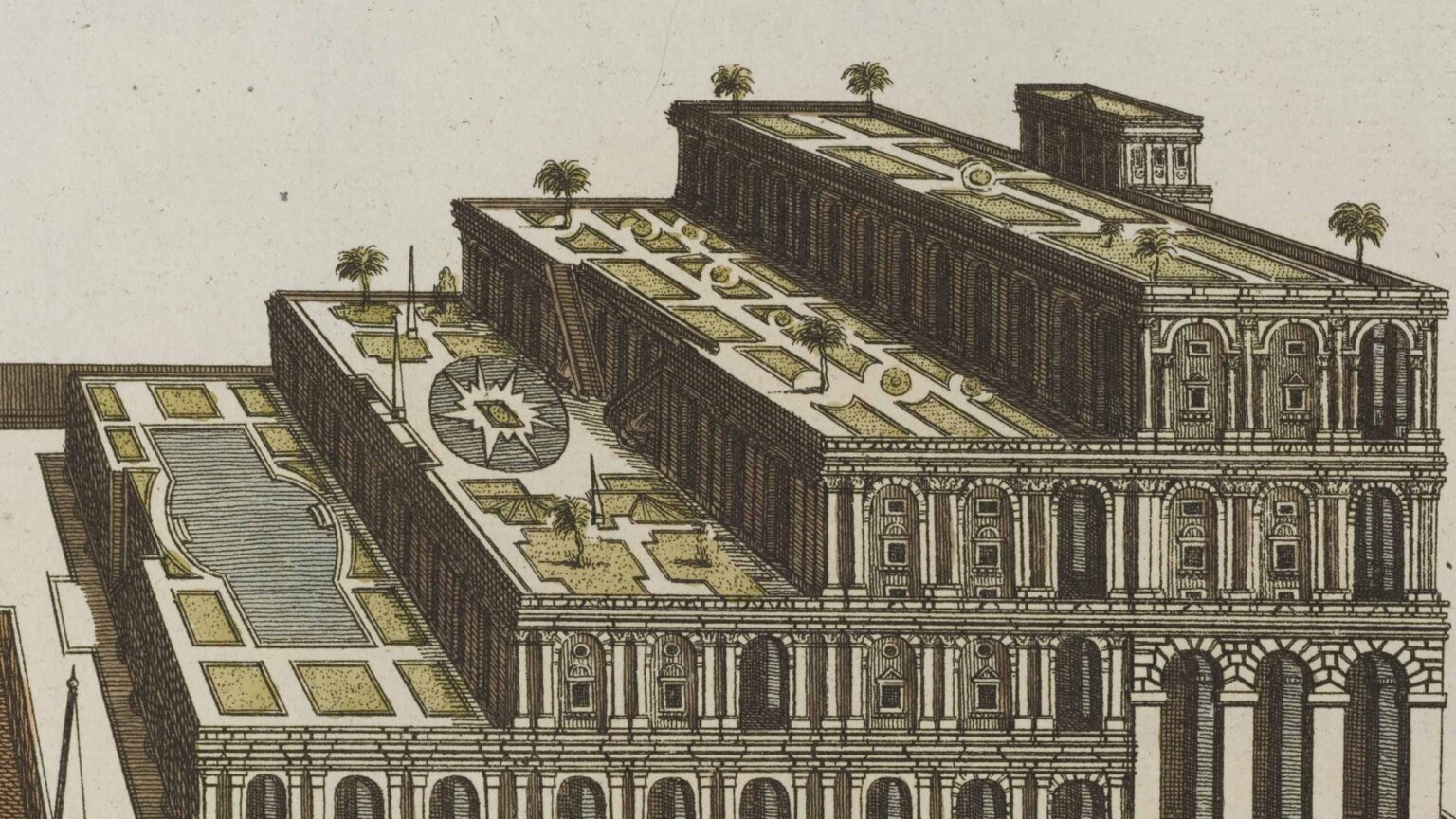
In France, the formal garden style became even more elaborate under the reign of Louis XIV in the 17th century. The Palace of Versailles, with its extensive gardens designed by André Le Nôtre, became the epitome of formal garden design. The gardens were arranged in a series of parterres, with fountains, statues, and topiary creating a sense of grandeur and opulence.
Palace of Versailles Gardens
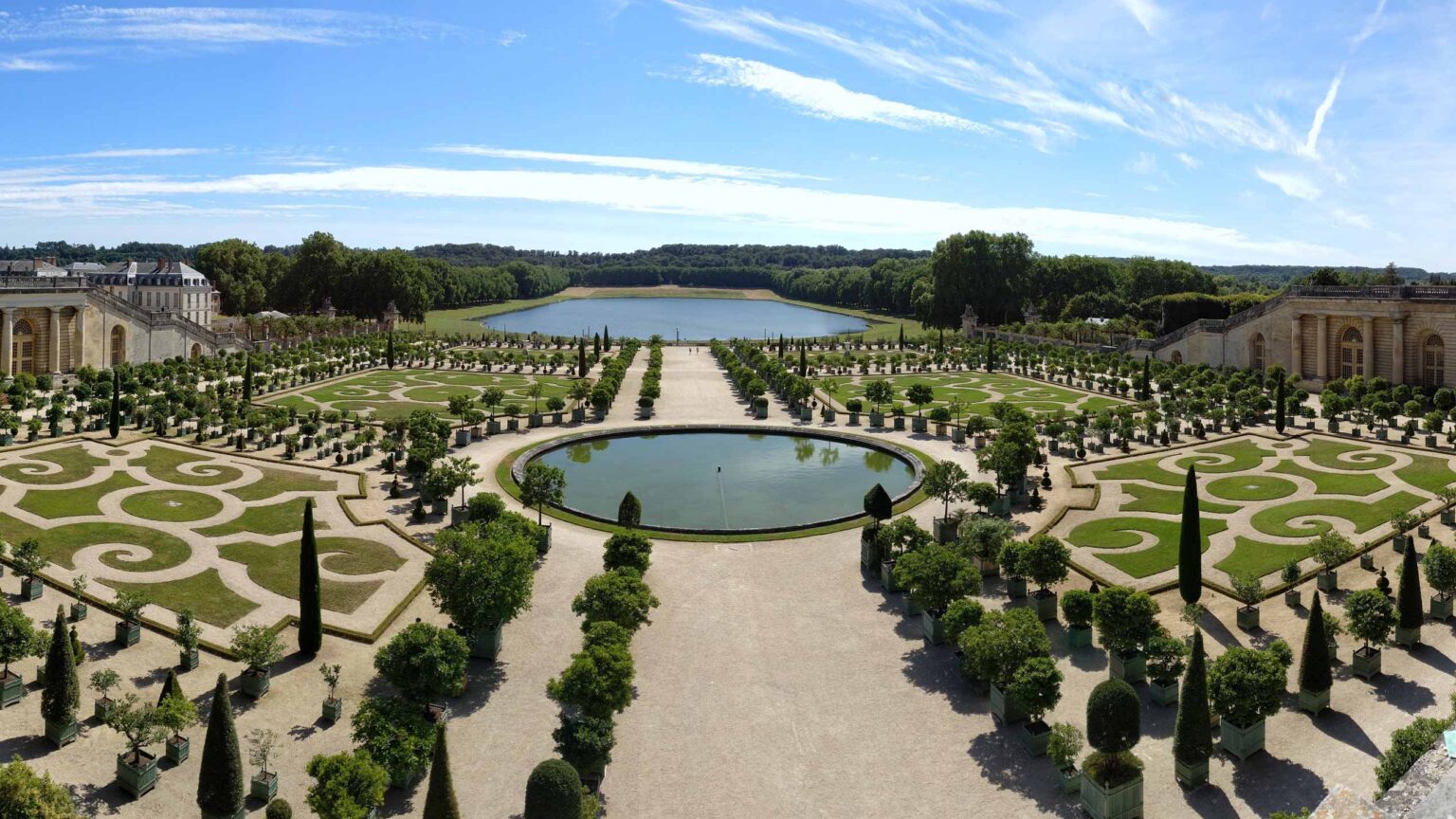
The history of British formal garden design spans several centuries, reflecting the evolution of aesthetics and social values. In the 17th and 18th centuries, influential landscape designers such as André Le Nôtre, Charles Bridgeman, and Capability Brown left their mark on British gardens.
Le Nôtre’s influence can be seen in the layout of Versailles-inspired gardens like Hampton Court Palace. Bridgeman introduced the naturalistic English landscape style, evident in his work at Stowe. Capability Brown transformed countless estates, including Blenheim Palace, with his picturesque designs.
In the 18th and 19th centuries, Humphry Repton emphasized garden structures and features, exemplified by his work at Woburn Abbey and Sheringham Park.
Stowe House (Buckinghamshire) reflected in the Park’s Octagon Lake – Stowe was notably landscaped by Charles Bridgeman (1711-1735) and William Kent (1731-41) and Capability Brown (1741-1751)
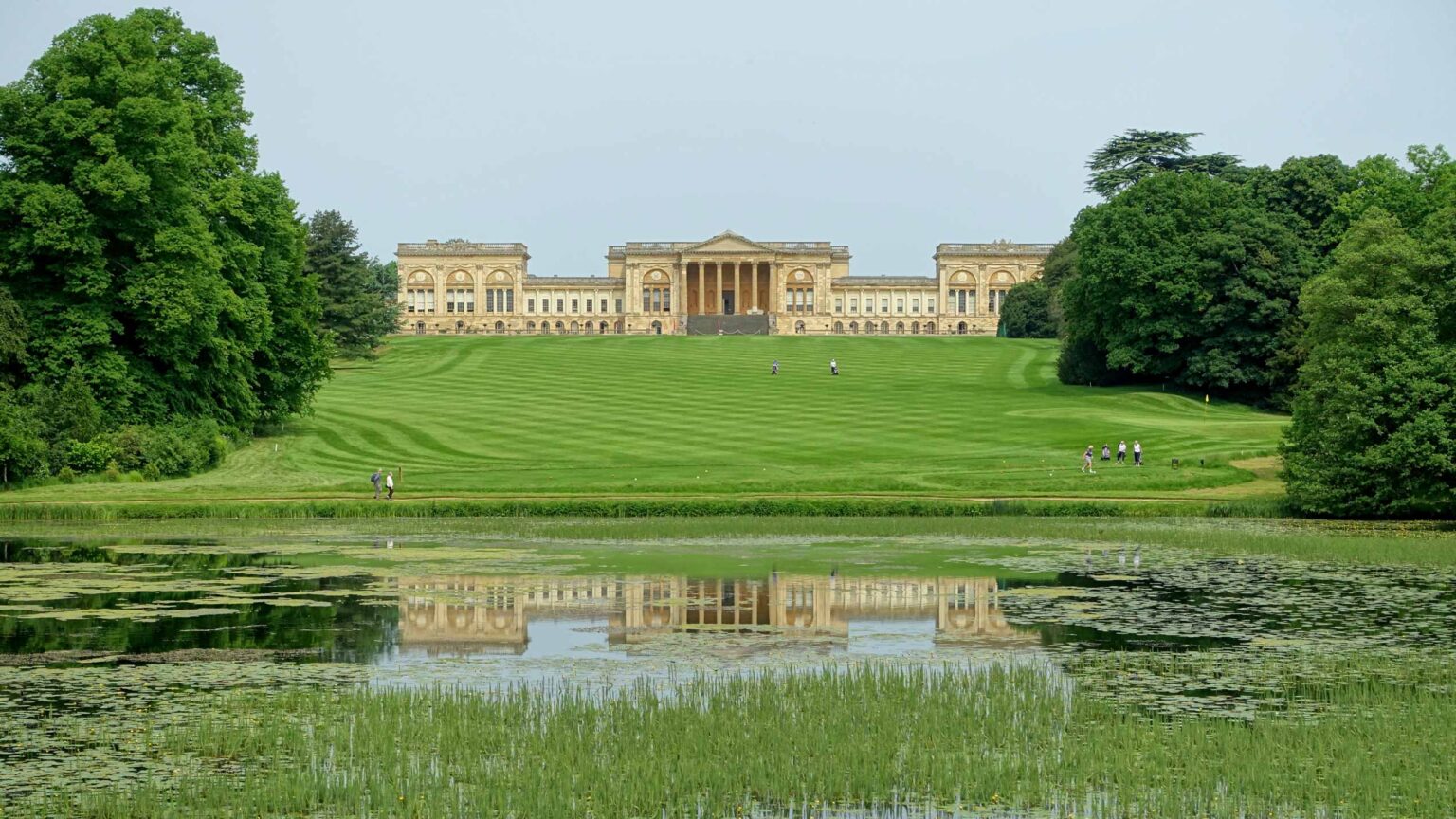
Formal garden styles that were initially exclusive to estates and palaces of the landed nobility gradually transitioned into more common usage in parks, public spaces, and private residences.
This shift occurred in the 18th and 19th centuries, when the principles of formal garden design became more accessible and desirable to a wider audience. As the influence of landscape designers like Capability Brown and Humphry Repton spread, their ideas and designs were adapted to suit smaller properties and urban environments.
The formal garden elements, such as geometric layouts, symmetrical patterns, and ornamental features, were incorporated into public parks, town squares, and even smaller private gardens, allowing people from different social backgrounds to enjoy the beauty and grandeur of formal garden design.
Tredegar House Gardens, Wales.
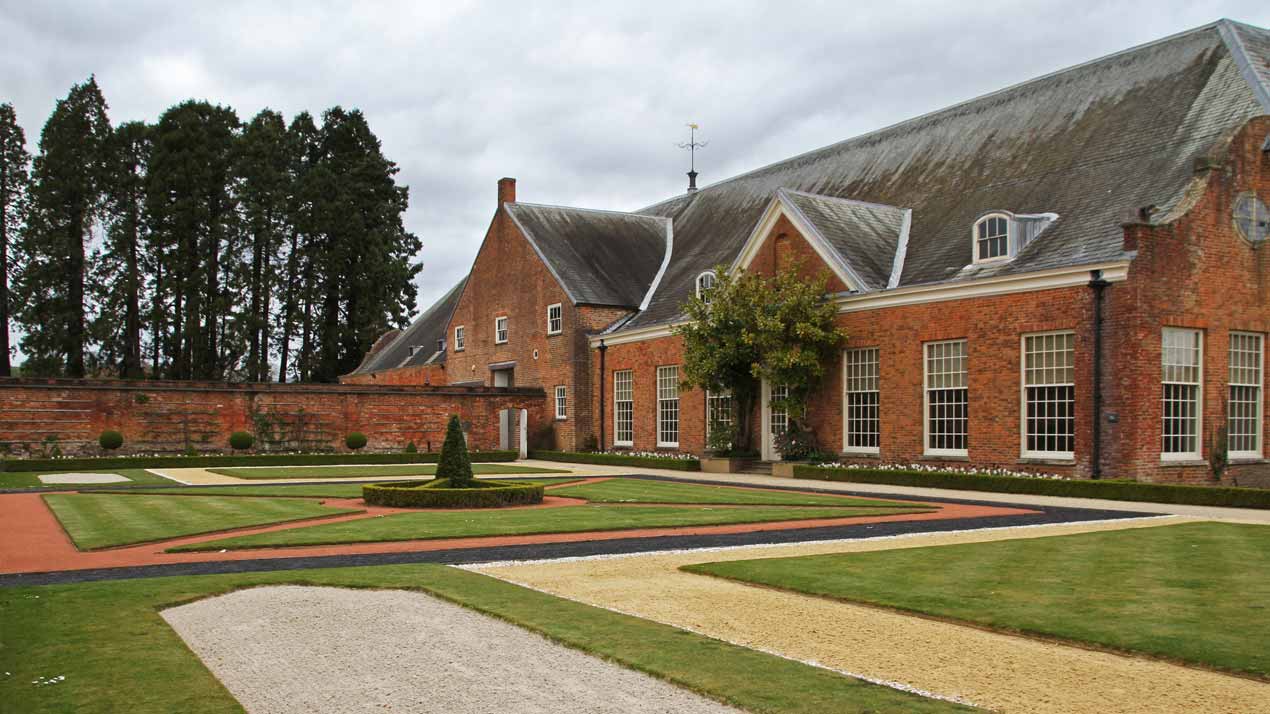
British (English) School; A View of a House and Formal Gardens; National Trust, Packwood House.
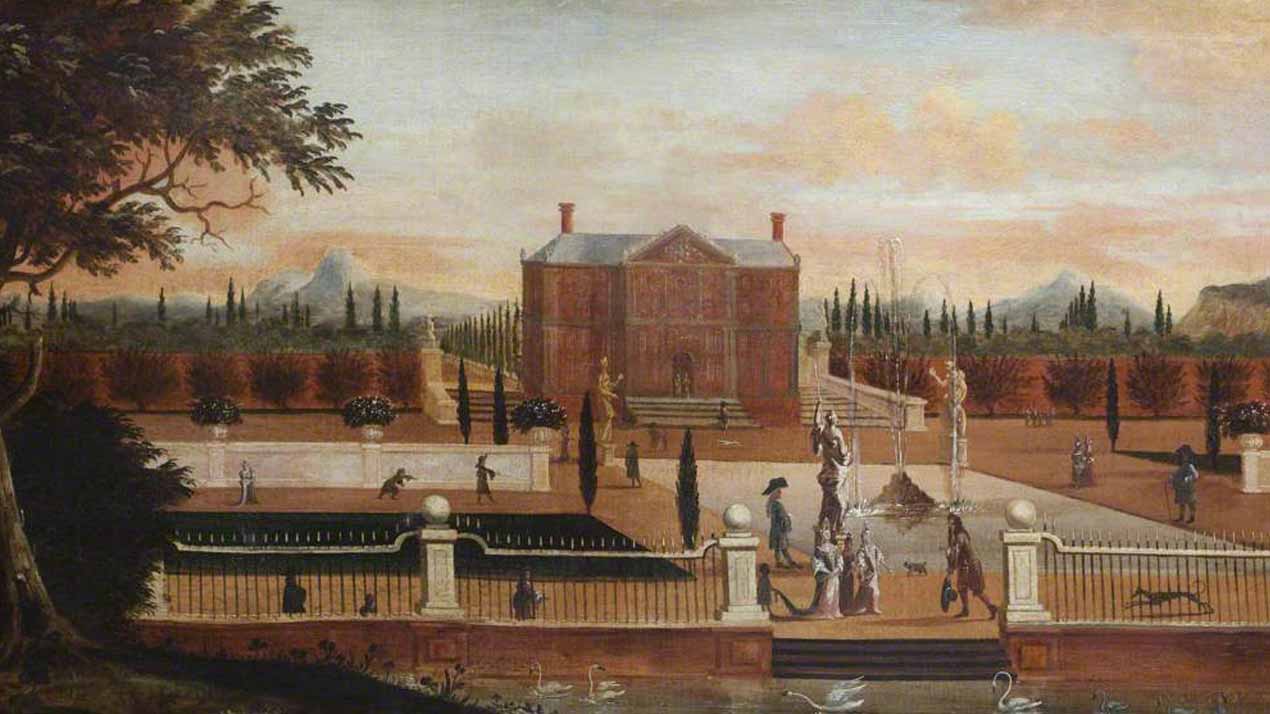
Formal gardens continued to evolve throughout the 19th and 20th centuries, with influences from different cultures and design movements. Today, formal gardens remain popular around the world, from grand palace gardens to smaller, more intimate spaces.
What elements make a formal garden?
Before you start planning a formal garden, let us give you a breakdown of the characteristics and elements that make them up. This should then allow you to select those that align best with your tastes and hopefully help inspire your garden design ideas.
Topiary
Formal gardens often incorporate topiary, which involves trimming trees and shrubs into shapes such as balls, cones and spirals. Topiary is commonly seen in formal gardens and landscapes, where it adds a touch of elegance, structure, and artistry to the overall design. They can transform ordinary shrubs, trees, or hedges into living sculptures, creating a sense of order and refinement.
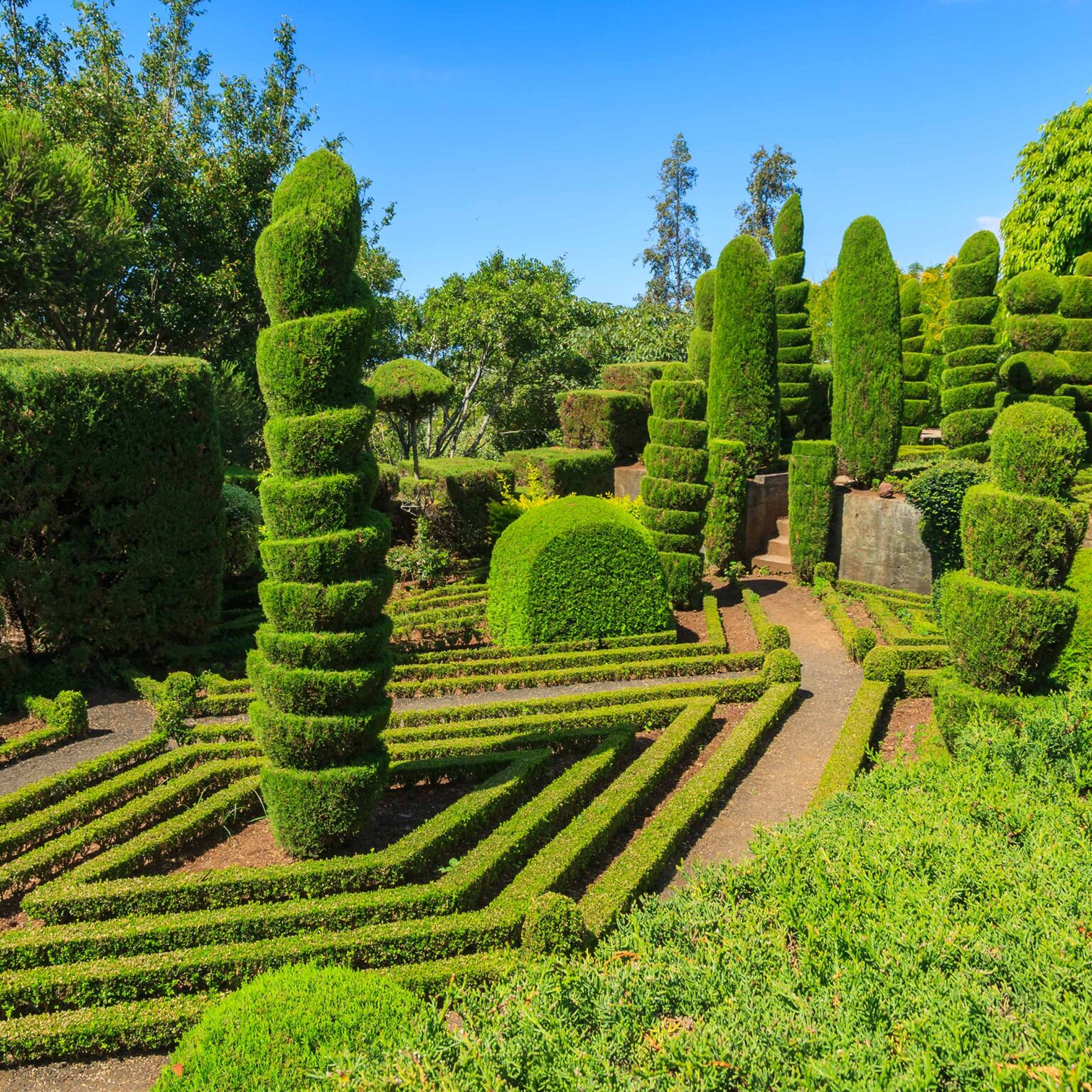
Statues
Formal gardens often feature a variety of statues that contribute to their aesthetic appeal and provide focal points within the landscape. These statues are usually made from durable materials such as stone, marble, bronze, or cast iron. They can depict various subjects, including historical figures, mythological characters, allegorical representations, and classical motifs.
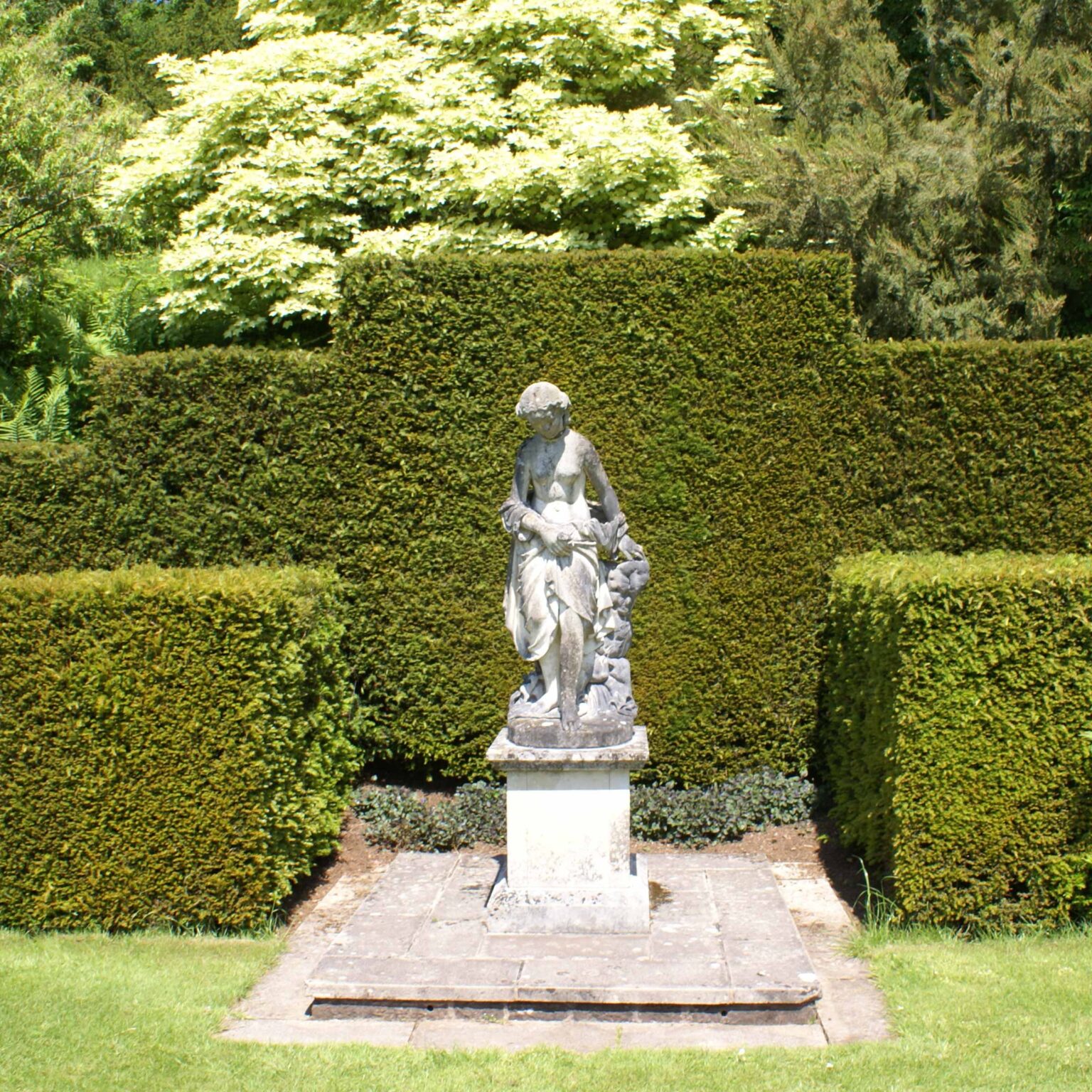
Fountains
Fountains are a common feature in formal gardens and are often strategically placed as central focal points or integrated into symmetrical patterns. They allow the garden designer to impart an architectural style, visual interest, and sensory interest from the sound, movement and reflective light they can provide. Whether the fountain is providing dramatic spouts or more tranquil and sedate overflowing cascades, they have an inherent attraction that draws us to them, making them perfect as formal garden features.
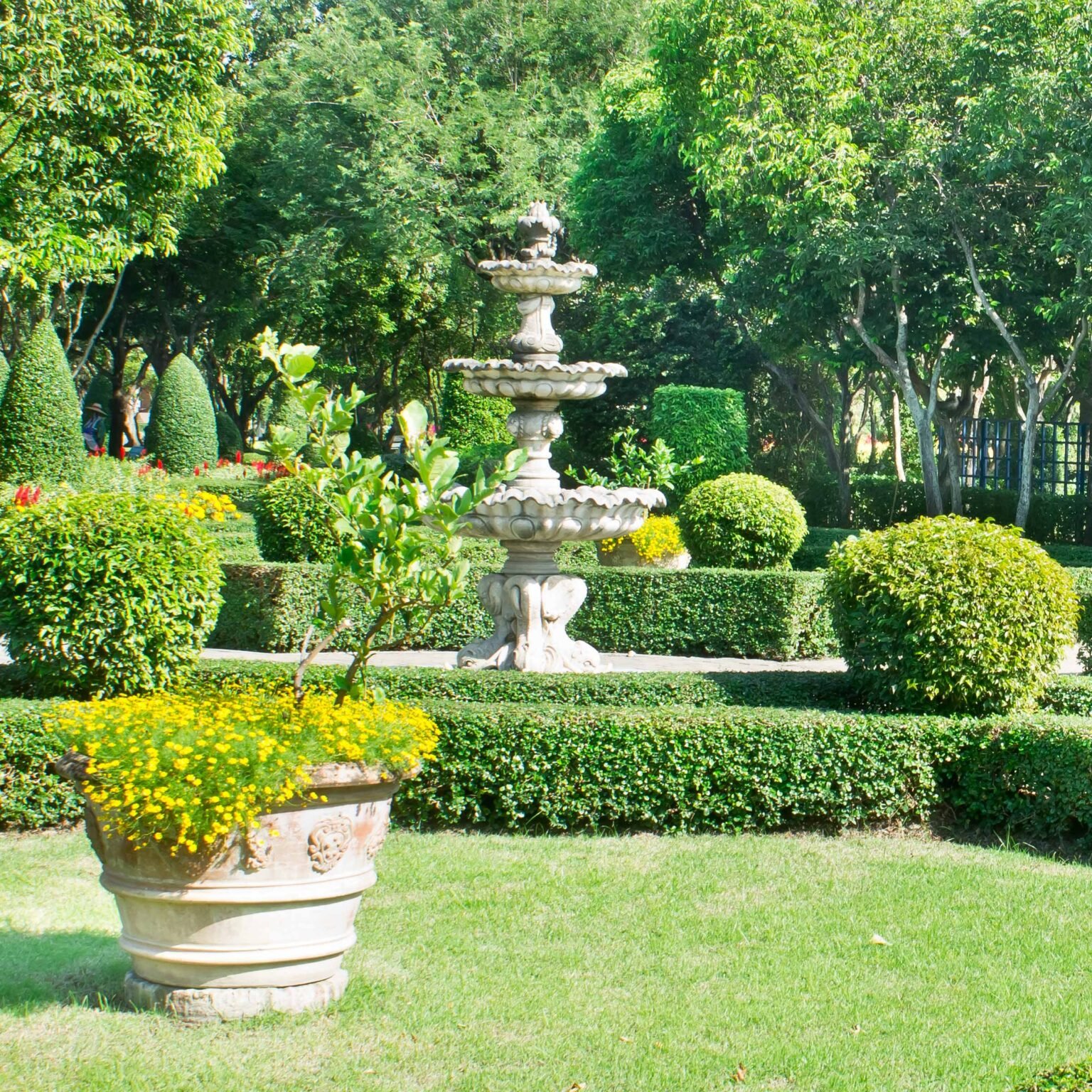
Balustrades
Balustrades are architectural features commonly found in formal gardens. They serve both functional and aesthetic purposes, providing a hand-rail and edge to garden steps, whilst allowing the garden designer to display an architectural style. Consequently, they are often used to help set the character of the garden, providing a grandeur, elegance and sophistication to the landscape design.
Balustrades are usually constructed from materials such as stone, or metal. They consist of a series of upright posts (balusters), intersected with newel posts (main-columns) at the top, bottom, and landing levels, and topped with a handrail.
As well as for side-rails on steps, in formal gardens, balustrades are often used like pony, knee and parapet walls to define and separate different areas, create visual interest, and provide a sense of structure.
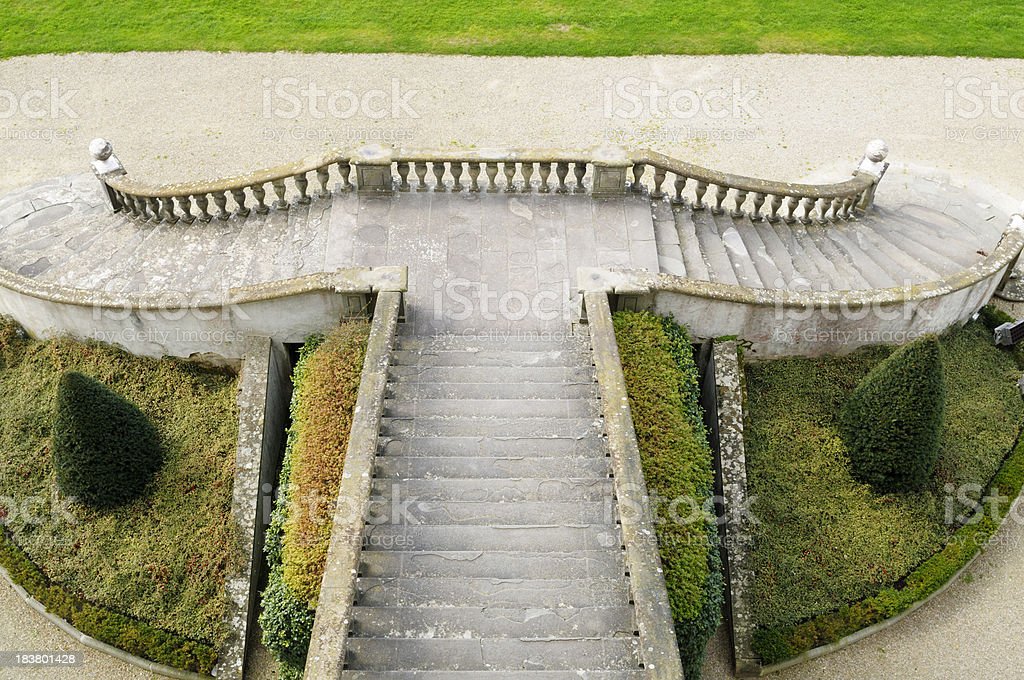
Geometric Layouts
Formal gardens are known for their precise and symmetrical layouts. They often include geometric shapes such as squares and rectangles.
Symmetry is key, with pathways, hedges, and flower beds mirroring each other. Popular geometric patterns include parterres, knot gardens, and maze-like labyrinths.
The precise arrangement of plants and hardscape elements creates balance and harmony. Geometric layouts evoke precision and order to formal garden enthusiasts.
Whether conscious or subconscious, one of the notions behind the use of geometric shapes in formal gardens, is this sense of being able to control nature, and impose order over chaos.
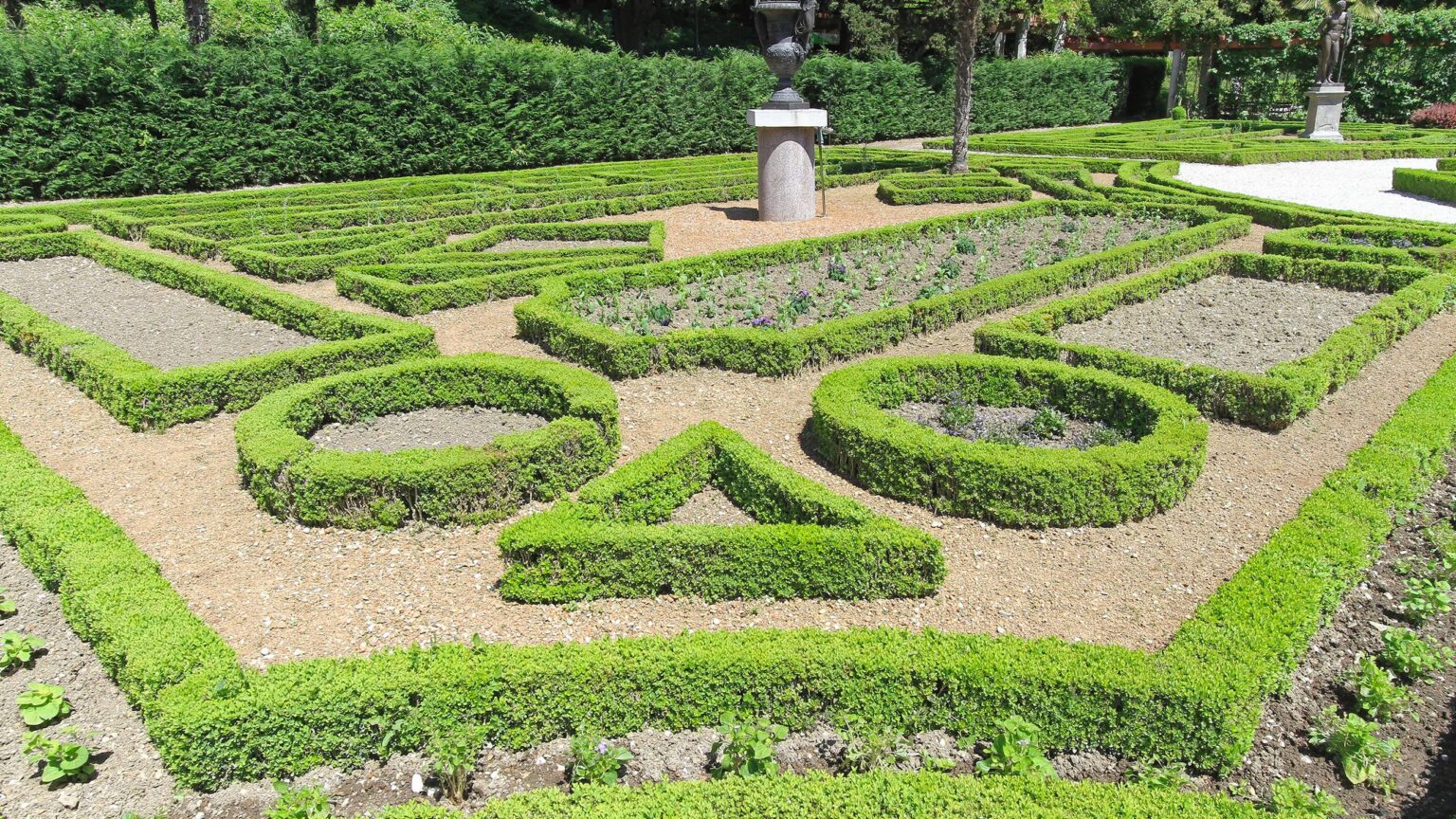
Pathways
The formal gardens feature meticulously designed pathways that embody elegance and precision. These pathways differ from more naturalistic garden designs, being straighter and acting as viewing avenues. They do not meander and disappear behind beds and borders, but are designed to be central visual guides within the desired vista.
Each step along these pathways is a deliberate progression, guiding visitors through enchanting displays of vibrant blossoms, sculpted hedges, and symmetrical arrangements. The pathways are flawlessly maintained, ensuring a smooth and comfortable stroll.
Lined with delicate borders of colourful flowers or neatly trimmed hedges, they create a sense of structure, and are designed specifically to keep people on the path. Formal garden paths invite no exploration or deviation from the guided and designed route. Their job is to ensure you experience the garden as designed, and see it as it was meant to be seen.
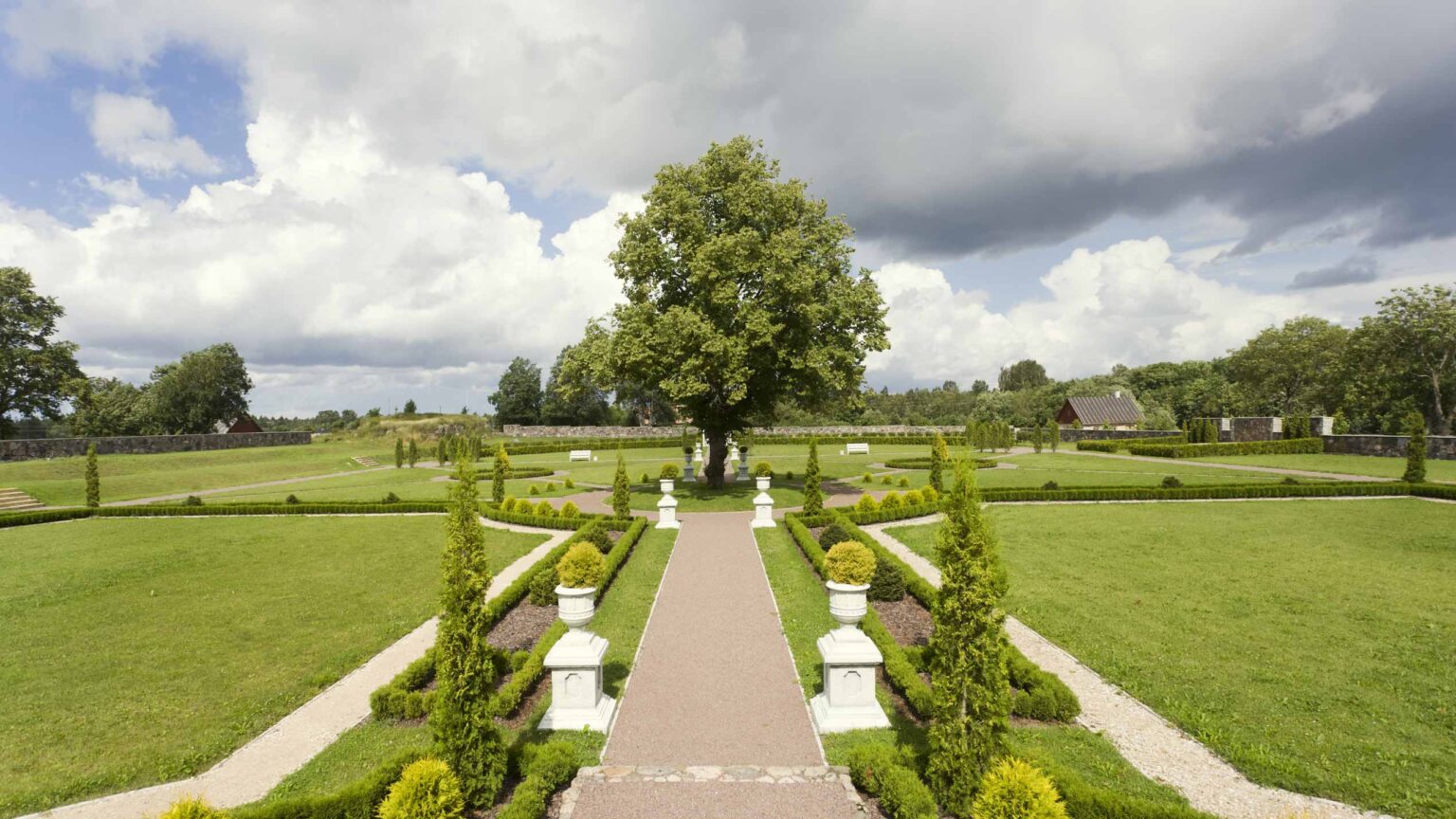
Lawns
Green, lush lawns are crafted spaces that bring vibrant blocks of colour to the garden. The larger the lawn, the more
magnificence. They also have a calming, tranquil character that lends harmony and ease to gardens.
Lawn’s function in formal gardens is multifaceted. Firstly, the lawn serves as a clean and visually appealing backdrop, providing a sense of order and balance. It offers a calm and serene environment, promoting relaxation and contemplation. The even expanse of grass also acts as a space for various activities such as gatherings, outdoor games, and leisure walks. Lawns are fantastic to fill space between focal points in the grand design of formal gardens.
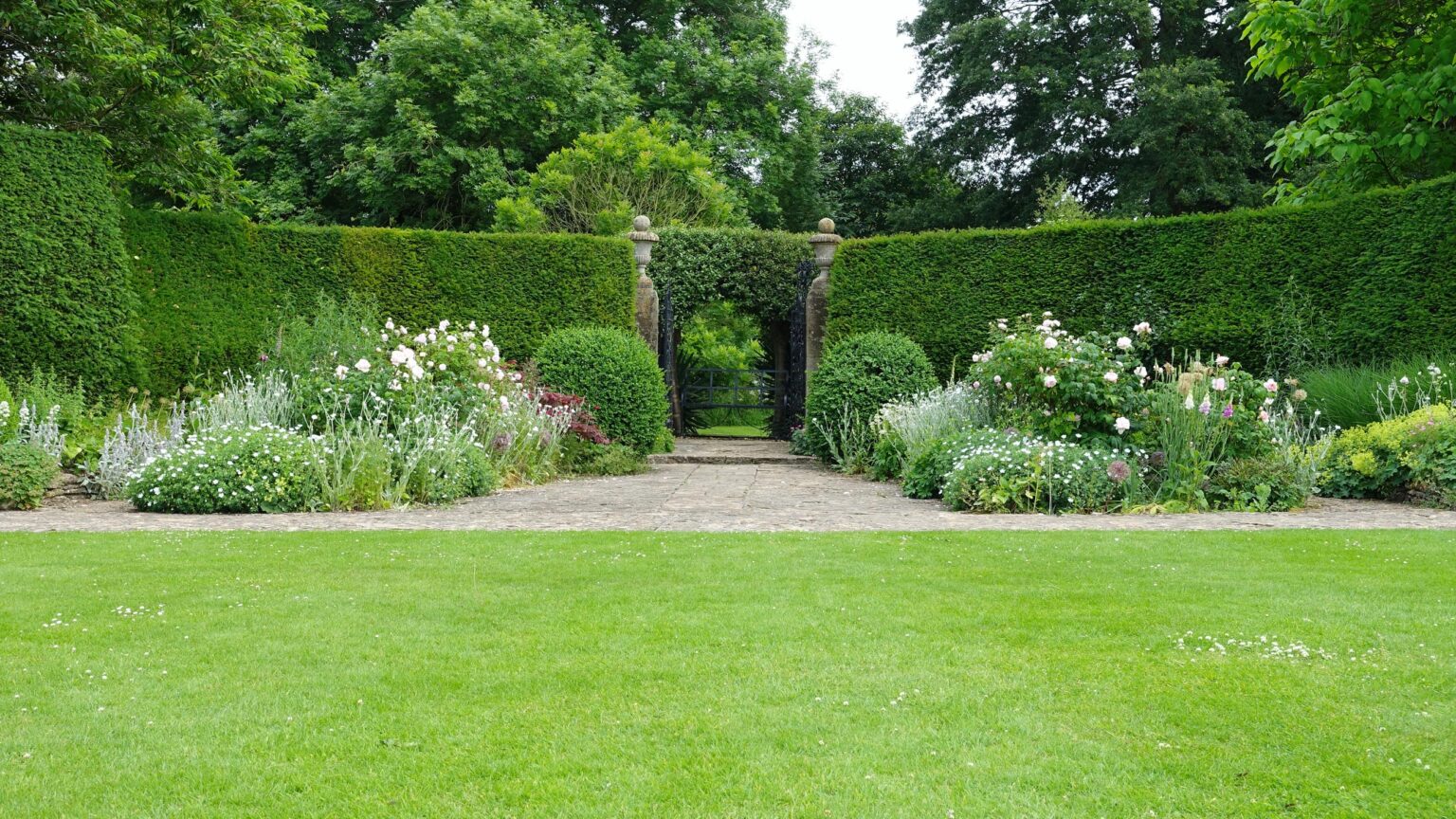
Steps
In formal gardens, outdoor steps are usually made of durable and aesthetically pleasing materials such as natural stone (sandstone, limestone, marble, travertine, granite and slate being more common).
Steps are generally made of four major components:
- steps
- lifts
- balustrades
- newel-posts.
Often overlooked when it comes to key garden design decisions, lifts need to be considered. Lifts are the both the measurement of vertical height between each step, and the physical material used on the vertical face of each step. Because, the lifts are the most visible elements seen when looking toward a set of stair or steps, your choice of materials will often set the architectural tone and style. Smooth, honed stone or concrete will present a more ordered and formal appearance.
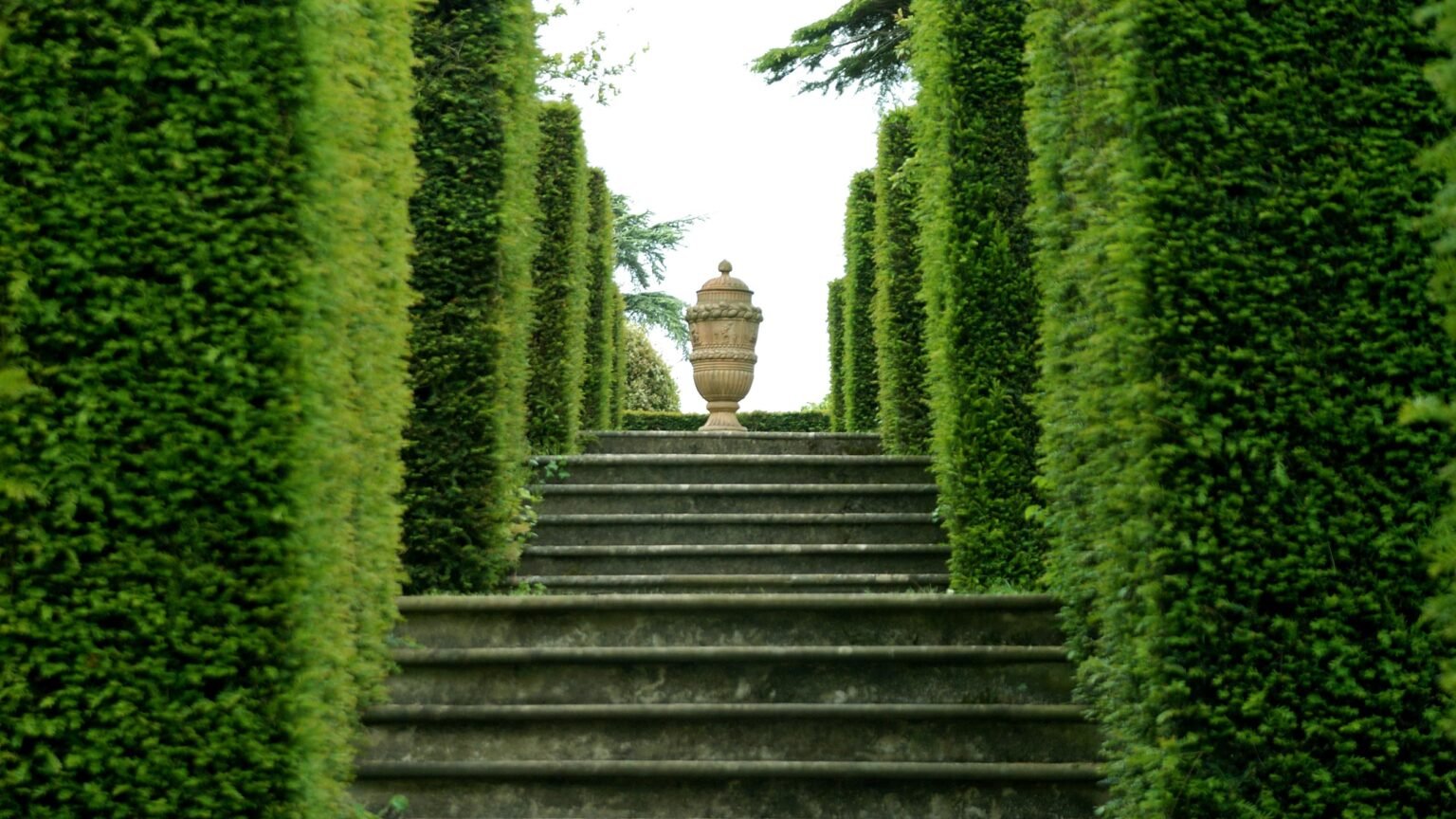
Paving
Paving plays a crucial role in formal gardens. Its importance lies in its ability to provide structure and organisation to the overall design.
Paved pathways create defined lines and symmetry, guiding visitors through the garden and highlights its key features. Paving also adds a sense of style and intensifies the formal aesthetic.
It also serves a more practical role, allowing easy access to different areas, whilst protecting delicate plants and lawns from excessive foot traffic, and ensuring pedestrians follow determined routes.
Furthermore, paving enables the inclusion of seating areas, focal points, and water features, magnifying the garden’s functionality and aesthetic appeal.
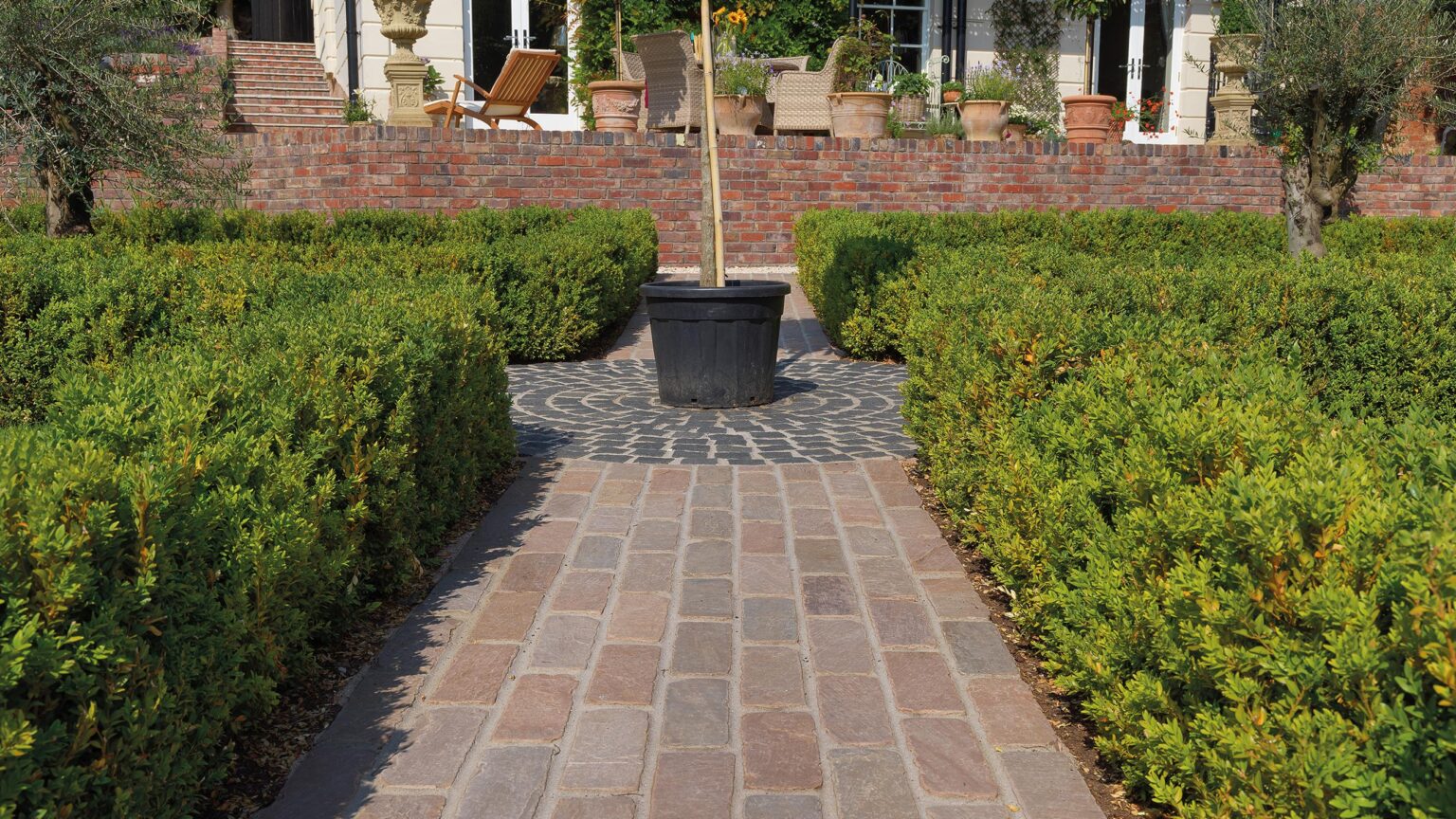
Planters
These decorative containers are used to hold and showcase various plants, adding grace and structure to the landscape. They have a rich history dating back to ancient civilisations, such as the elaborate terracotta planters of Ancient Egypt and the ornate stone urns of Ancient Greece and Rome.
Throughout the centuries, planters evolved in design and materials, with styles ranging from classical and symmetrical to geometric and intricate. Planters are strategically placed to create focal points, frame pathways, and enhance the overall aesthetic, embodying the timeless beauty and meticulous craftsmanship that define the flawlessly designed outdoor spaces.
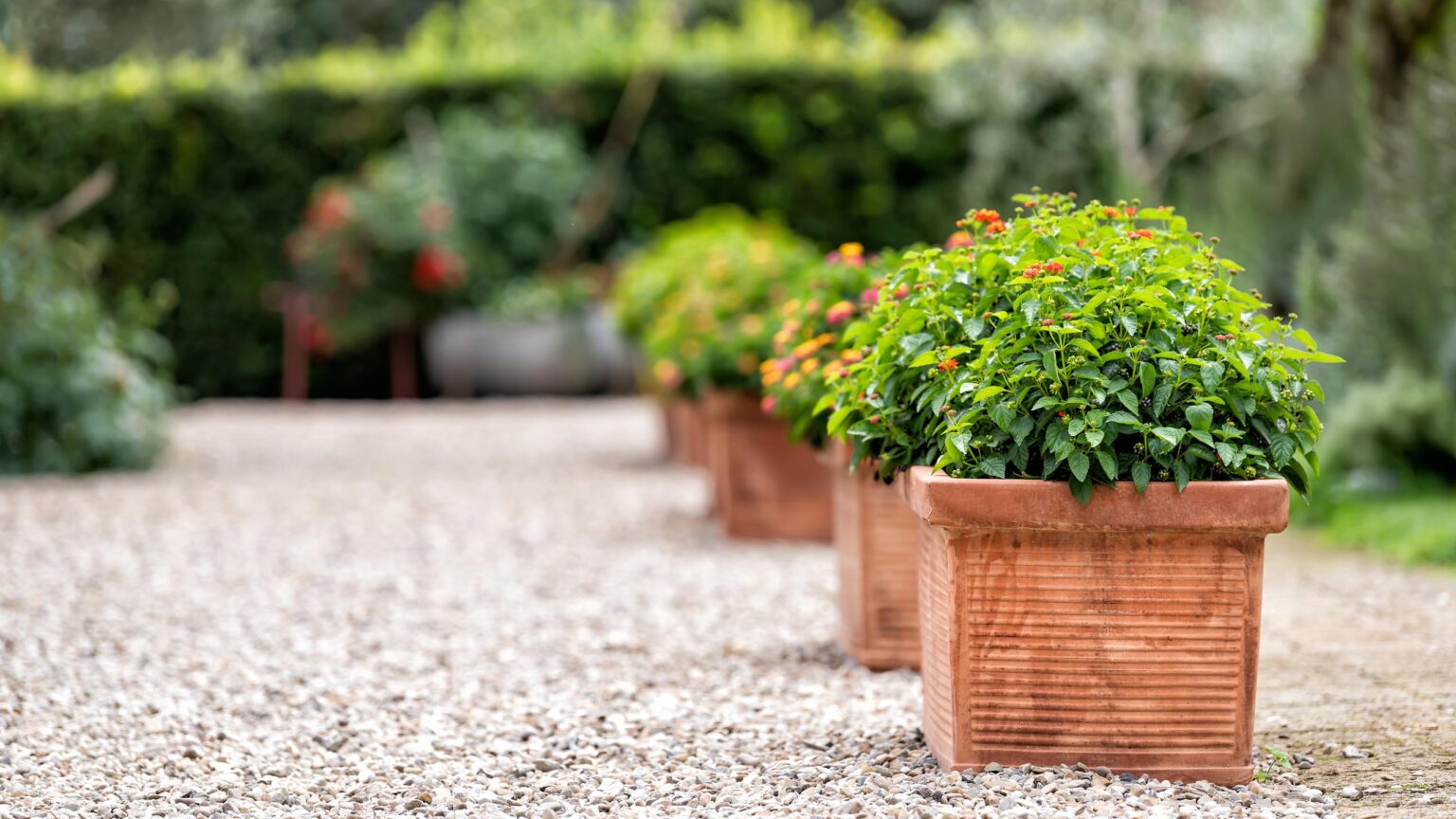
Edges & Borders
Borders in formal gardens refer to the defined boundaries or partitions that separate different elements within the garden, such as pathways, flower beds, lawns, and planters. They can be created using various materials, including hedges, low walls, raised beds, or edging stones (often laid in decorative patterns).
Edging plays a crucial role in formal gardens for several reasons. Firstly, they provide structure and order, helping to create a sense of balance and symmetry in the overall design. They define different areas, establishing clear lines and boundaries that contribute to the formal aesthetic.
Secondly, edging helps to maintain and control the growth of plants and define their boundaries. They prevent plants from encroaching on other areas, keeping them contained and organised within their designated spaces. This allows for easier maintenance and ensures that the garden retains its desired shape and appearance.
Furthermore, edging in formal gardens contributes to visual clarity and enhances the garden’s overall presentation by creating clean lines and highlighting the architectural features, plantings, and focal points.
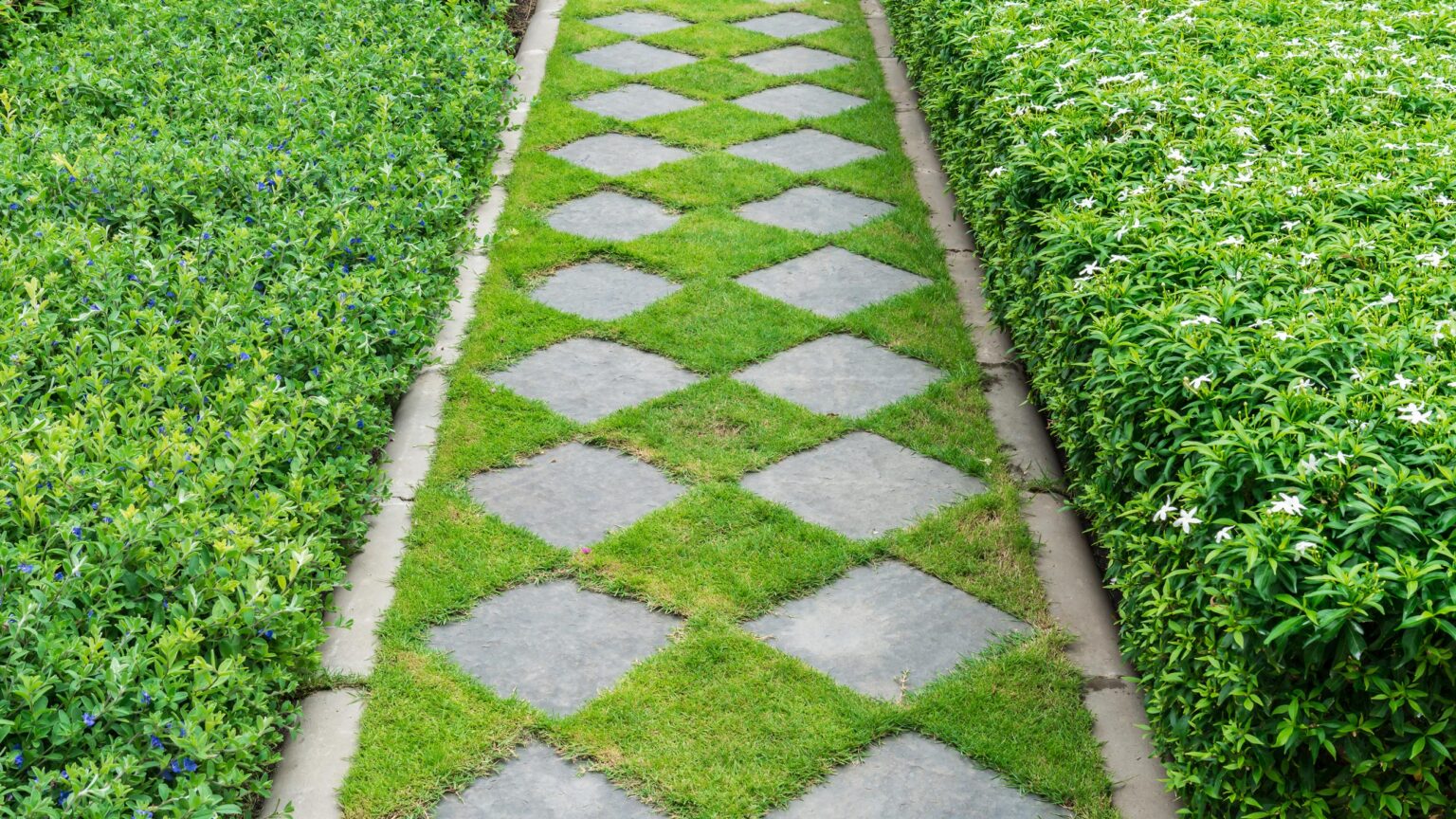
Using & Manipulating Natural Sunlight
As sunlight filters through the garden’s scrupulously designed pathways, parterres, and flowerbeds, it casts intricate patterns and highlights the garden’s sophisticated details. This interplay of light and shadows brings depth and dimension to the landscape, emphasizing the symmetry and geometric precision that are hallmarks of formal garden design.
Throughout history, gardeners and landscape architects have utilised the natural radiance of sunbeams to create inspiring displays, elevating the garden’s allure and captivating visitors with their exquisite charm. And the sun traversing in the sky, so the sunbeams play and interact with elements in the garden.
So, be aware of the path of the sun and how and where it hits your garden. This will allow you to design and plant a formal garden that utilised sunlight to heighten the garden experience.
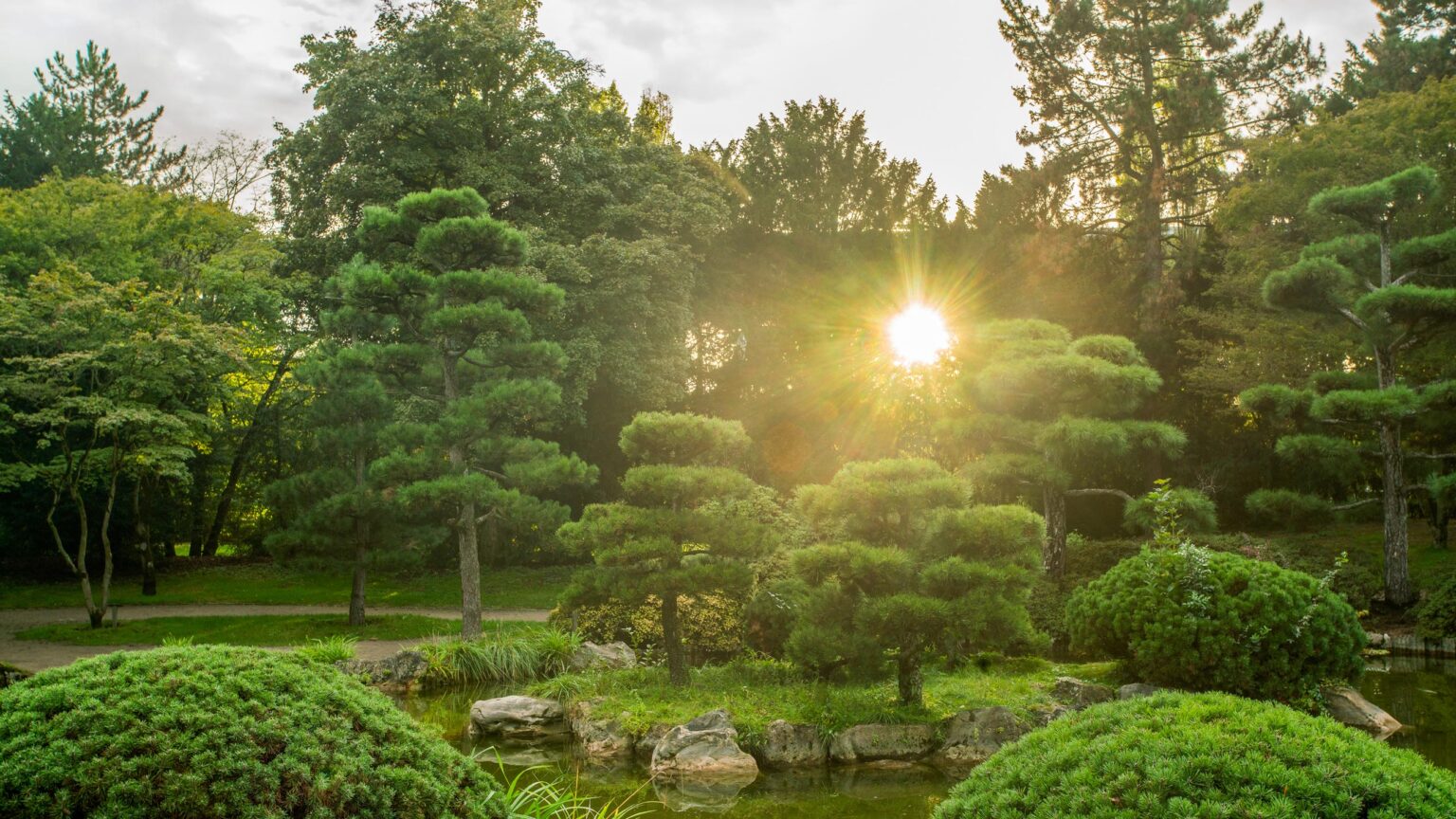
Columns and Entablatures
Columns and entablatures are architectural elements commonly used in formal gardens to add structure, elegance, and a sense of grandeur.
Columns are vertical, cylindrical or rectangular pillars that support the entablature or other architectural features. They are typically made of stone, marble, or concrete. Classical column styles include Doric, Ionic, Corinthian, Tuscan, Composite and Roman.
Columns serve both functional and aesthetic purposes in formal gardens. They provide support for overhead structures like pergolas or trellises, creating shaded areas or defining pathways. Additionally, they serve as decorative elements, adding visual interest and a sense of scale to the garden design.
Entablatures, are horizontal structures that rest on top of columns. They consist of three parts: the architrave, frieze and cornice.
The architrave is the bottom section, the frieze is the middle portion usually decorated with relief sculptures or ornamental motifs, and the cornice is the uppermost part that often features complex mouldings.
Entablatures contribute to the overall architectural style of the garden and can be found as freestanding elements or on structures like pavilions, gazebos, or formal entrances.
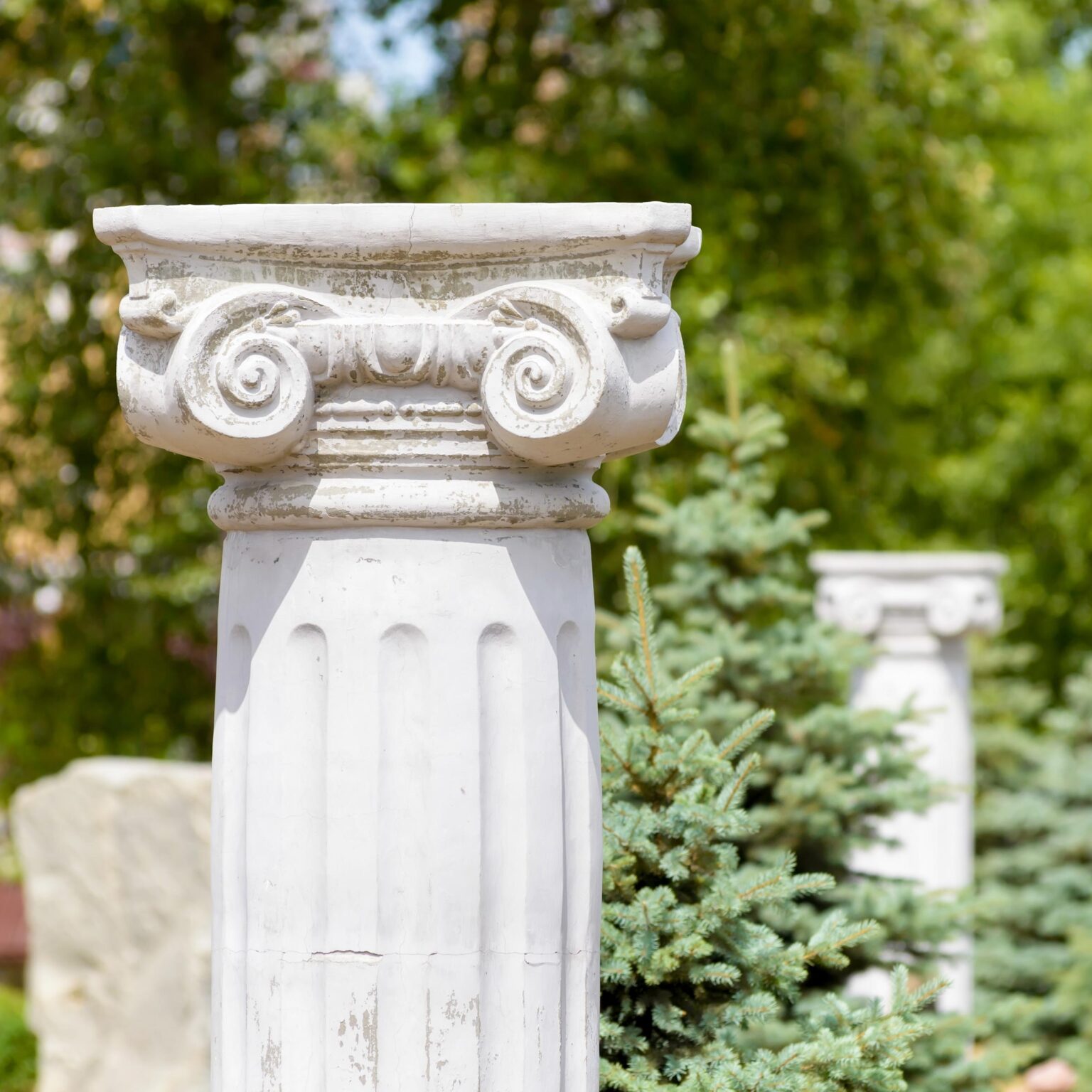
High Hedging
High hedging in formal gardens refers to deliberate planting and shaping of shrubs or trees to create structured and defined boundaries or decorative elements. It has a long historical context, dating back to Ancient civilizations like the Persians and Romans, who used hedging to mark spaces and provide privacy. In Renaissance Europe, formal gardens emerged as symbols of wealth and power, featuring precisely trimmed hedges in geometric shapes like mazes or parterres.
High-hedging is commonly used in two ways within a formal garden:
- As a backdrop on the boundary of the garden
- As walls to separate areas or create avenues within the garden.
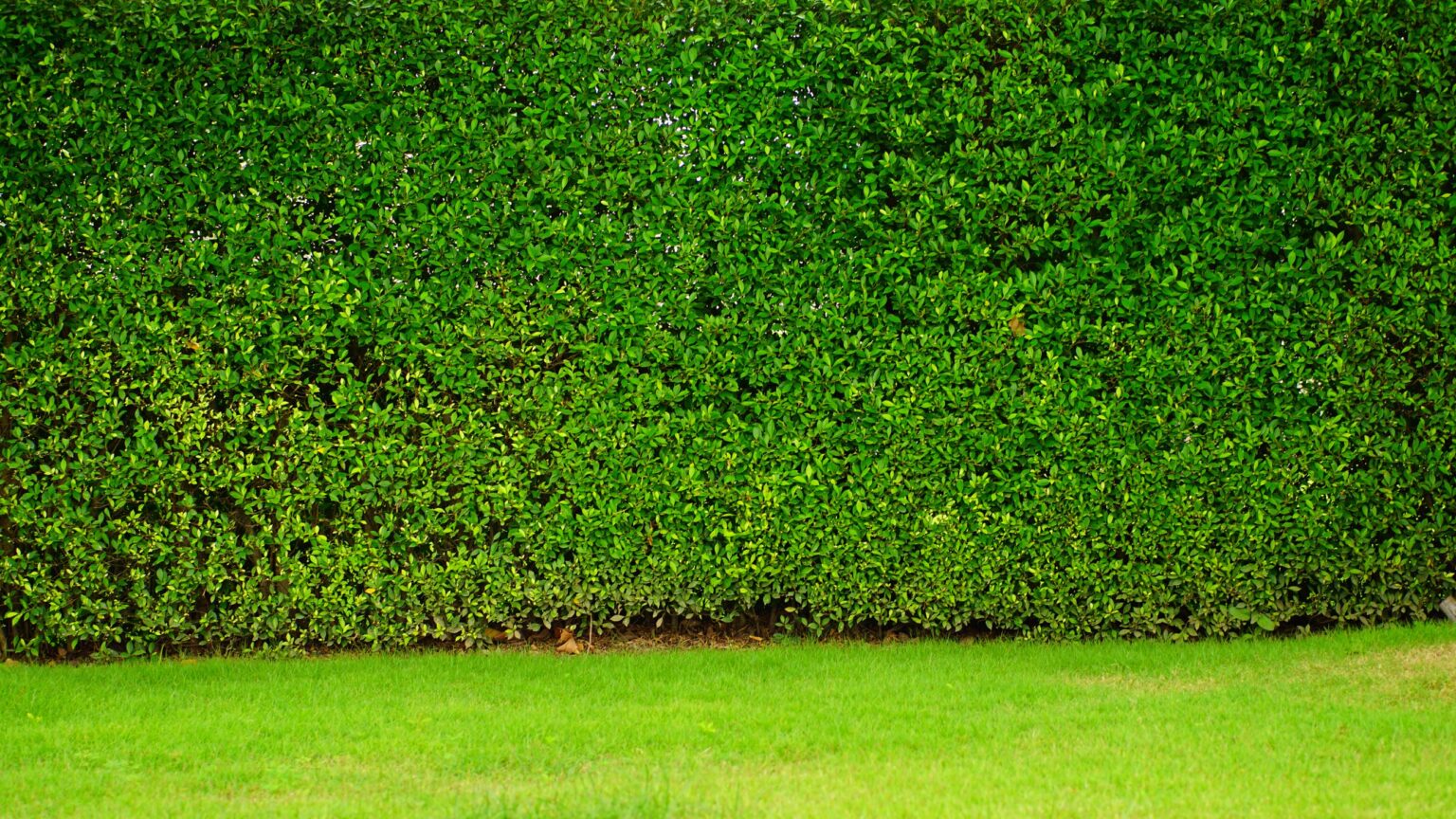
Plinths & Pedestals
Plinths play a crucial part in formal gardens by providing a foundation for the display of sculptures and statues. They elevate artwork, giving it prominence within the garden setting, whilst re-affirming an architectural style.
Plinths contribute to the overall aesthetic and architectural composition to a formal garden. They add structure and balance to the carefully planned layout, creating focal points and defining spacial relationships.
Plinths are often strategically positioned at key intersections or along axial paths to draw the eye and create a sense of harmony. They also provide a sense of scale, enabling the sculptures to stand out against the surrounding greenery and landscape features.
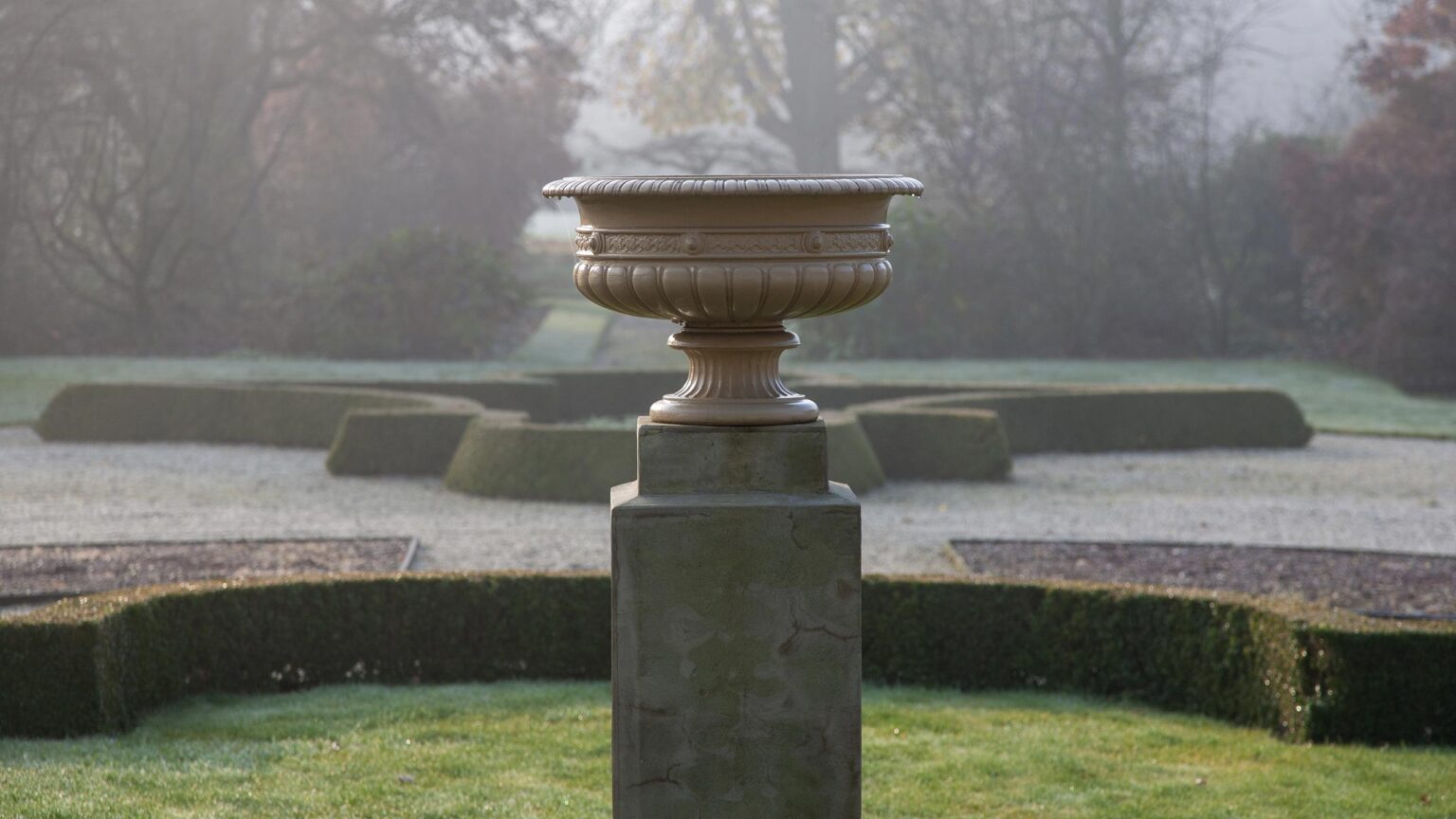
Retaining Walls
A retaining wall in a garden is a structural feature designed to hold back soil and create distinct levels or terraces within the landscape. Typically made of durable materials such as stone, brick, or concrete, it serves both functional and aesthetic purposes.
In formal gardens, the size and visual prominence of retaining walls means that they have a significant influence on the overall style and aesthetics of the garden. Consequently, these walls are often meticulously crafted to maintain a clean and symmetrical appearance, completing the overall design and providing a sense of order and organisation to the space.
Often their facades can be used for climbing plants, espaliers or as a contrasting backdrop for ornamental planters, pots and trees.
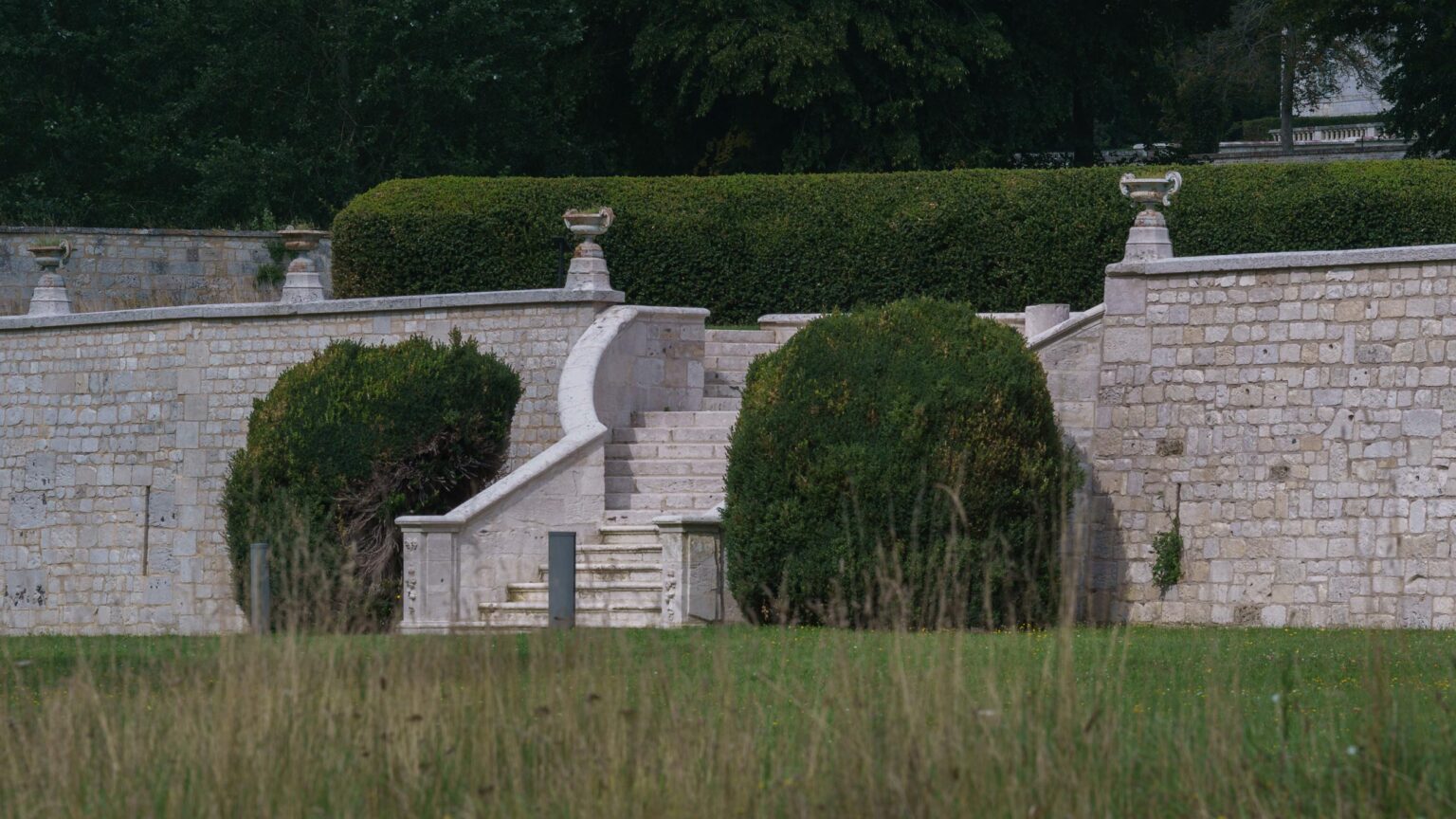
Ha-ha Walls
If you happen to be an enormously wealthy landowner with a large country estate, then you will likely need to contemplate a ha-ha!
Ha-ha walls, also known as sunken fences, are architectural features commonly found in formal gardens of stately homes. The term ha-ha is derived from the French word “ha-ha”, which means an exclamation of surprise.
A ha-ha wall is a type of boundary wall or fence that is designed to create a seamless and uninterrupted view across a landscape when viewed from the house looking out, but presenting a moat and wall to those (especially deer) when approaching the house.
It consists of a trench/moat and wall that acts as a hidden barrier, typically made of brick or stone. The wall is built into the ground, creating s vertical face on one side and a sloping grassy bank on the other side. The trench allows the wall to perfectly blend into the surrounding landscape when viewed from within the boundary of the property.
The primary purpose of ha-ha walls in formal gardens is to prevent the incursion of wildlife, especially deer, from entering the garden, whilst eschewing a visual barrier that might block the view out of the house.
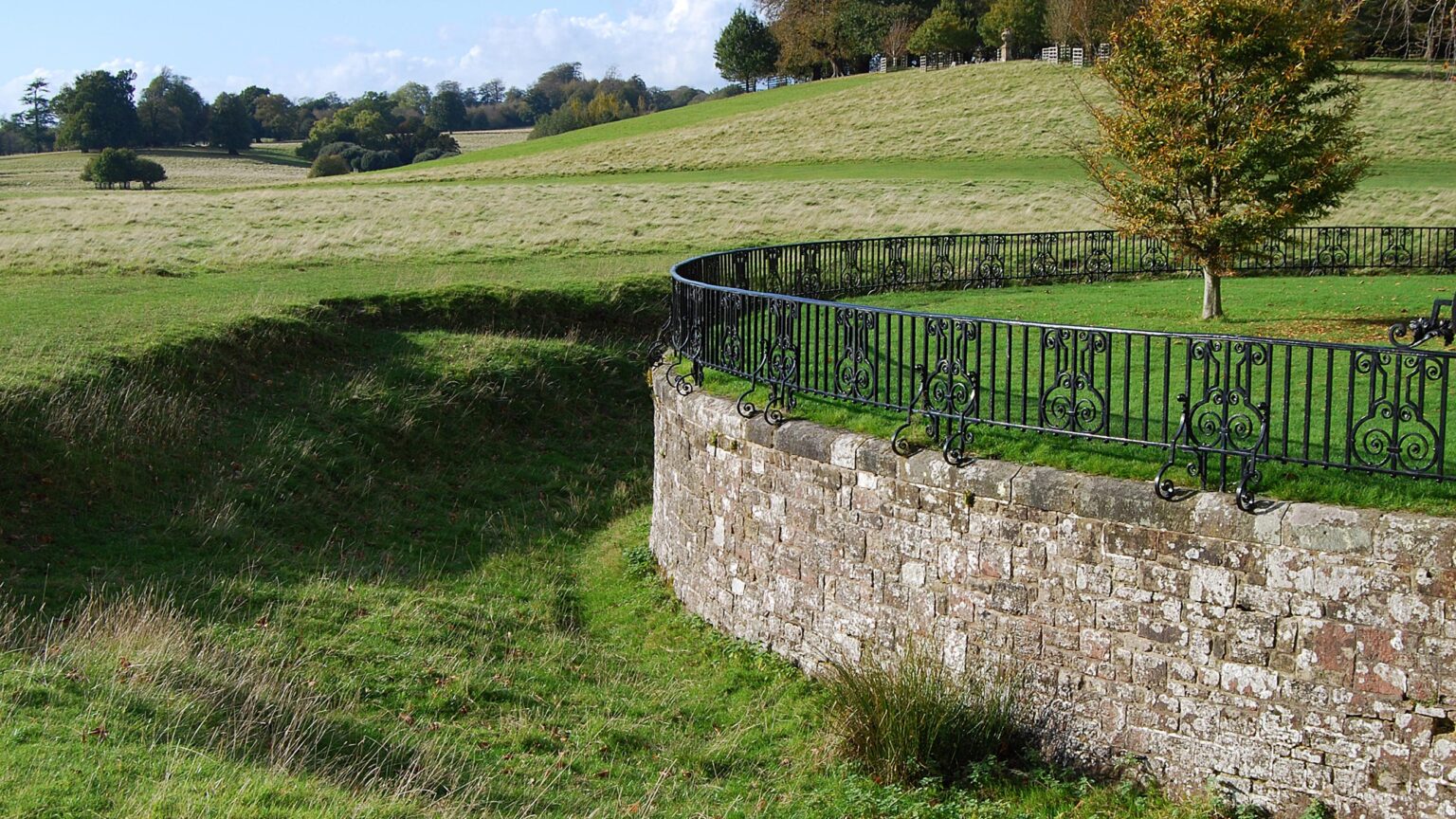
Follies, Temples, Summerhouse & Belvedere
Follies, temples, summerhouses, and belvederes are architectural elements that can be thoughtfully incorporated into formal garden design, adding a sense of charm, focal points, and functional spaces.
- Follies, whimsical structures often with no practical purpose, can create visual interest and intrigue.
- Temples, inspired by classical architecture, offer a sense of grandeur and can serve as focal points within the garden.
- Summerhouses provide cosy retreats for relaxation and enjoying the surroundings.
- Belvederes, typically elevated structures, offer panoramic views and serve as observation points.
These architectural features, when strategically placed and designed with attention to the garden’s style, scale, and purpose, elevate the overall aesthetic and offer unique experiences within the formal garden setting.
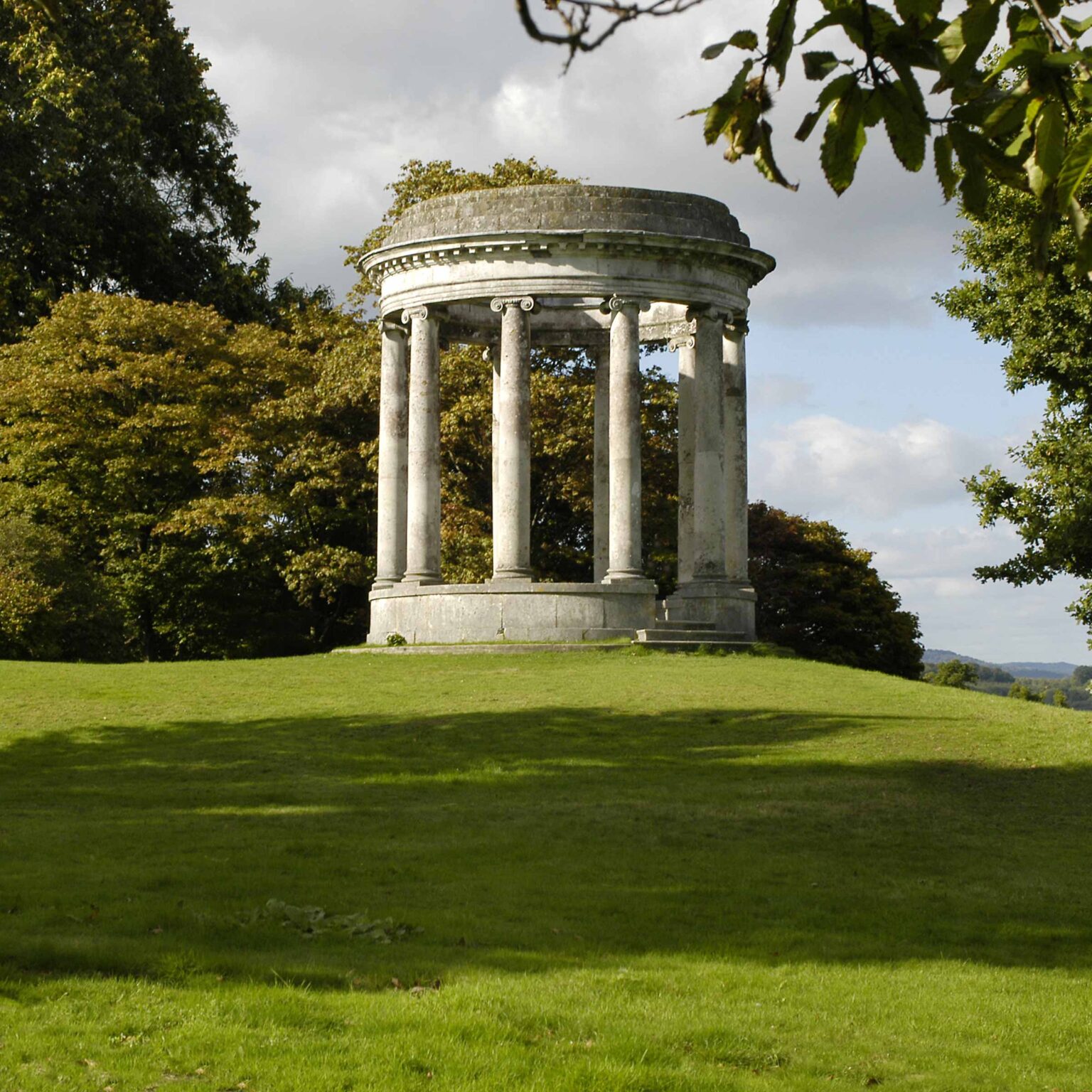
Gateways & Gatehouses
Gateways and gatehouses mark the entrance, creating a sense of arrival and separation while enhancing aesthetics with decorative features.
Gateways, often adorned with ornate gates or arches, mark the transition from the outside world into the formal garden, setting the tone for the overall experience. They create a sense of arrival and provide a focal point that draws the eye.
Gatehouses, on the other hand, serve both aesthetic and practical purposes. They can house caretakers or serve as storage spaces while adding a sense of architectural elegance to the garden entrance. These elements help define the boundaries of the formal garden, adding a touch of sophistication and establishing a sense of privacy and exclusivity.
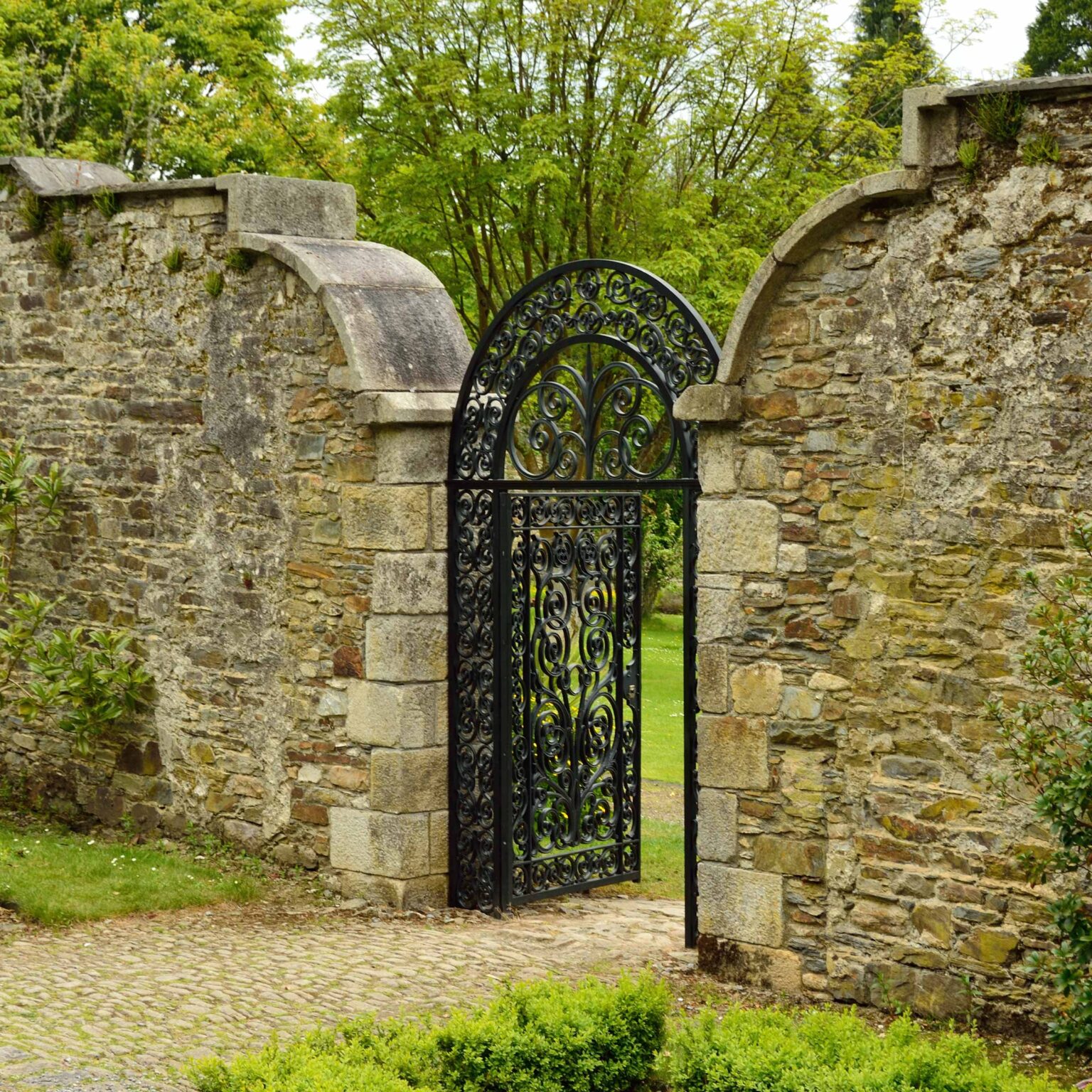
Lighting
Lighting plays a crucial role in formal gardens, accentuating their beauty and creating captivating effects. It brings enchantment and highlights plants and architectural elements, and lines pathways. Garden lights transform the ambiance and signal where the eye should ponder and be drawn at night.
Uplighting illuminates statues, fountains, and trees, emphasizing their richness and creating dramatic silhouettes.
Downlighting casts soft and gentle illumination from above, welcoming the textures and colours of plants and hardscape features.
Globe lighting’s defused light replicates the ethereal glow of moonlight, creating a romantic and serene atmosphere.
Underwater lighting adds a magical touch to ponds and water features, showcasing the interplay of light and water.
String & Fairy lighting can be used to hang along avenues or pathways and wrap around pergolas and arbours to create romantic and playful effects.
Rope lighting can be used on the underside of architectural features and steps to create ambience and draw the eye to the object.
Together, these lighting techniques add depth, charm, and magic to formal gardens, arousing a sense of wonder and stillness.
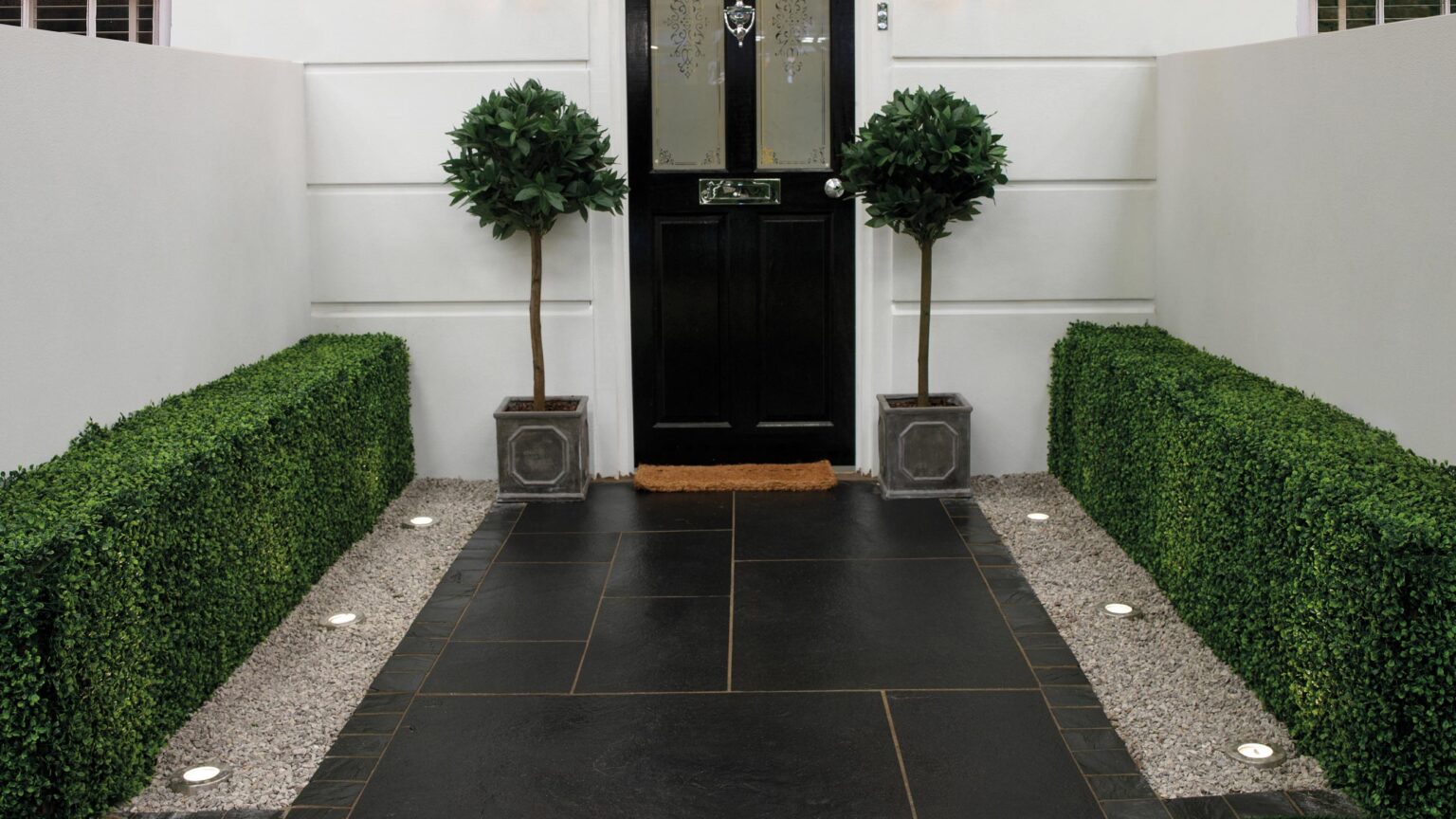
Infill Plants
Infill plants are smaller plants strategically placed within larger architectural elements of the garden design. These plants are carefully selected to complement and enhance the overall aesthetic of the garden.
Usually low-growing and neatly trimmed, infill plants fill the gaps between larger hedges, statues, or walkways, adding depth, texture, and colour to the formal landscape. They serve as decorative accents, softening the rigid lines and providing a sense of cohesion. Infill plants may include flowering perennials, ornamental grasses, compact shrubs, or ground covers, meticulously arranged to create a harmonious and visually appealing composition.
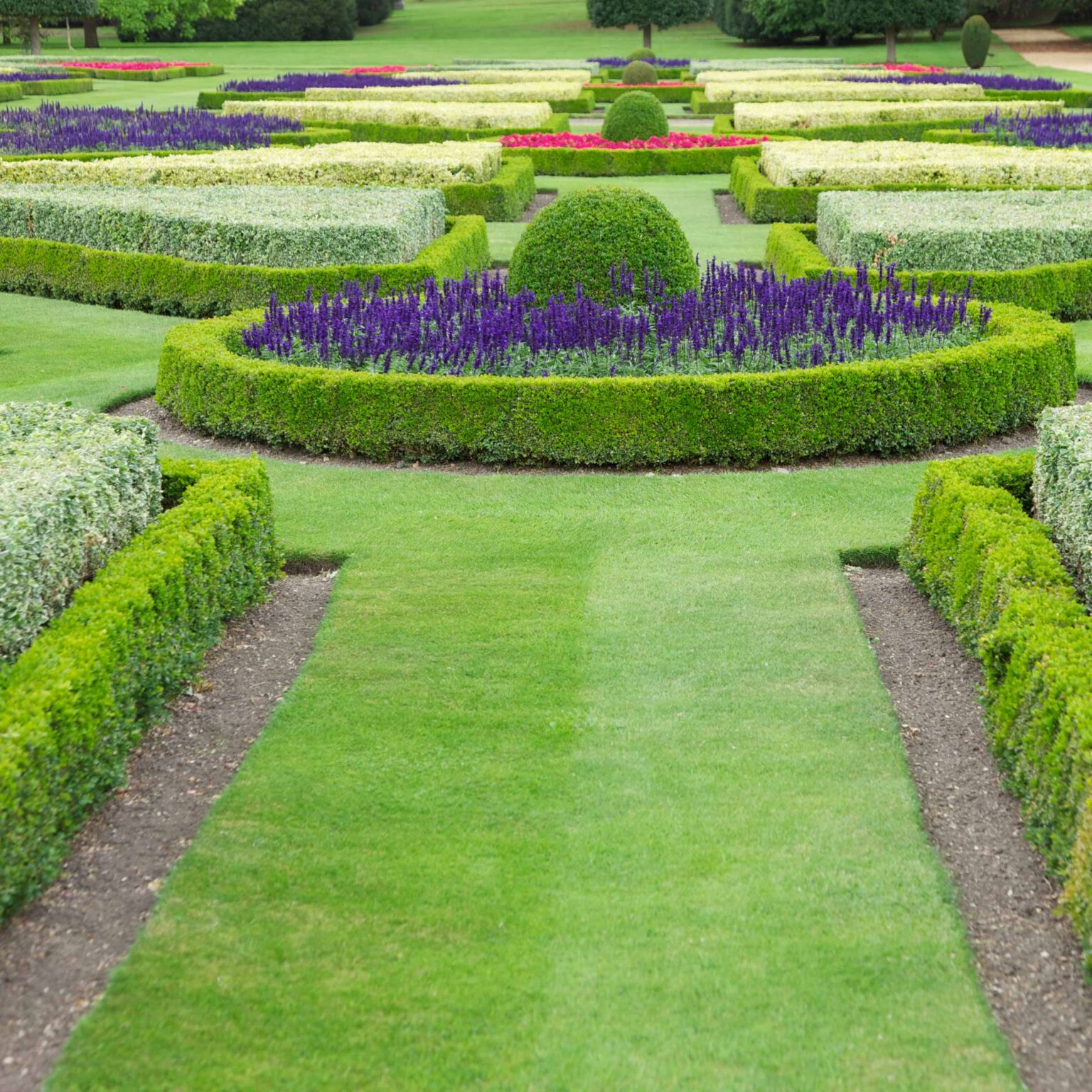
Trees Avenue
In formal gardens, trees serve as structural elements, providing shade, vertical accents, and defining boundaries. They contribute to the overall design, creating a sense of symmetry, balance, and a harmonious environment. Their lush foliage and graceful forms add beauty and tranquillity to the formal landscape.
Pollarded trees are a common type of shrub that you can find in formal gardens. They create a structured and sculptural element to a formal garden, enhancing its architectural beauty and design.
Pollarding is a pruning system that involves the removal of the upper branches of a tree, which promotes the growth of a dense head of a foliage and branches.
As well as pollarded trees, Tuscan Cypress trees and other architectural type trees, that have a natural ordered and formal appearance, are often found in formal gardens.
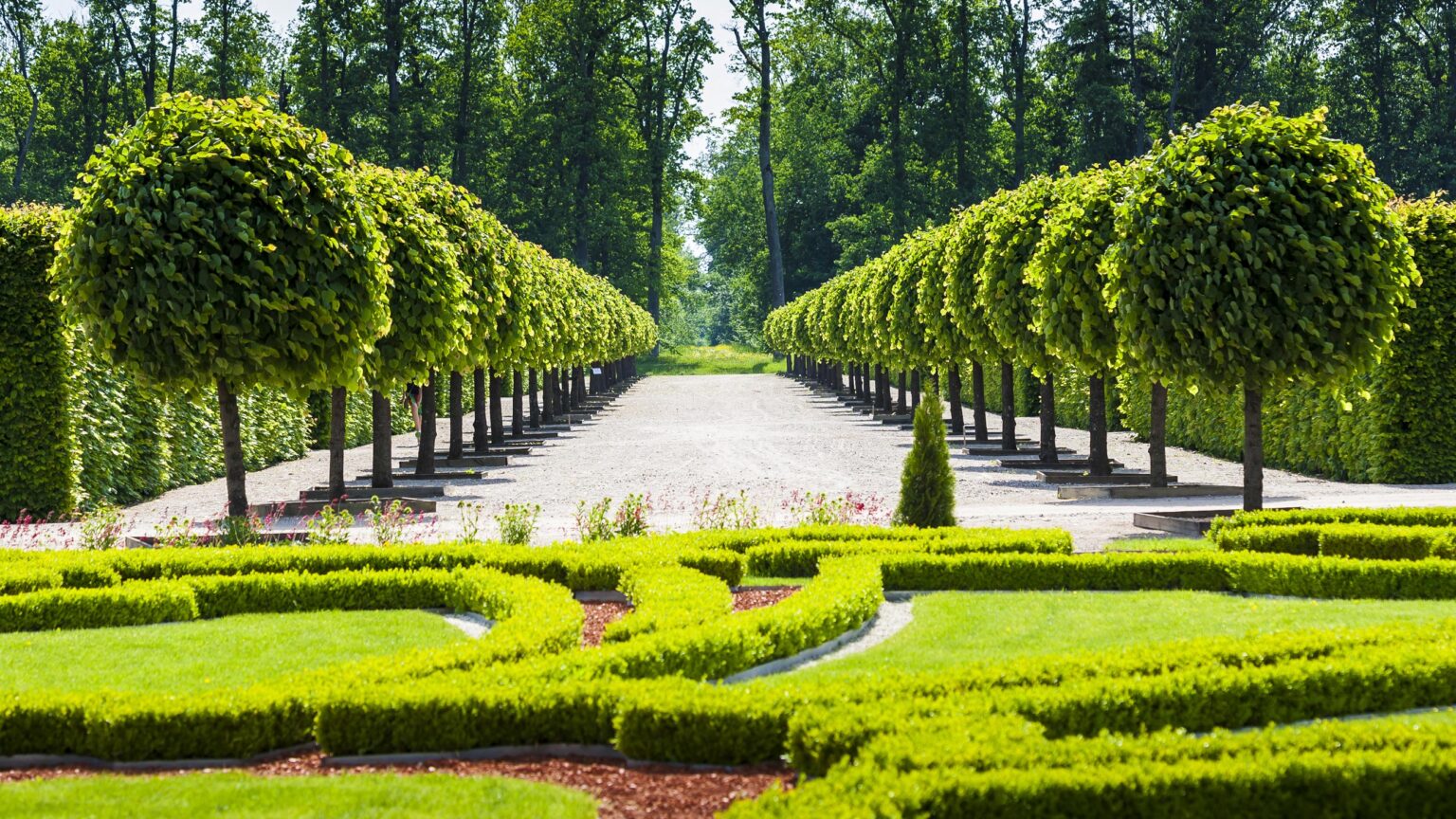
Arbours
An arbour refers to a structure or a decorative feature designed to provide shade, support climbing plants, and create a secluded space for relaxation or contemplation.
An arbour usually consists of a framework composed of columns or posts supporting an open roof, often constructed of lattice or trelliswork, which allows vines, such as roses or ivy, to grow and create a natural canopy overhead.
Arbours can be made of wood, metal, or stone.
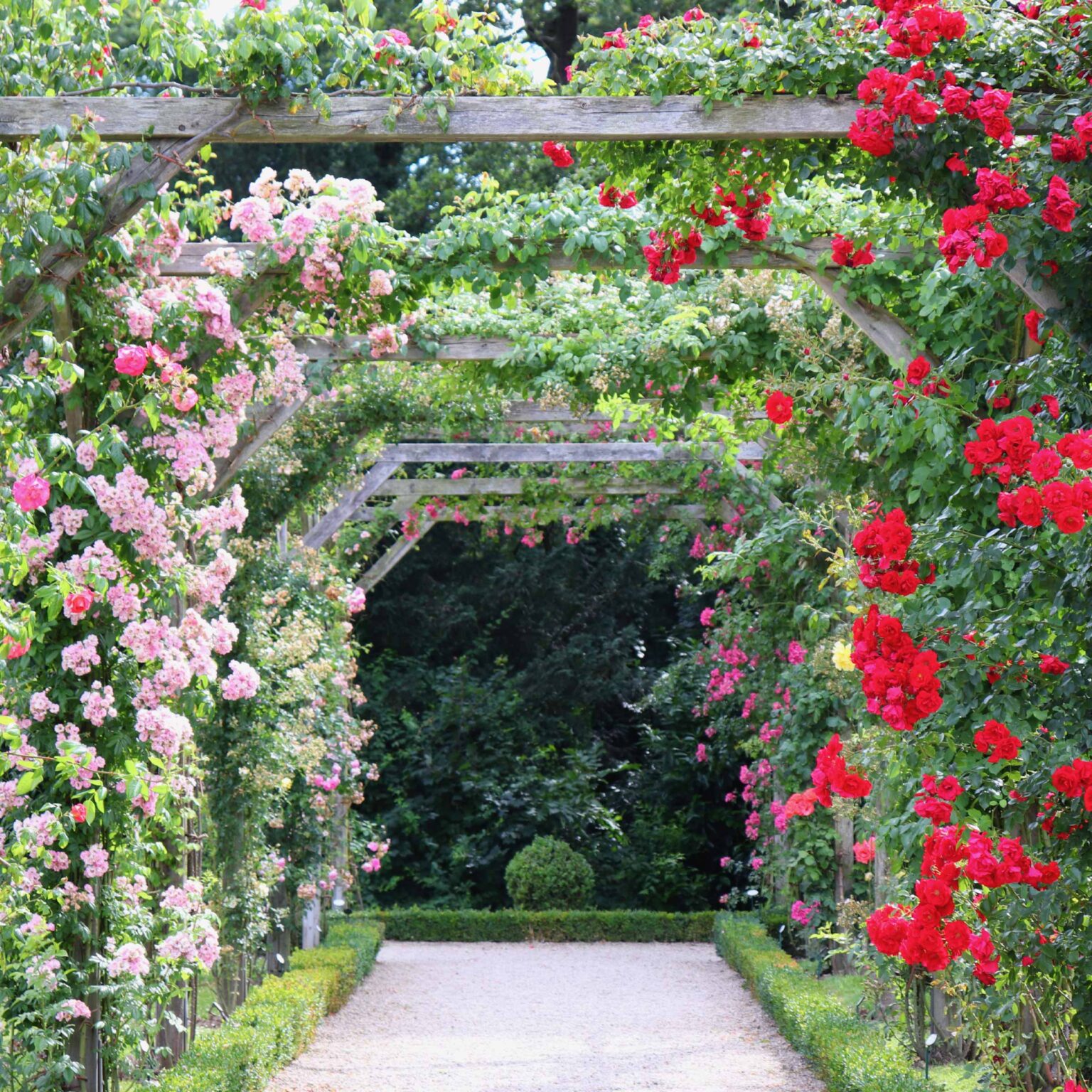
Decorative Ornation
Decorative ornation elevates formal gardens to a level of refined splendour.
Complex wrought iron gates, flawlessly carved stone balustrades, detailed mosaics and ornate urns serve as focal points, adding a touch of sophistication and grandeur to the landscape.
These ornamental elements create order, precision, and reflect the meticulous planning and attention to detail characteristic of formal gardens design.
Elaborate trellises adorned with climbing vines, decorative finials atop hedges, and strategically placed garden statuary all contribute to the formal aesthetic.
By incorporating such ornamentation, formal gardens become captivating spaces that radiate tasteful beauty, inspiring admiration in visitors.

Parterre
A parterre is a thoroughly designed and symmetrical arrangement of flower beds, pathways, and hedges. It serves as an ornamental centrepiece, combining horticulture and artistry. Each element is carefully placed to create a harmonious composition, often featuring geometric patterns and complex designs.
The flower beds are filled with vibrant and pruned plants, forming a colourful tapestry that changes with the seasons.
The pathways guide visitors through the garden, offering different perspectives and views of the meticulously polished landscape. The parterre embodies elegance, precision, and an appreciation for the craftsmanship that defines formal garden design.
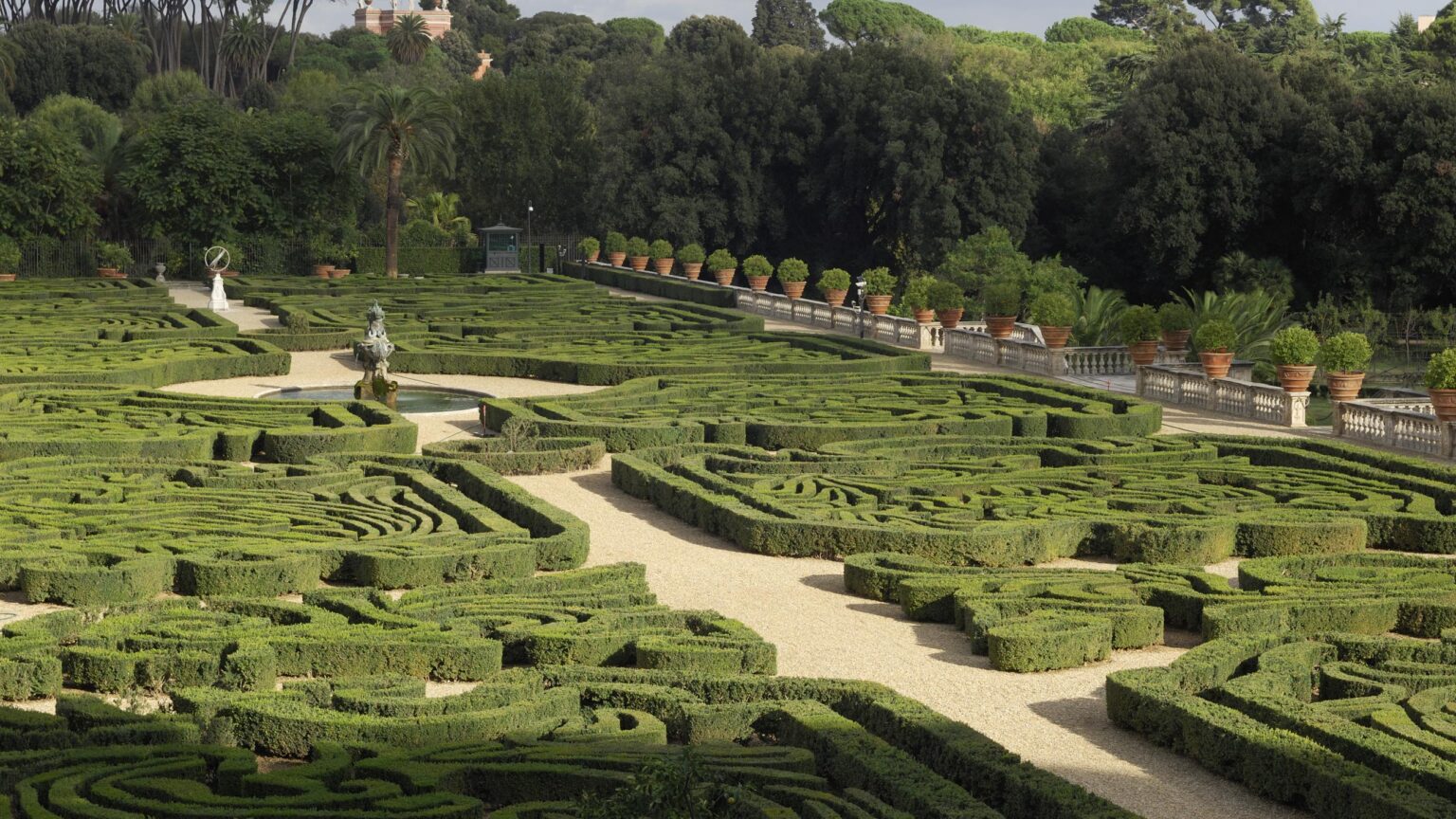
What plants to use to create a formal garden?
Plants are essential in formal gardens for their aesthetic, structural, sensory, and environmental contributions. They bring life and vitality to the garden space, creating a harmonious and captivating environment for visitors to enjoy.
Here is a list of the most common plants used in the UK to create a formal garden:
Pleached Lime
Pleached lime, also known as pleached linden or Tilia cordata, is a striking tree species often employed in formal garden designs. Its distinct feature lies in its carefully trained branches, creating a dense, elevated hedge-like effect known as “pleaching.” This artful technique has been used since the Renaissance era to fashion avenues, alleys, and green walls. In formal gardens, pleached lime trees are meticulously aligned to create structured boundaries, provide shade, and offer an aesthetically pleasing visual display. The vibrant green foliage, seasonal blossoms, and elegantly pruned appearance make pleached lime an exquisite addition, adding a touch of sophistication to any garden setting.
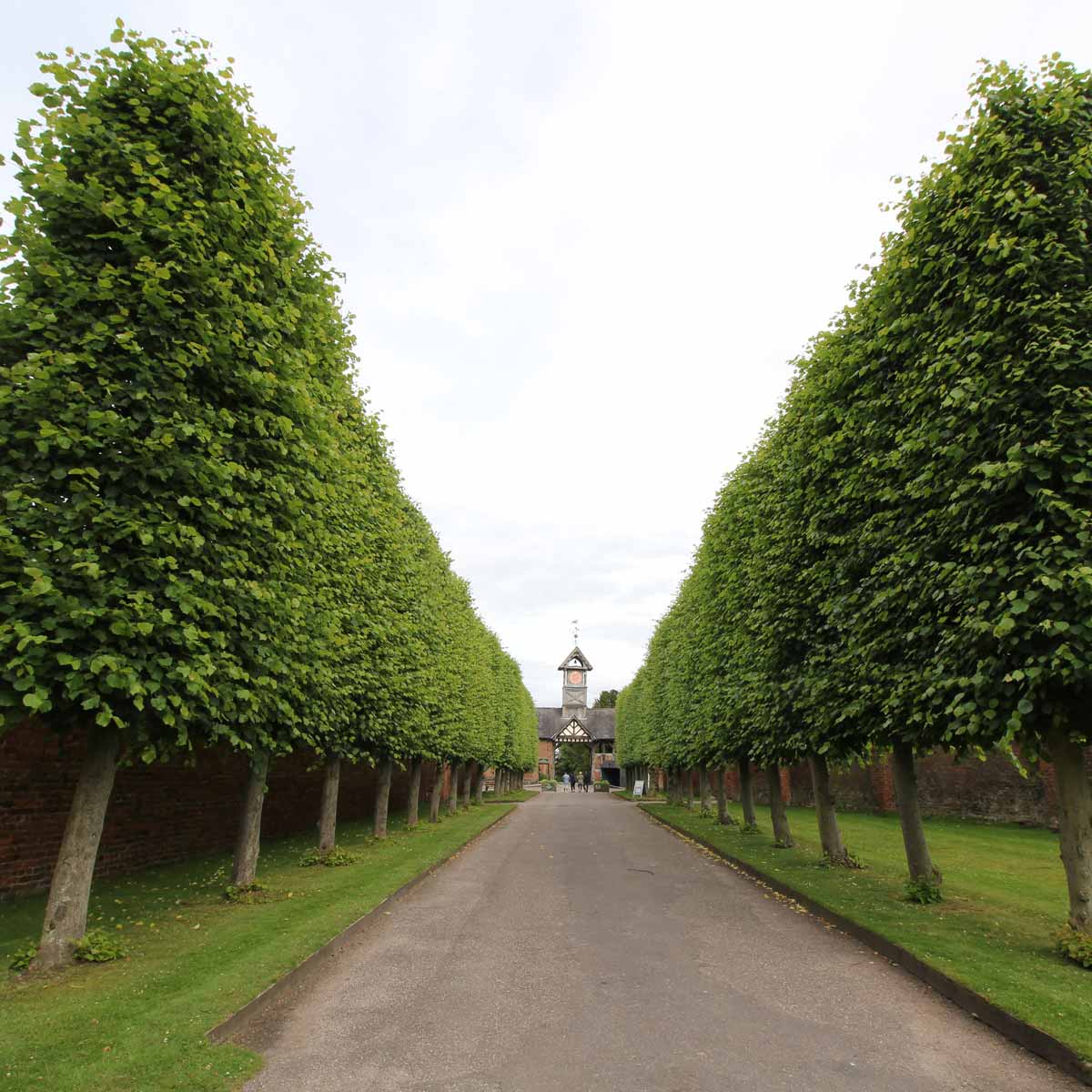
Yew
Yew, scientifically known as Taxus baccata, is a versatile evergreen tree widely employed in formal garden designs. Its dense, dark green foliage and ability to withstand heavy pruning make it ideal for shaping into various architectural forms. Yew’s slow growth and longevity allow for long-lasting, intricate structures like topiaries, hedges, and parterres, adding an air of elegance and order to formal gardens. Additionally, its tolerance to shade and pollution makes yew a preferred choice for urban landscapes. With historical significance dating back centuries, yew remains a classic choice for creating timeless, refined atmospheres in formal garden settings.
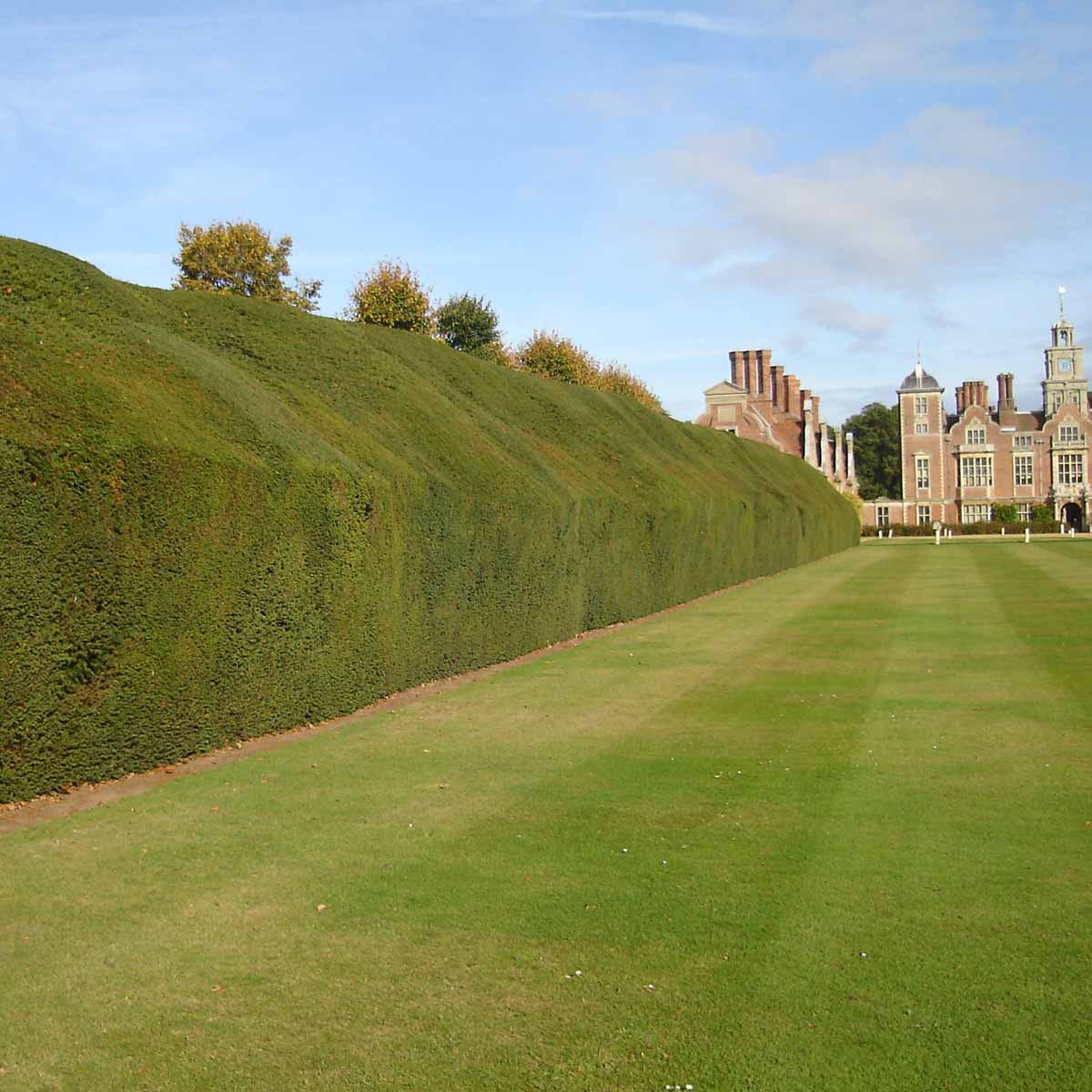
Viburnum
Viburnum, a diverse genus of shrubs and small trees, finds a valued place in formal gardens due to its versatility and ornamental appeal. With numerous species and cultivars available, it offers a wide range of foliage, flower, and berry colors, ensuring year-round interest. In formal garden designs, Viburnum is often utilized as clipped hedges, screens, or structured mass plantings, providing a sense of order and symmetry. Its lush foliage, fragrant blooms, and occasional fruiting enrich the garden’s aesthetics while attracting beneficial wildlife. Easy to maintain and adaptable to various soil conditions, Viburnum remains a popular choice, lending a touch of sophistication to formal outdoor spaces.
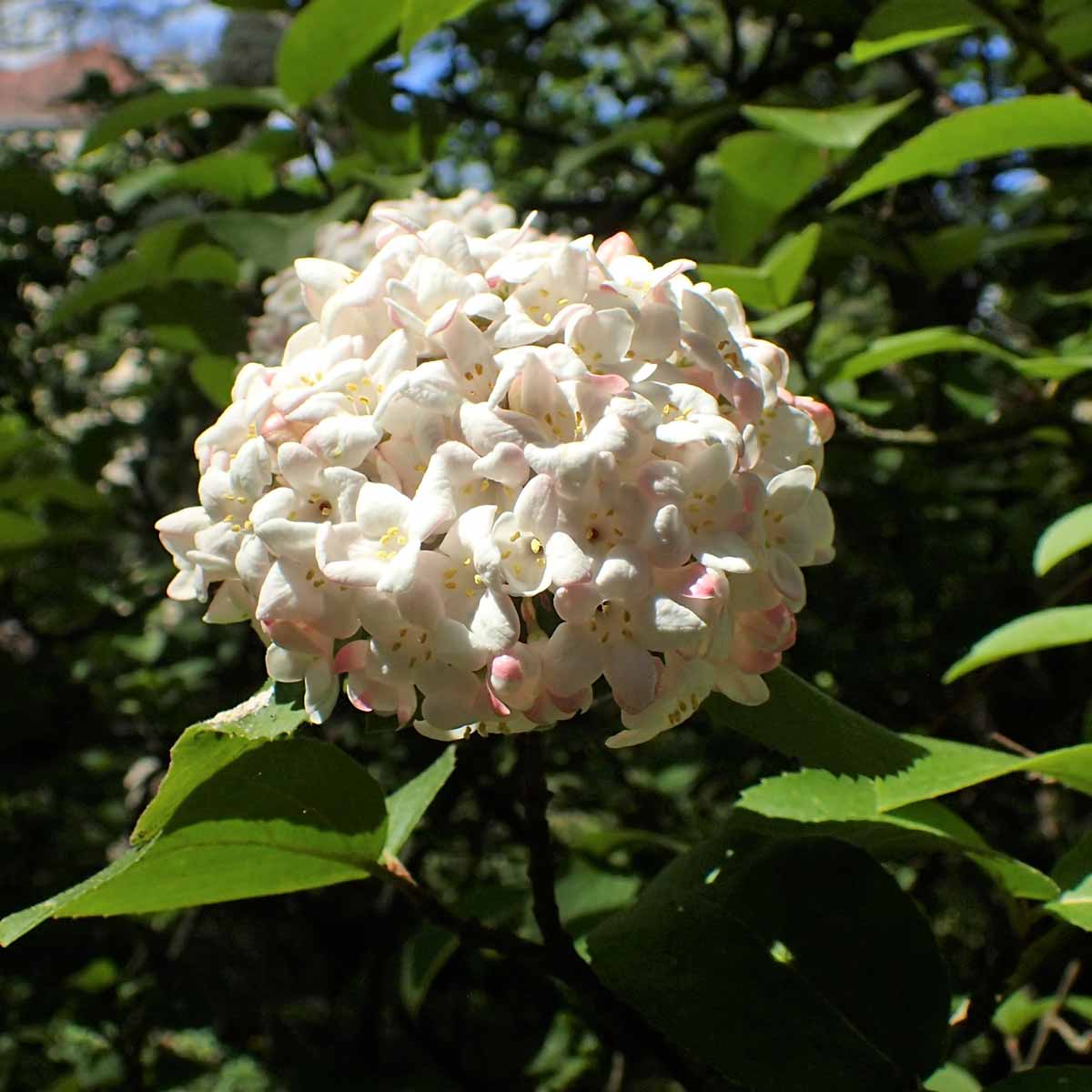
Thuja
Thuja, commonly known as arborvitae or cedar, is a prized evergreen conifer widely used in formal gardens for its stately appearance and versatility. With various species and cultivars available, Thuja offers different heights, shapes, and colors, making it adaptable to various design styles. In formal gardens, Thuja is favored for creating neat and elegant hedges, screens, and topiaries, defining borders and adding structure to the landscape. Its dense foliage and year-round greenery make it an attractive choice for providing privacy and visual interest. Resilient, low-maintenance, and tolerant of pruning, Thuja remains a go-to option for infusing a touch of sophistication into formal garden settings.
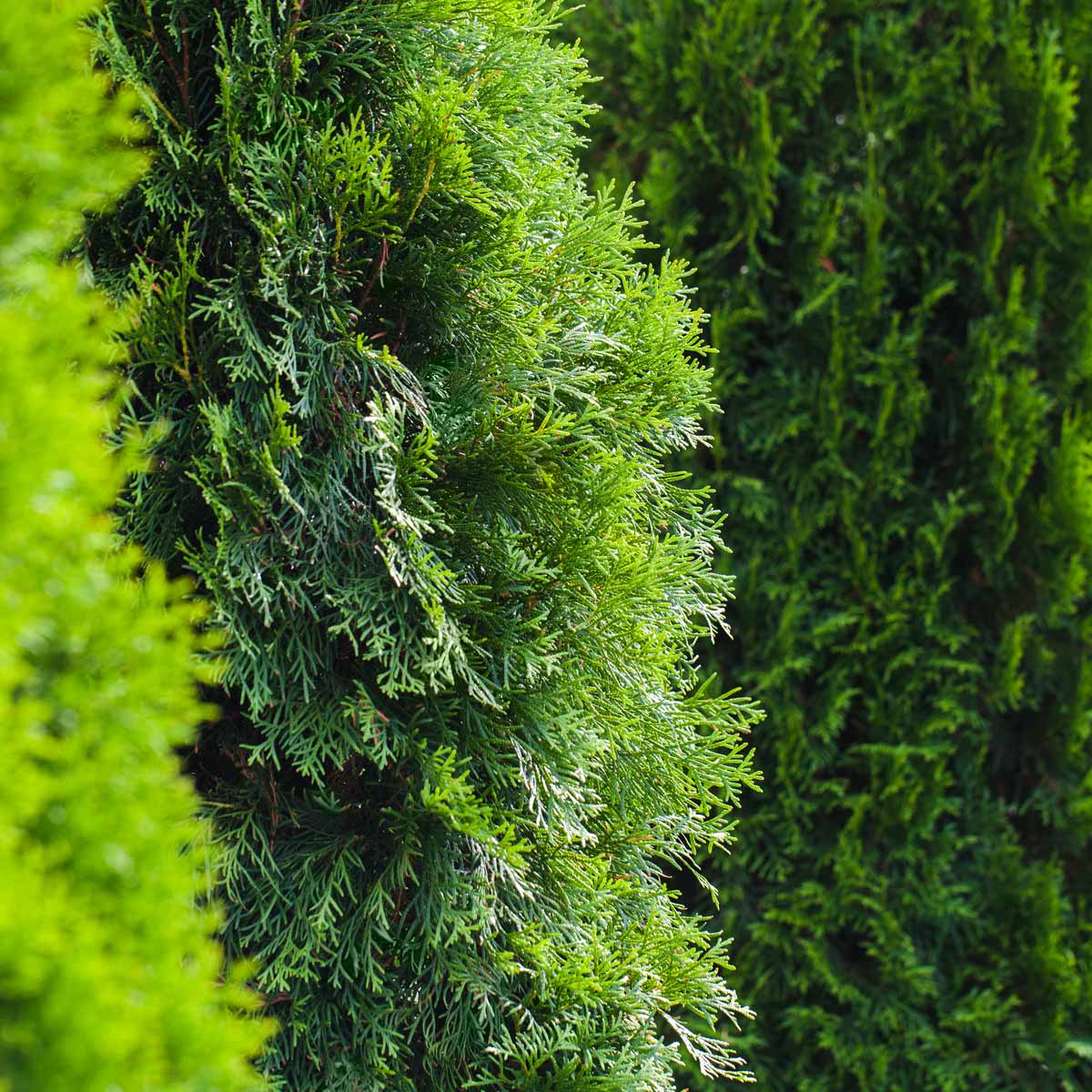
Privet
Privet, scientifically known as Ligustrum, is a popular deciduous or evergreen shrub used extensively in formal garden designs for its adaptability and neat appearance. Its dense foliage and fast growth make it ideal for creating well-defined hedges, screens, and borders, adding structure and privacy to the landscape. With various species and cultivars available, Privet offers a range of leaf colors and sizes, catering to different design preferences. Resilient and easy to maintain, it thrives in a wide range of soil conditions and climates. Privet’s versatility and ability to be pruned into geometric shapes make it a favored choice for achieving refined elegance in formal garden settings.
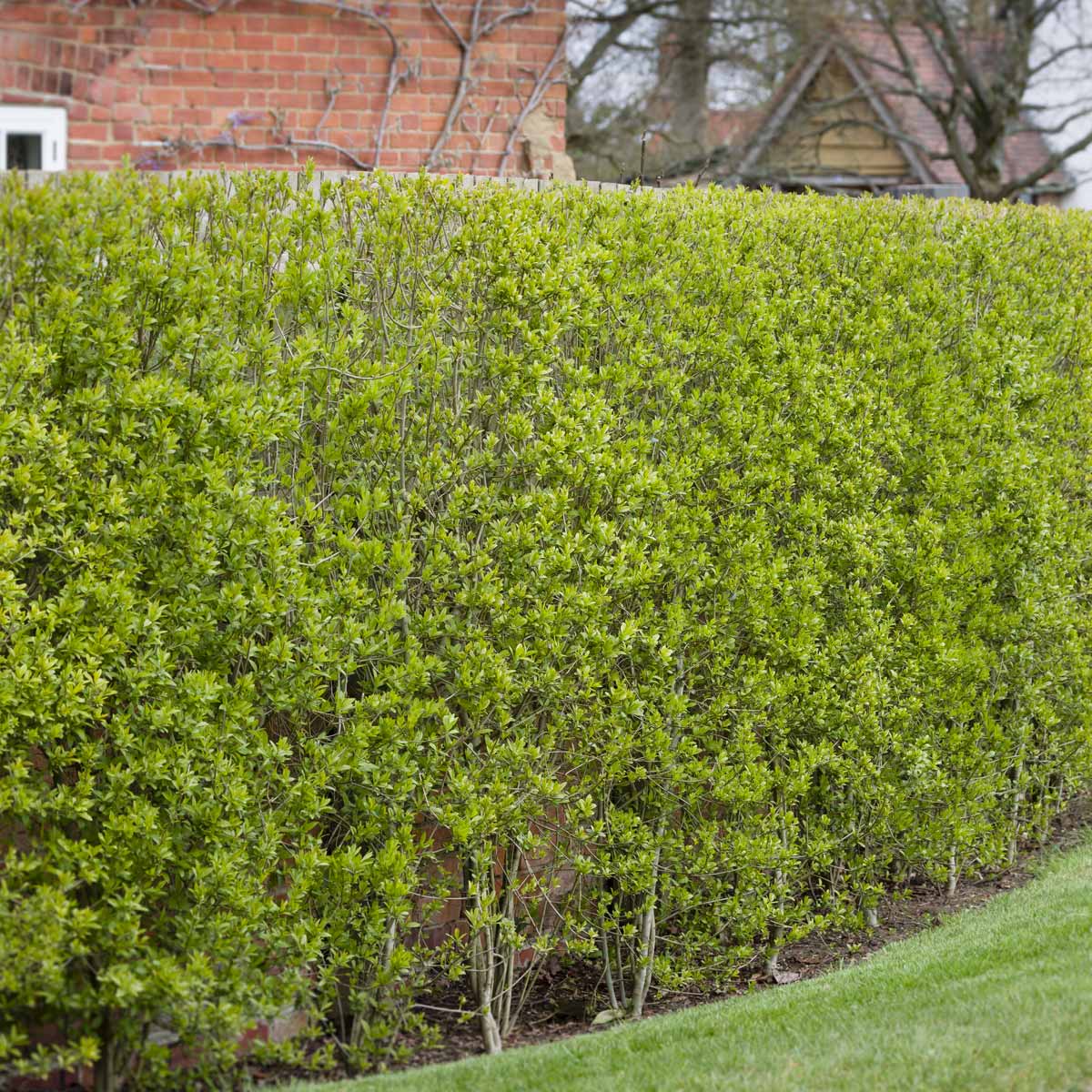
Agapanthus
Agapanthus, commonly known as Lily of the Nile, is a striking perennial plant adored for its stunning, globe-shaped clusters of blue or white flowers. Its elegance and low-maintenance nature make it a favored choice in formal gardens, where it adds a touch of sophistication and color to borders, beds, and containers. Agapanthus’ tall flower stalks and lush, strap-like foliage create a sense of verticality and structure, lending a refined atmosphere to the landscape. Additionally, its ability to thrive in a variety of climates and soil conditions further contributes to its popularity as a versatile and enchanting addition to formal garden designs.
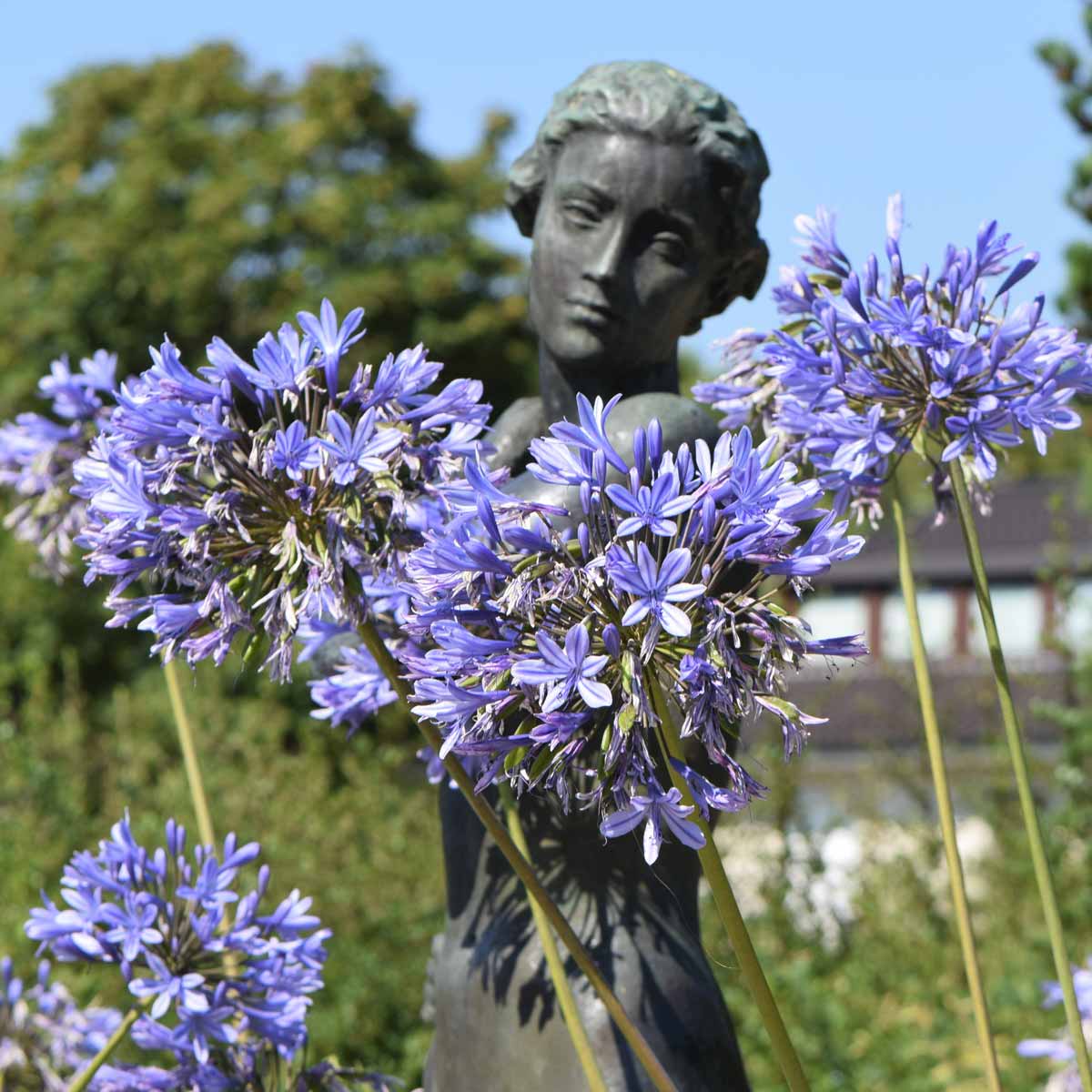
Leyland Cypress
Leyland Cypress, or x Cupressocyparis leylandii, is a popular evergreen tree frequently utilized in formal gardens for its rapid growth and majestic appearance. Its tall, columnar shape makes it an excellent choice for creating living walls, screens, and windbreaks, imparting structure and privacy to the landscape. Its fine, feathery foliage adds a touch of elegance to the garden. Though adaptable to various soil types, Leyland Cypress requires regular pruning to maintain its neat form. While its use has been widespread, caution should be exercised in smaller gardens due to its potential to outgrow available space. In larger formal gardens, it remains an impressive option for delineating boundaries and enhancing grandeur.
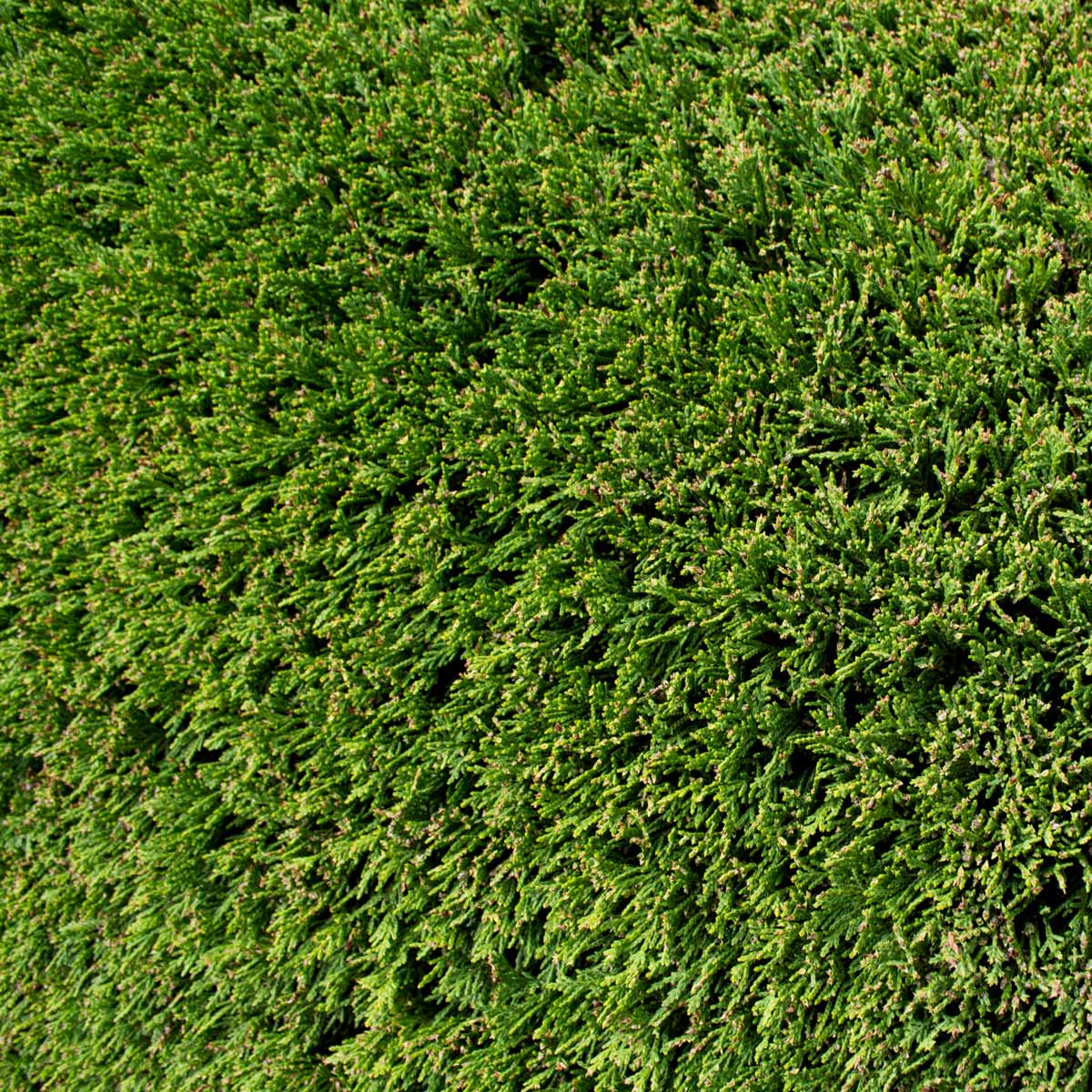
Laurel
Laurel, known scientifically as Laurus nobilis, is a classic evergreen shrub or tree cherished for its glossy, aromatic leaves and elegant appearance. In formal gardens, Laurel is a popular choice for creating hedging, topiaries, and structured planting designs. Its dense foliage provides privacy, acts as a windbreak, and offers an element of formality to the landscape. With various cultivars available, Laurel offers different sizes and shapes to suit the garden’s design requirements. Its adaptability to pruning and ability to thrive in full sun to partial shade make it a favored and enduring selection, adding timeless charm to formal garden settings.
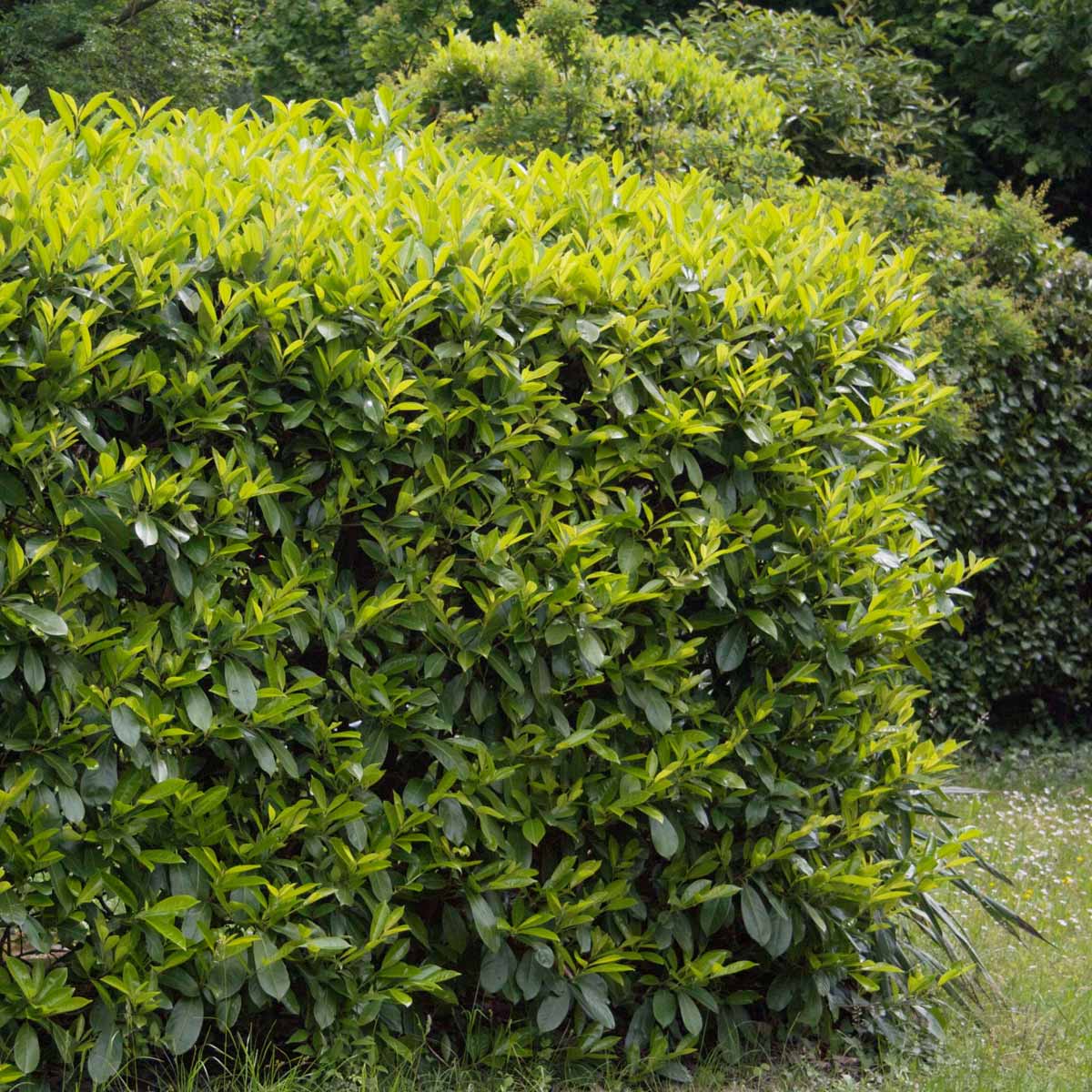
Allium
Allium, a diverse genus of flowering plants, is prized for its unique and captivating globe-shaped blooms. In formal gardens, Alliums are cherished for their architectural appeal and ability to add a splash of color and vertical interest to the landscape. With a wide range of species and cultivars available, these ornamental onions offer various flower sizes, colors, and bloom times, ensuring a continuous display throughout the growing season. From structured borders to grand parterres, Alliums are creatively used in formal garden designs to evoke elegance and artistry. Their low-maintenance nature and attractive pollinator-friendly qualities further enhance their popularity in formal garden settings.
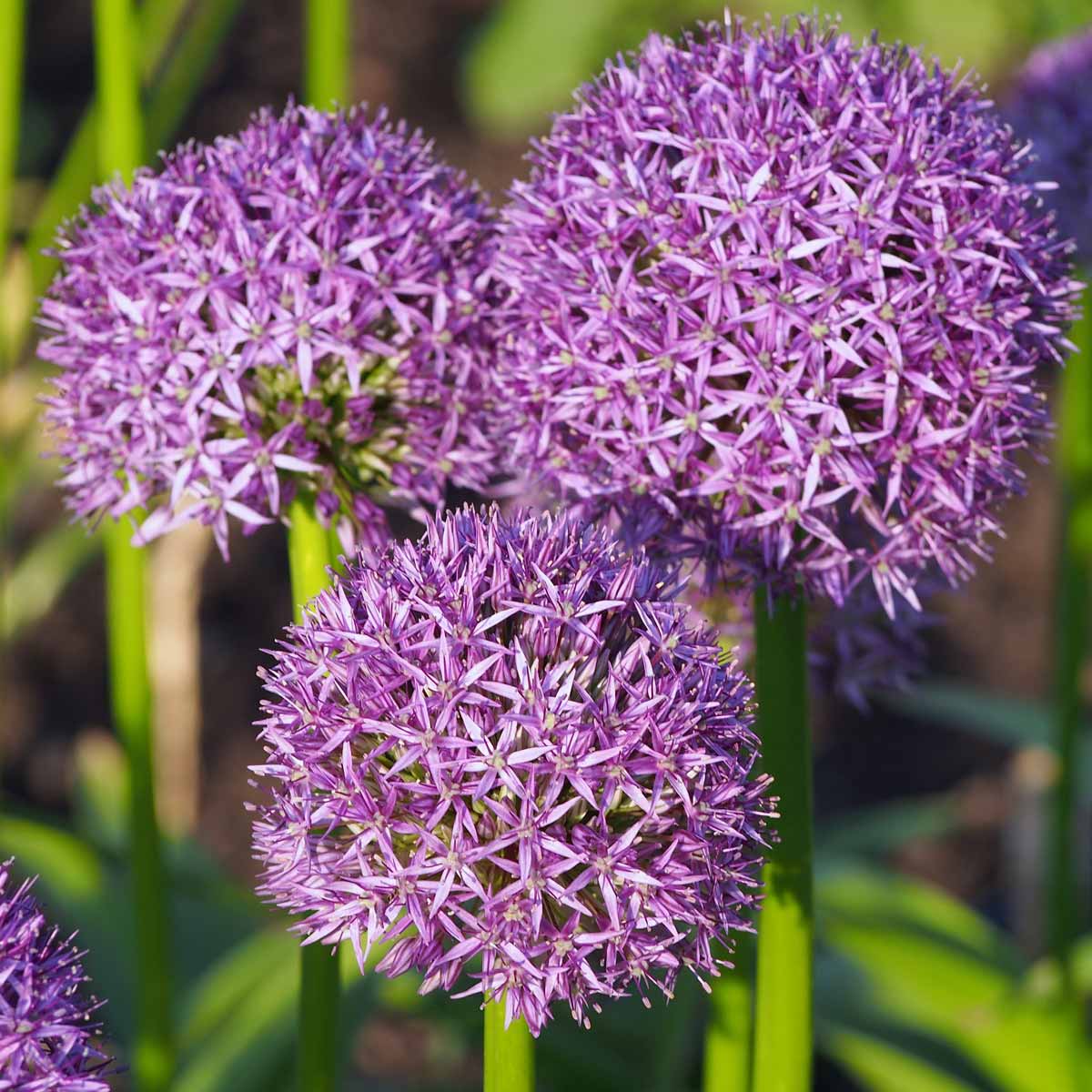
Hornbeam
Hornbeam, scientifically known as Carpinus betulus, is a majestic deciduous tree highly valued for its versatility and ornamental appeal in formal gardens. Its distinct, serrated leaves and smooth gray bark lend an air of elegance to the landscape. Hornbeam is popularly used for creating pleached hedges, meticulously trained to form living walls and alleys, adding structure and privacy to formal garden designs. Its tolerance to pruning makes it an excellent choice for topiaries, parterres, and tightly clipped shapes, embodying a sense of refined sophistication. With its ability to thrive in various soil types and climates, Hornbeam remains an enduring favorite in creating timeless and stylish formal garden settings.
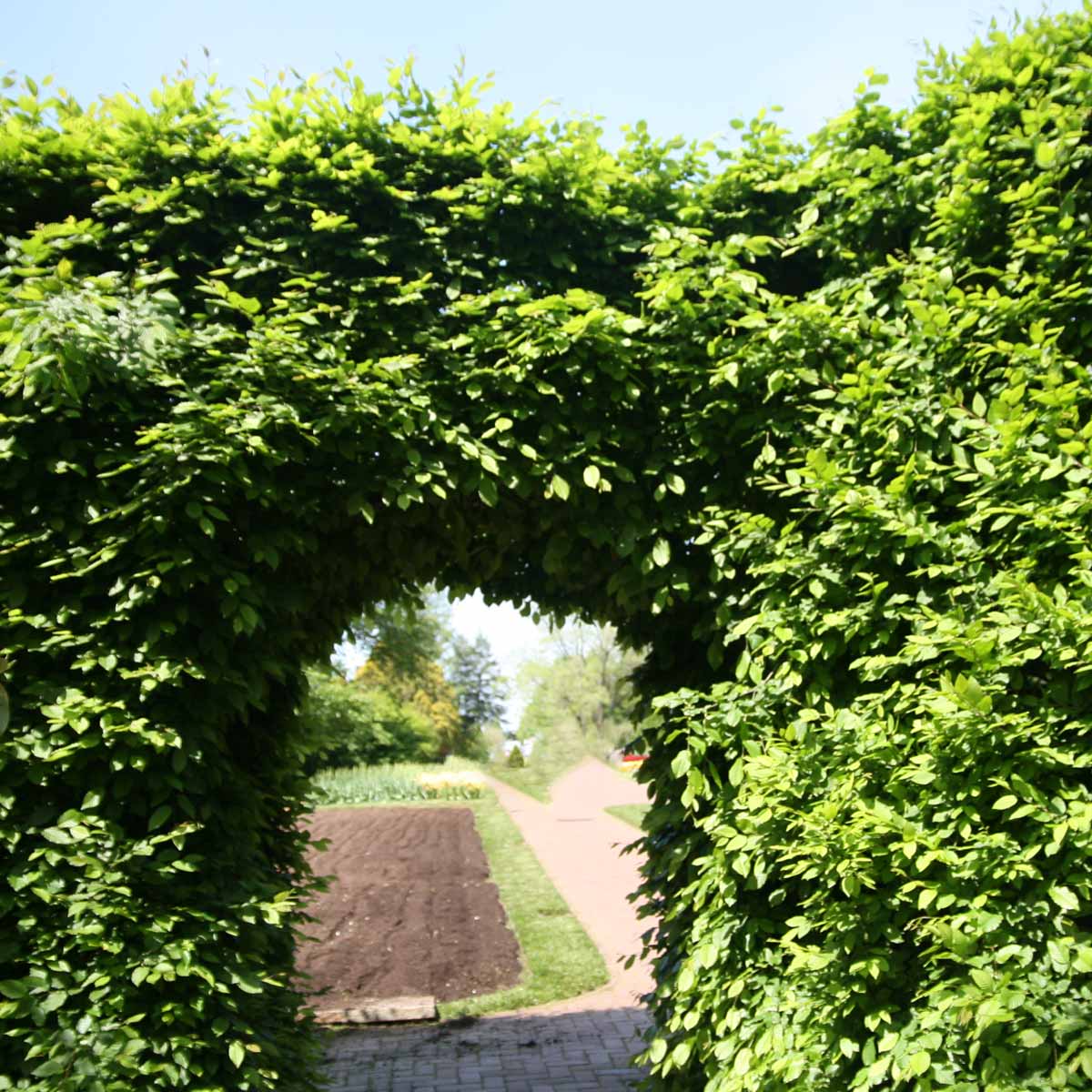
Holly
Holly, a diverse genus of evergreen and deciduous shrubs and trees, is held in esteem in formal gardens for its iconic red berries and glossy, serrated leaves. Its versatility and beauty make it a popular choice for hedges, screens, and topiaries, adding structure and privacy to the landscape. Holly’s year-round greenery and vibrant berries create a festive and elegant atmosphere, especially during the winter months. Its ability to withstand pruning and shaping into various forms allows for intricate designs that exude sophistication. Whether lining pathways or gracing formal beds, Holly remains a timeless and enduring addition to create refined and enchanting formal garden spaces.
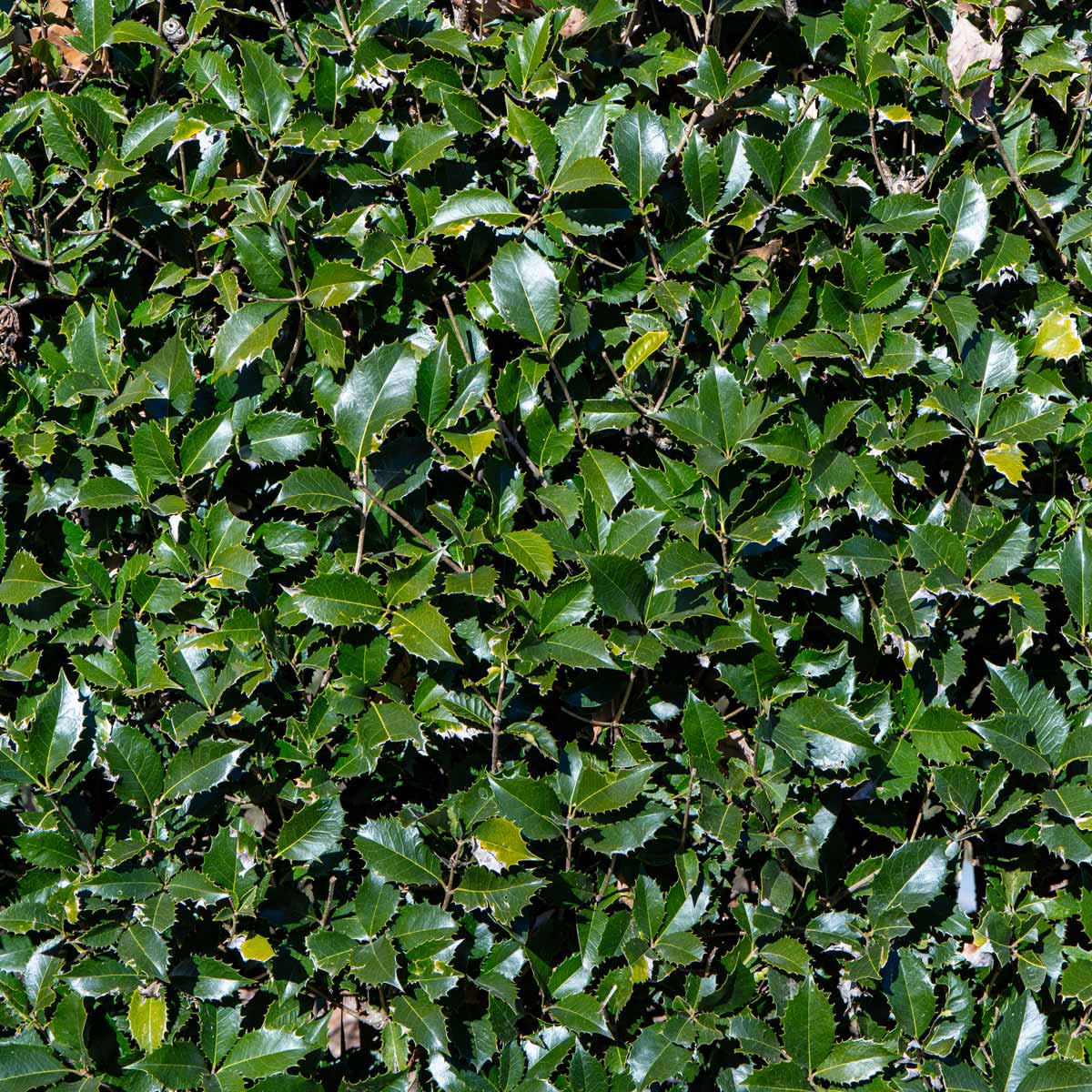
Boxwood
Boxwood, a classic evergreen shrub, is an essential element in formal garden designs, adored for its versatility and timeless appeal. Its small, dense leaves and slow growth make it ideal for creating low hedges, parterres, and topiaries, adding structure and symmetry to the landscape. Boxwood’s elegant, clipped appearance imparts a sense of refinement and order to formal garden settings. Its ability to thrive in various soil types and climates, coupled with its tolerance to pruning, makes it a favored choice for achieving geometric precision and providing year-round greenery. As an enduring symbol of formality, Boxwood continues to elevate the elegance of formal gardens worldwide.
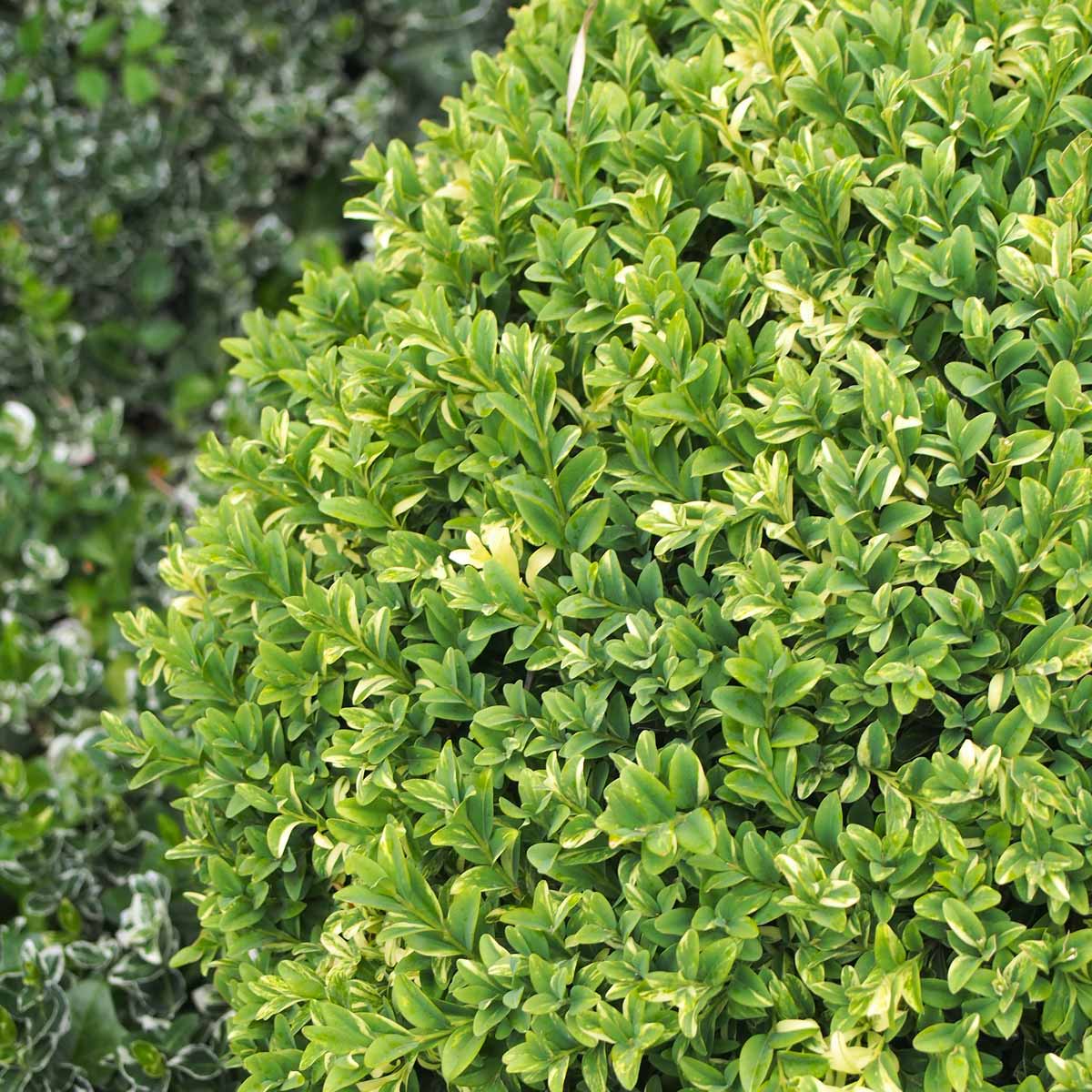
Beech
Beech, known scientifically as Fagus, is a magnificent deciduous tree treasured in formal gardens for its majestic stature and beautiful foliage. With its smooth, gray bark and delicate, serrated leaves, Beech adds an air of elegance to the landscape. Its versatility makes it suitable for creating structured avenues, alleys, and pleached hedges, contributing to the garden’s formal aesthetic. Beech’s golden-bronze autumnal colors provide a stunning seasonal display, further enhancing its appeal. Its ability to tolerate pruning allows for creative topiaries and sculpted shapes, making it an enduring favorite for instilling refined charm and grandeur in formal garden designs.
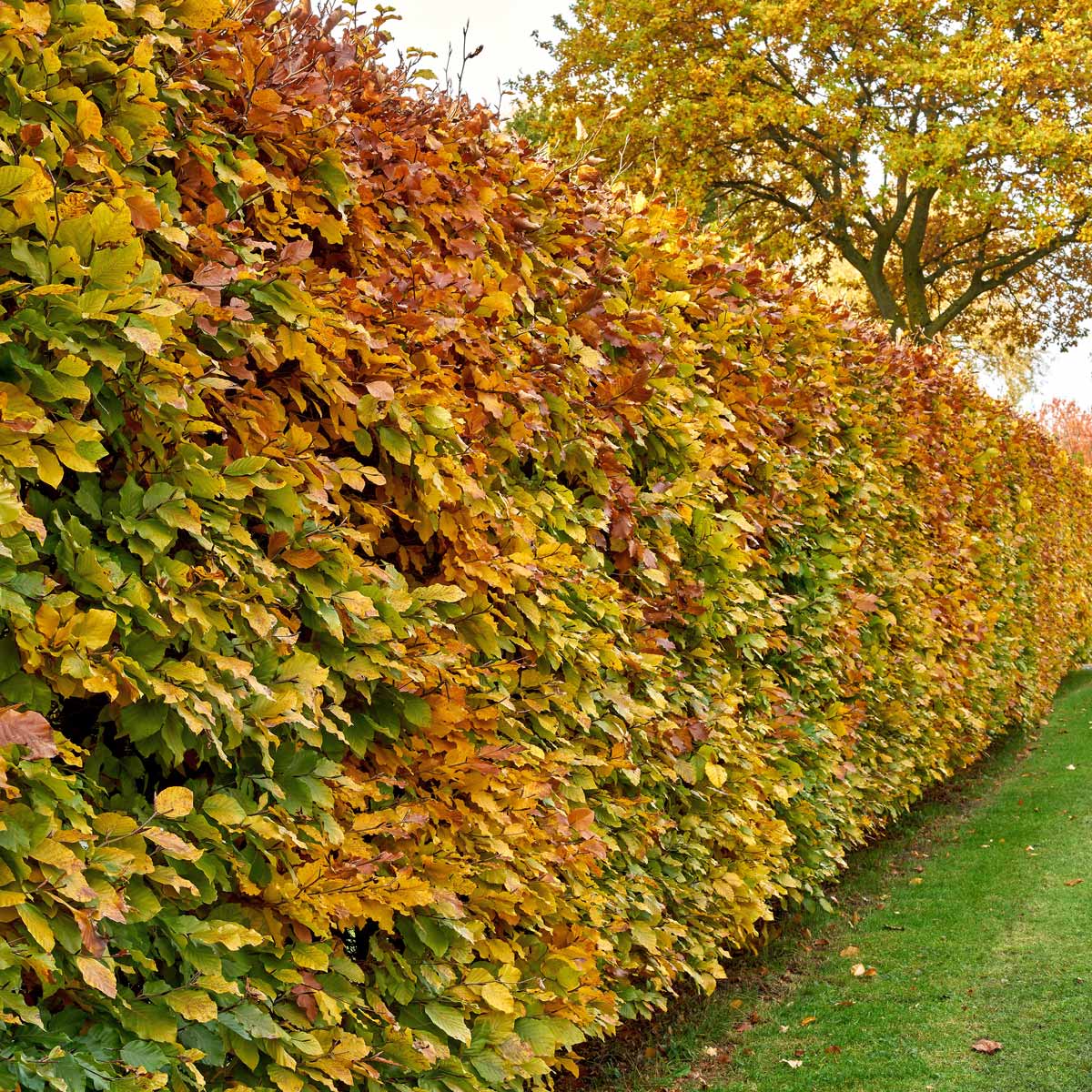
Photinia
Photinia, a popular genus of evergreen shrubs and small trees, is venerated in formal gardens for its vibrant foliage and versatility. Its glossy, red-tinged leaves create a stunning contrast against the dark greenery, adding visual interest and a touch of colour to the landscape. In formal garden designs, Photinia is widely used as clipped hedges, screens, and topiaries, providing a sense of structure and elegance. Its fast growth rate allows for quick establishment and effective privacy solutions. With its adaptability to pruning and ability to thrive in various soil conditions, Photinia remains a favoured choice for adding a touch of sophistication and dynamism to formal garden settings.
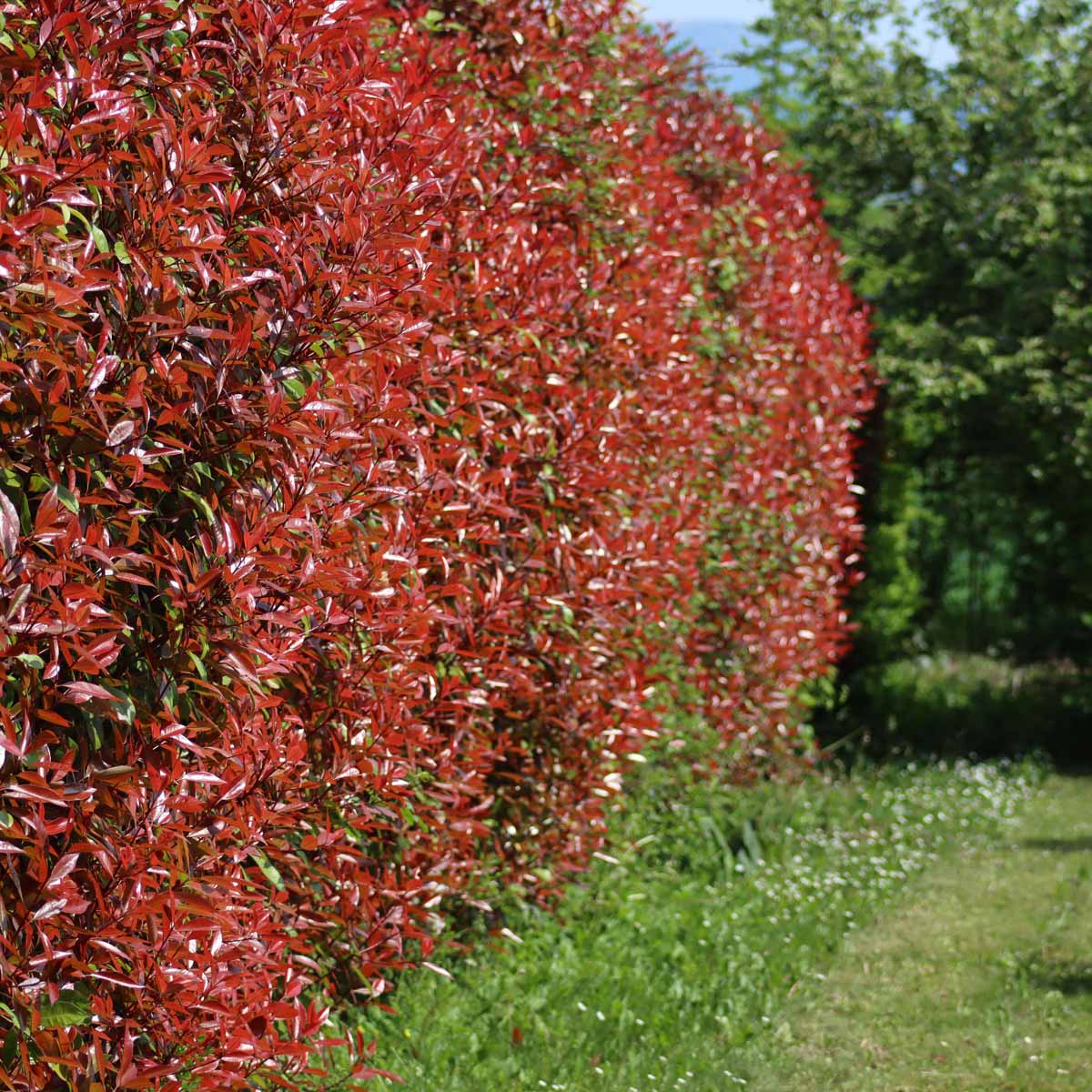
Roses
Formal gardens showcase the beauty of roses, as well as their grace and refinement.
These majestic blooms, meticulously arranged, captivate the eye with their vibrant colours and velvety petals.
Immaculately pruned brushes stand in perfect symmetry, displaying a harmonious balance of height and form. Lush green foliage provides a striking backdrop, accentuating the rose’s fragile allure. Each blossom exudes a delicate fragrance, enchanting visitors with its stimulating scent. Roses create a calming sanctuary that celebrates nature’s exquisite artistry.
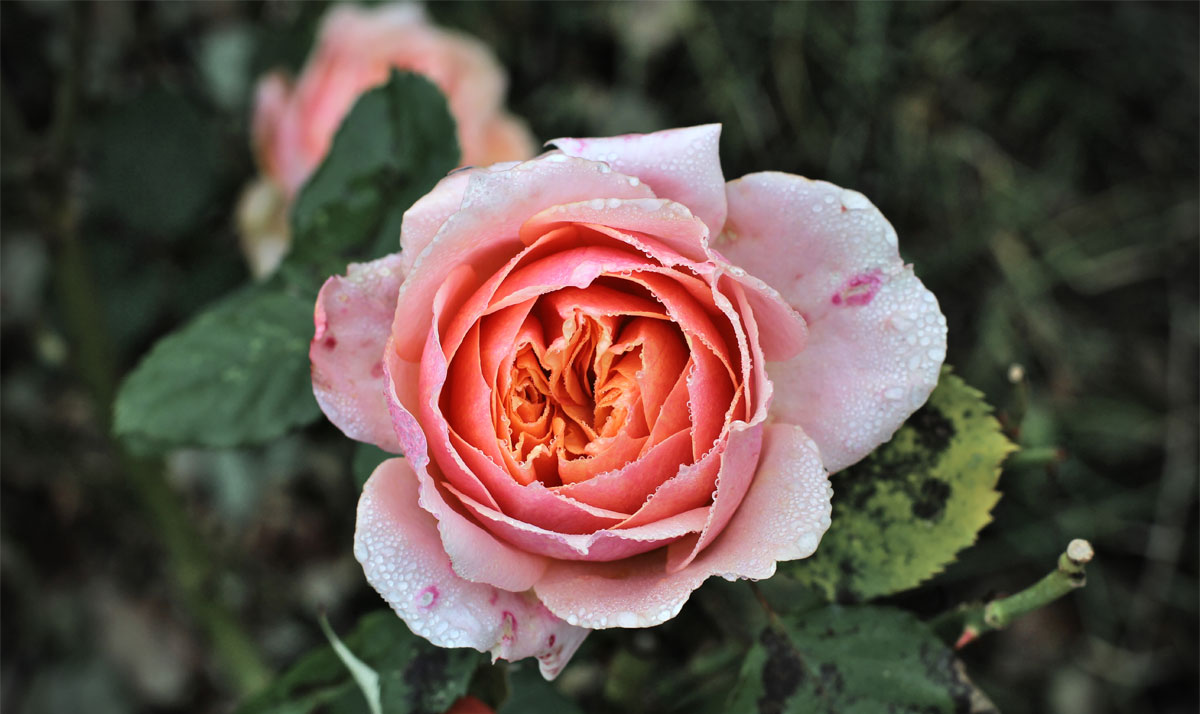
Lavender
In formal gardens, lavender reigns as a symbol of serenity and sophistication. These graceful plants, with their slender stems and aromatic silver-green foliage, emanate an air of elegance.
Neatly trimmed and carefully aligned, their purple-hued spikes create a tapestry of colour and texture.
Among their perfectly shaped surroundings, the lavender’s soothing fragrance wafts through the air, inviting contemplation and relaxation. With their forever charm and graceful presence, lavender plants lend a touch of tranquillity to formal gardens, adding a delicate touch of beauty and colour to the structured landscape.

Hydrangeas:
Hydrangeas, with their elegant blooms and lush foliage, make a splendid addition to formal garden designs. These versatile flowering shrubs offer a touch of charm and grace to structured landscapes.
Hydrangeas’ large, showy flower clusters in various shades of blue, pink, or white add a vibrant burst of colour to the garden, creating a captivating visual impact. Hydrangeas’ rounded, compact form lends itself well to symmetrical layouts and neatly manicured hedges. Whether used as focal points, borders, or accents, these enchanting plants effortlessly enhance the refined aesthetic of a formal garden while adding a delightful softness and romantic allure.
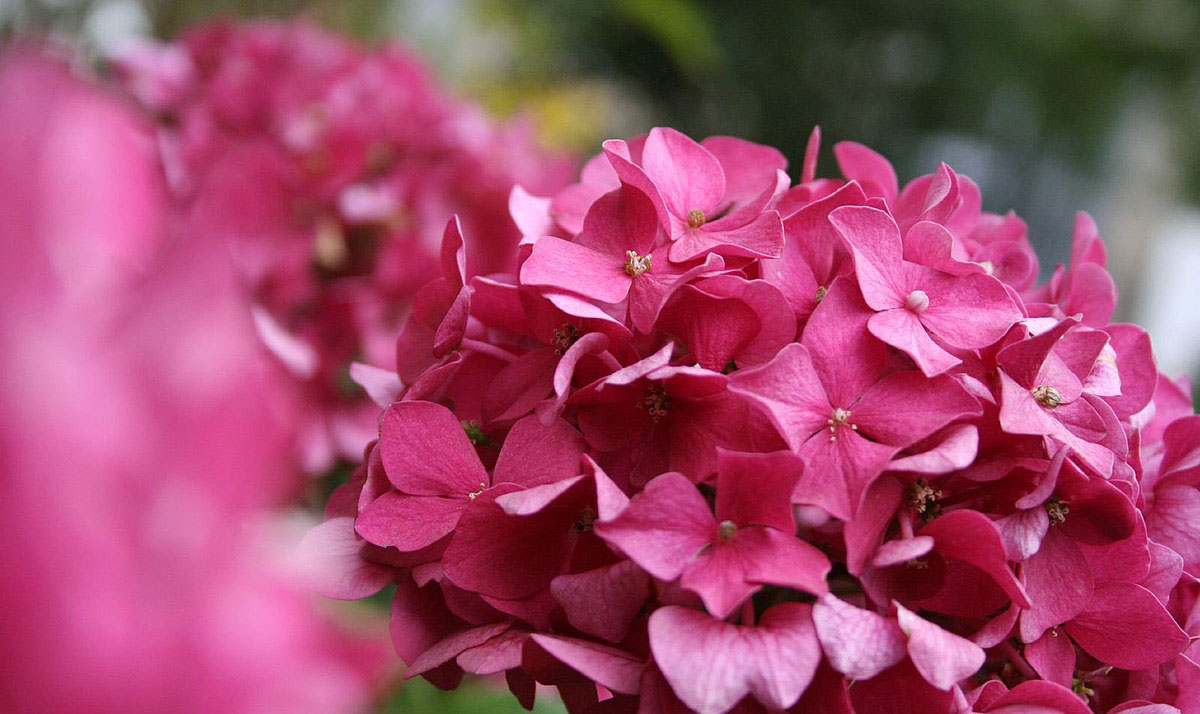
Ornamental grasses
Ornamental grasses, with their graceful and swaying movement, add a dynamic and textural element to formal garden designs. These versatile plants can be utilized in various landscaping techniques to enhance the overall aesthetic. In formal gardens, ornamental grasses are often used to create borders, hedges, or to line pathways, providing a structured yet softening effect. They can be planted in symmetrical patterns to add a sense of rhythm and balance. Tall grasses, like Miscanthus sinensis or Calamagrostis acutiflora, can be placed strategically to provide vertical accents. Smaller grasses, such as Festuca glauca or Pennisetum alopecuroides, can be used for ground cover or as edging plants.

Foxgloves
Foxgloves, scientifically known as Digitalis, are enchanting and majestic flowers that add a touch of elegance to formal gardens. Standing tall with their spires of bell-shaped blossoms, foxgloves create a captivating display of colours, ranging from soft pastels to vibrant hues.
These biennial or perennial plants have a rich historical significance, as they have been cultivated for centuries for their medicinal properties. Historically, foxgloves were used to treat various ailments, particularly heart conditions, due to their cardiac glycosides. Their presence in formal gardens pays homage to their traditional role in herbal medicine and serves as a reminder of the intricate relationship between nature, science, and human health.
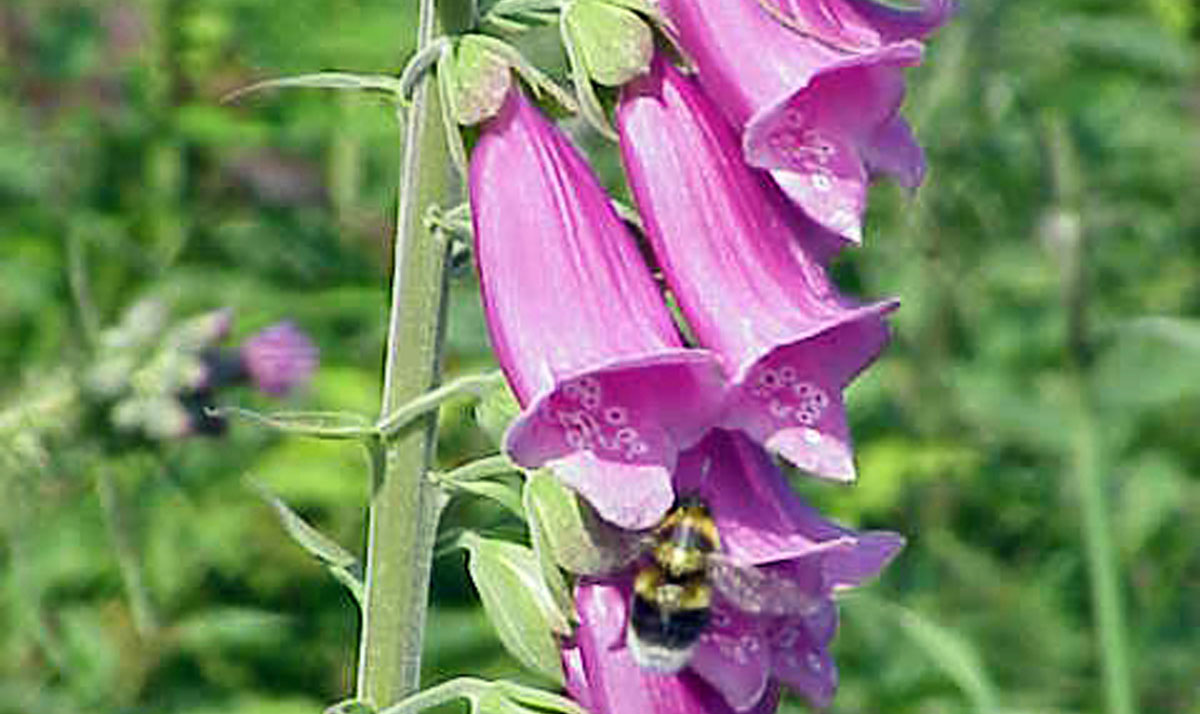
Hollyhocks
Hollyhocks, with their tall, majestic stems and vibrant blossoms, add a touch of elegance and charm to a formal garden. These striking flowers come in a variety of colours, including pinks, purples, yellows, and whites, creating a visually intriguing display. To maintain hollyhocks, provide them with well-drained soil and full sunlight as much as possible.
Regular watering and occasional fertilization will promote healthy growth. As they grow tall, it is essential to provide support with stakes or trellises to prevent them from bending or breaking. Deadheading spent blooms will encourage continuous flowering. Additionally, regular inspection for pests and diseases will ensure the longevity and vibrancy of these beautiful garden additions.
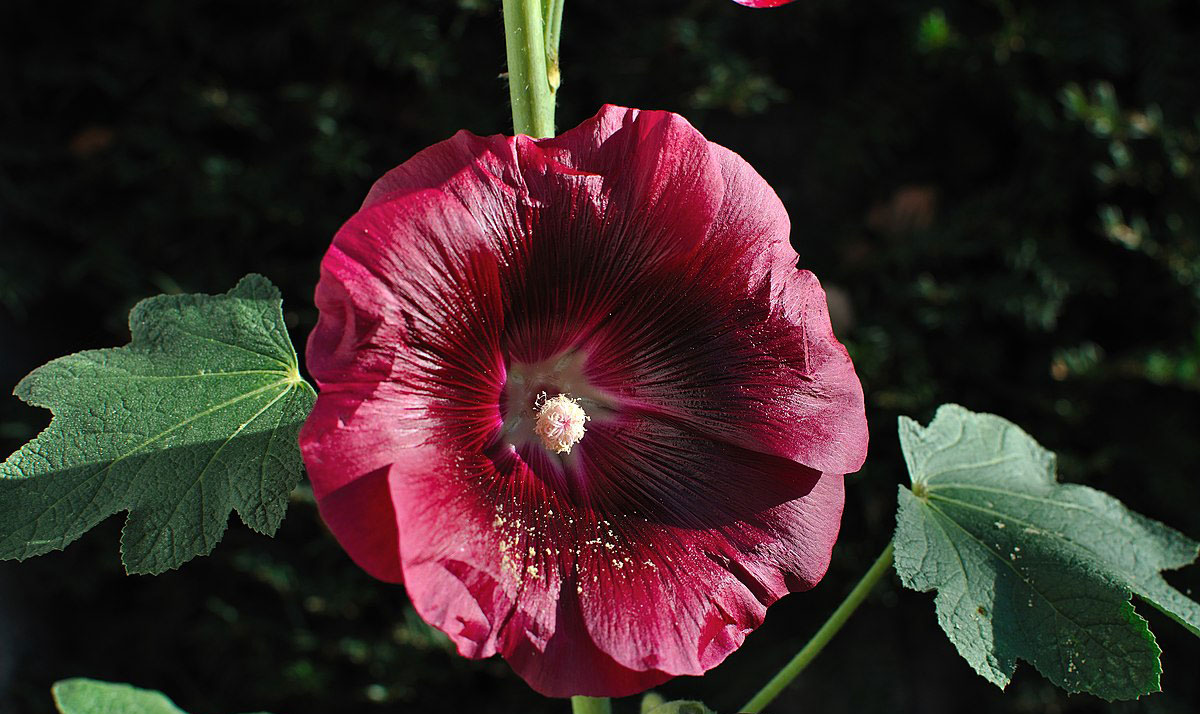
Tulips
Tulips, renowned for their immense variety of colours, have the remarkable ability to brighten formal gardens with their vibrant presence. These captivating flowers come in an extensive palette (over 130 different options to choose from!), ranging from bold and fiery reds to soft and delicate pastels, including shades of pink, purple, yellow, and white.
Their vivid and diverse hues create a stunning display that adds a touch of elegance and charm to formal landscapes. Whether arranged in neatly shaped beds or lining pathways with a burst of colour, tulips transform formal gardens into captivating realms of beauty. With their radiant petals and captivating shades, tulips bring joy and a sense of enchantment to any formal garden setting.

Formal Gardens around the world
Each culture’s formal gardens beautifully express their cultural heritage through architectural features and decorative ornaments. They provide a glimpse into their unique traditions, beliefs, and aesthetics, showcasing the profound connection between nature, art, and human expression.
Japanese Formal Gardens
Japanese formal gardens are characterized by their harmony, simplicity, and meticulous attention to detail. They draw inspiration from Zen Buddhism and reflect a deep connection to nature. Architectural features such as teahouses and pavilions serve as focal points, while decorative ornaments like stone lanterns and water basins enhance the serene atmosphere. The use of carefully pruned trees, moss-covered rocks, and bonsai trees adds a sense of tranquillity and balance.
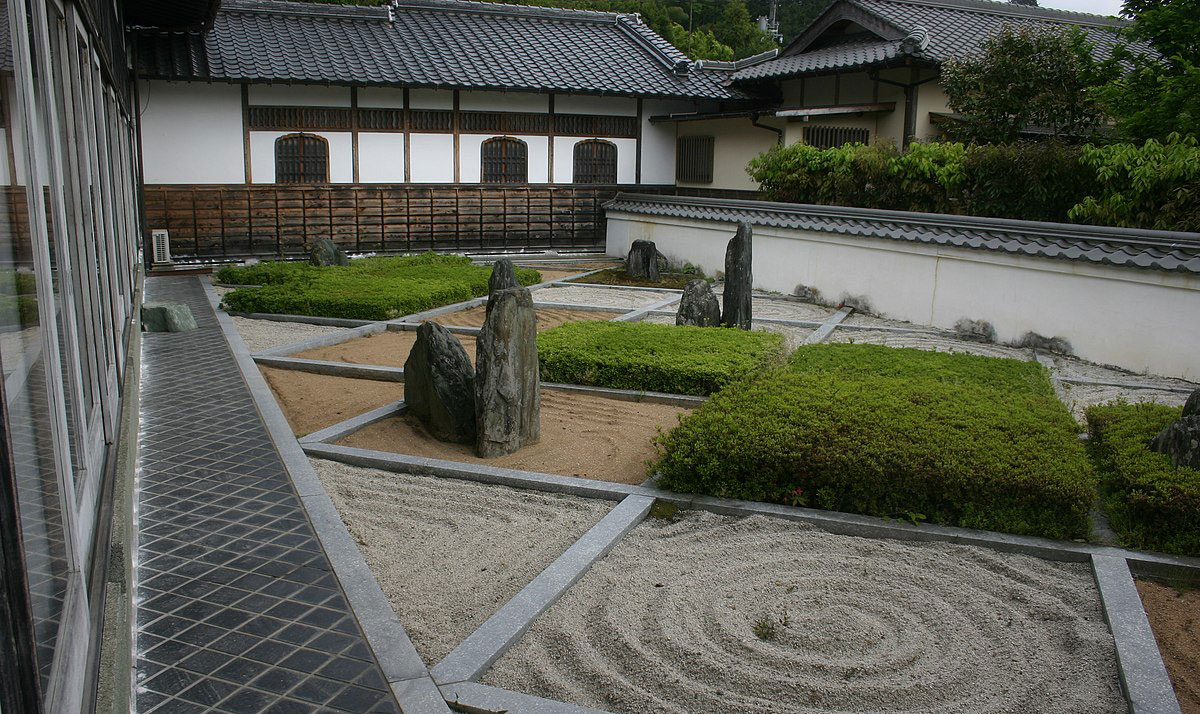
French Formal Gardens
French formal gardens, inspired by the Renaissance and Baroque styles, exhibit grandeur and symmetry. They feature geometric layouts, ornate parterre designs, and polished lawns. Prominent architectural features include terraces, fountains, and statues. Decorative elements like topiary, sculptures, and meticulously trimmed hedges add to the artistic appeal. French gardens often include elements of water, such as ornamental ponds or cascading fountains. They reflect the country’s love for elegance, sophistication, and the pursuit of beauty.
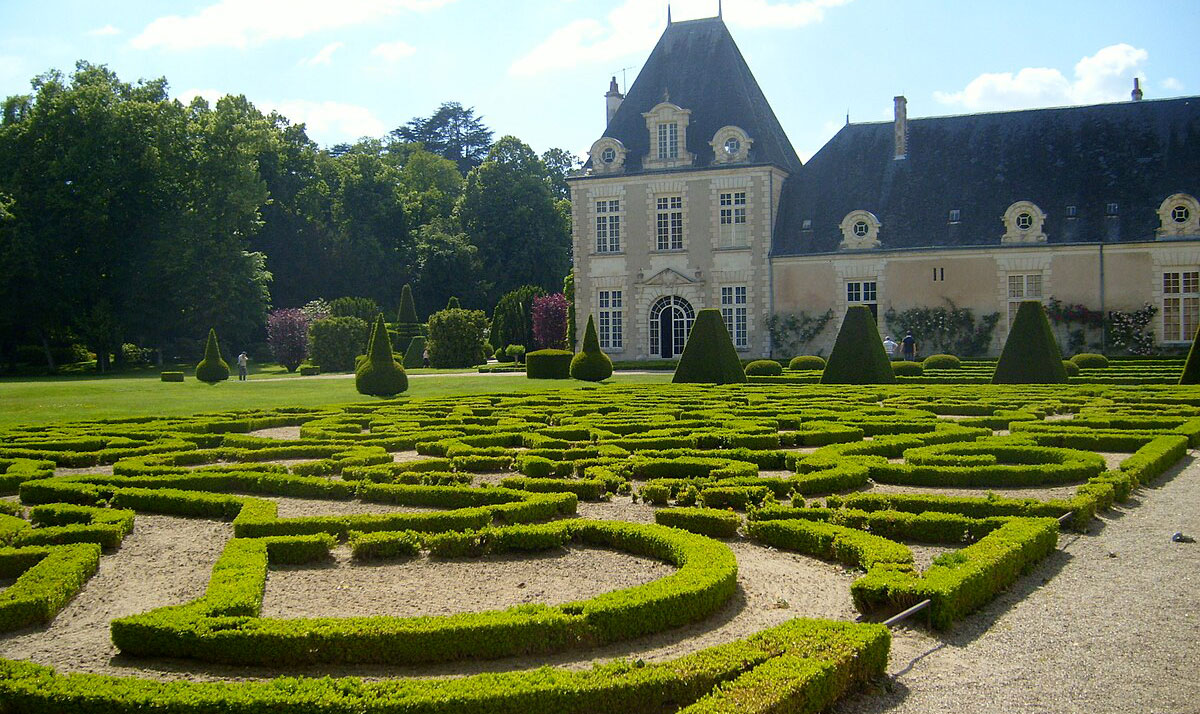
Thai Formal Gardens
Thai formal gardens, deeply rooted in the country’s rich cultural heritage, exude a unique blend of elegance, spirituality, and artistry. Influenced by ancient traditions, particularly the Sukhothai and Ayutthaya periods, these gardens reflect the principles of balance, harmony, and interconnectedness with nature. Characterized by meticulous symmetry, geometric designs, and carefully pruned plants, Thai formal gardens showcase a serene and contemplative atmosphere. Ponds, water features, and symbolic sculptures further enhance their spiritual significance. Often found within temple complexes and palaces, these gardens epitomize Thai architectural and horticultural mastery, preserving the cultural legacy and providing an oasis of tranquility amidst bustling urban environments.

Indian Formal Gardens
Indian formal gardens, are drawn from the country’s ancient civilization and diverse cultural heritage, showcase a harmonious fusion of art, architecture, and nature. Influenced by Mughal and Rajput traditions, these gardens boast symmetrical layouts, ornate pavilions, and intricate water features like fountains and reflecting pools. Meticulously manicured lawns, geometric flowerbeds, and precisely pruned shrubs exemplify the pursuit of balance and order. Symbolism and spirituality permeate these gardens, often found within palaces, forts, and mausoleums. From the world-famous Taj Mahal gardens to the historic Shalimar Bagh, Indian formal gardens celebrate the nation’s architectural finesse and horticultural excellence while offering spaces of beauty and serenity.
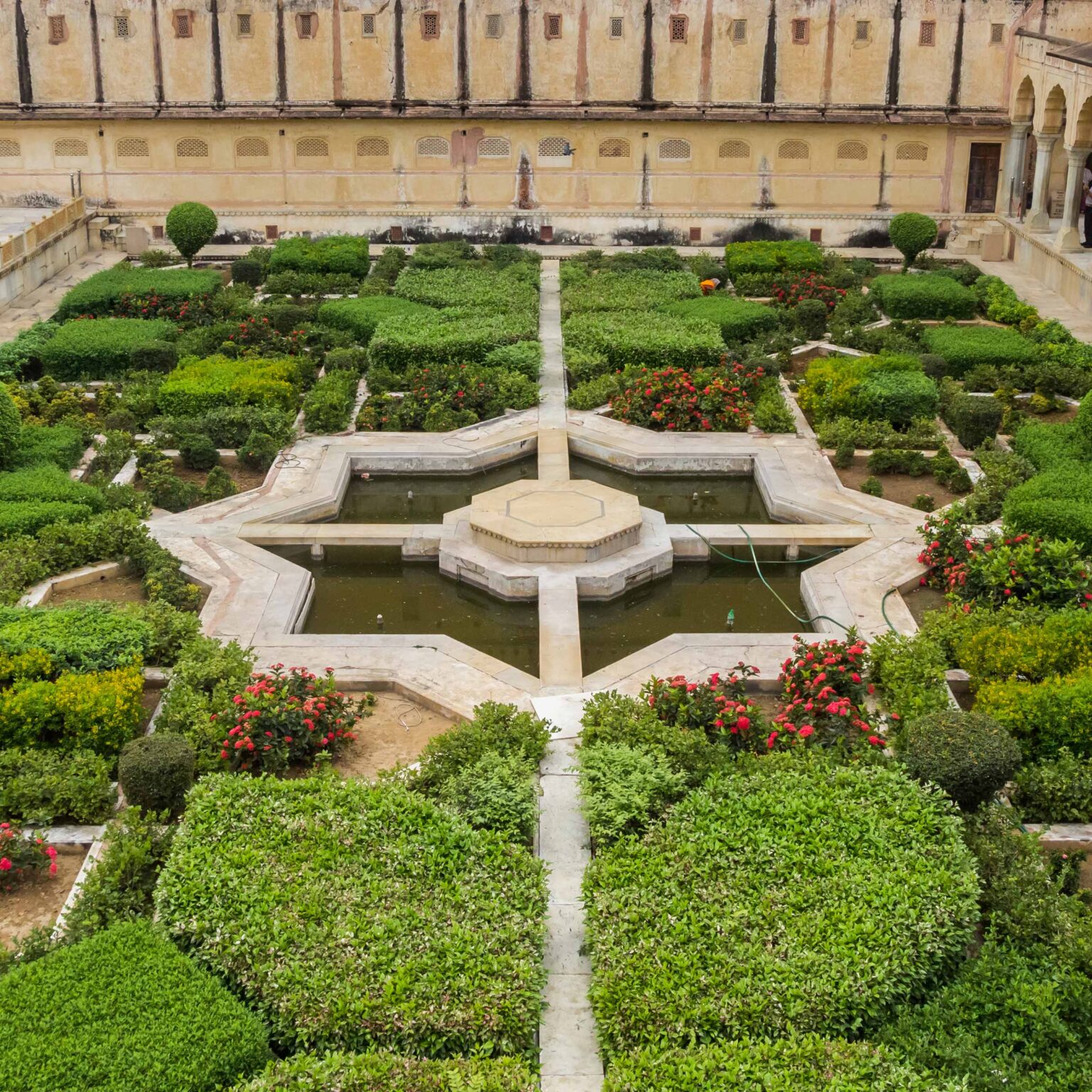
Arabic/Islamic Formal Gardens
Arabic formal gardens, known as Islamic gardens, showcase a unique blend of architectural features and decorative elements. Courtyard gardens with geometric designs, reflecting pools, and shaded arcades are prominent features. Islamic calligraphy and intricate tile work adorn walls and fountains, while aromatic plants like jasmine and roses create a sensory experience. The gardens embody the Islamic principles of order, tranquillity, and beauty.
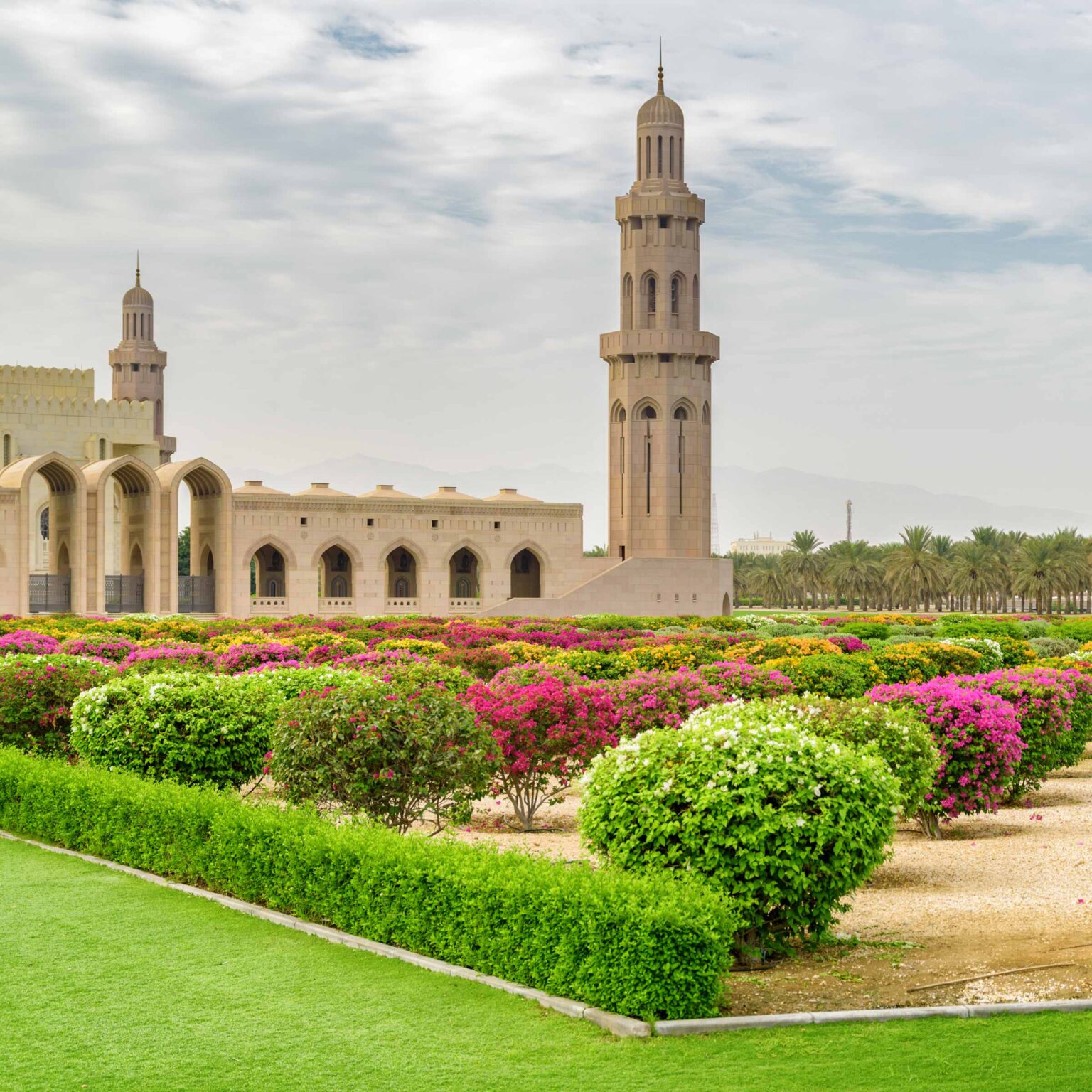
British Formal Gardens to Visit
They are many famous British formal gardens open to the public. Many are National Trust properties, so it may well make sense to get a membership if you are going to be visiting a lot of stately homes, estates and palaces to see these wonderful gardens.
Here is a shortlist of some great examples from around the United Kingdom:
Levens Hall Gardens, Cumbria
Levens Hall gardens, located in Cumbria, UK, are renowned for their historic and beautifully manicured design. Dating back to the late 17th century, these gardens are considered one of the finest examples of a traditional English garden.
The centrepiece of Levens Hall gardens is the magnificent topiary, which consists of over 100 carefully sculpted yew trees. These intricate and imaginative designs feature various shapes and forms, including animals, geometric patterns, and even a chess set. The topiary has been meticulously maintained for centuries, making it one of the oldest and most impressive displays of its kind.
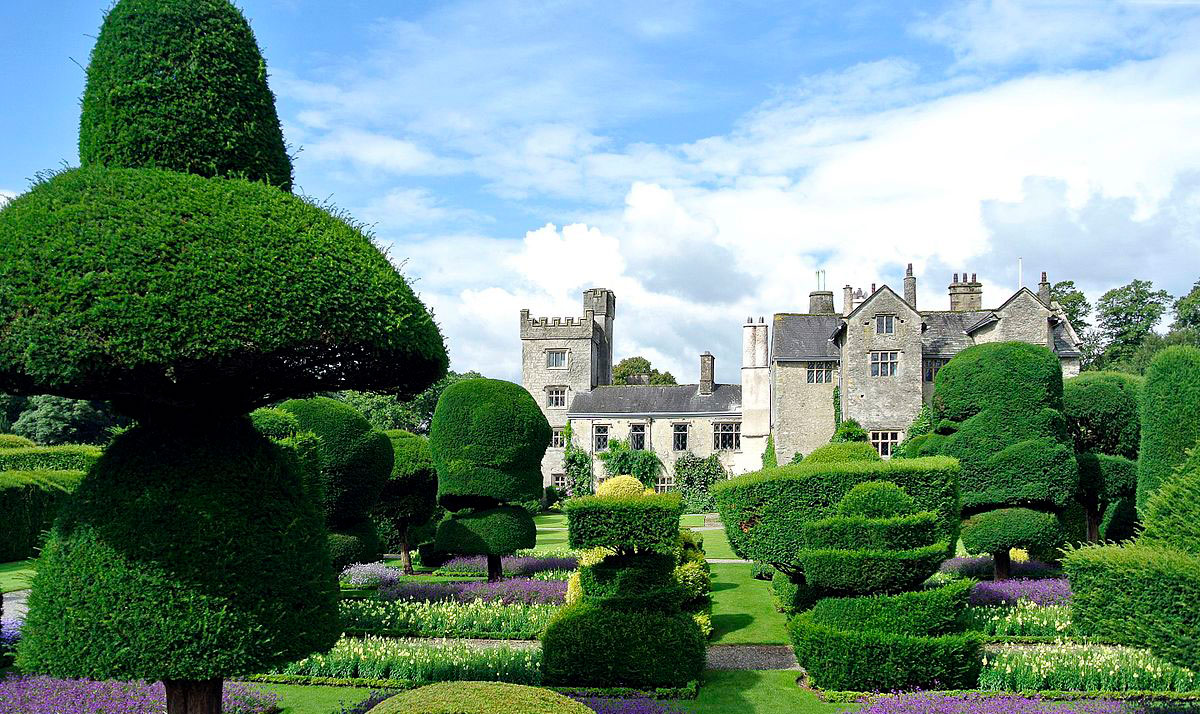
Wrest Park Gardens
Wrest Park gardens, located in Bedfordshire, UK, is a splendid landscape encompassing over 90 acres. This magnificent estate showcases a fusion of French, Italian, and English garden styles. Visitors can admire the grand mansion, stroll through the formal parterres, explore the romantic woodlands, and enjoy the tranquil lakes. The gardens offer a captivating blend of history, architecture, and natural beauty in a picturesque setting.
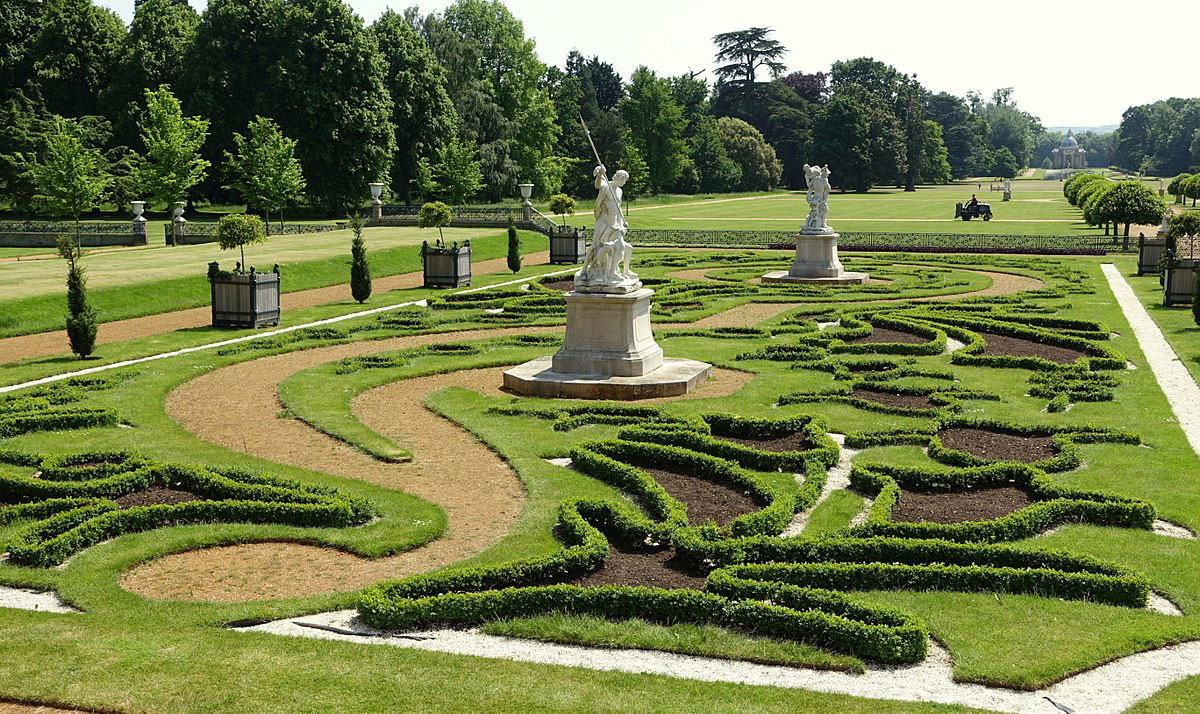
The Garden at Blenheim Palace
Blenheim Palace, situated in Oxfordshire, is an iconic stately home and UNESCO World Heritage Site. This grand palace, built in the 18th century, showcases stunning Baroque architecture and picturesque landscaped gardens. Visitors can explore the opulent State Rooms, admire the intricate details of the Great Hall, and wander through the vast parkland dotted with serene lakes. Blenheim Palace is a magnificent testament to art, history, and splendour in an idyllic setting.
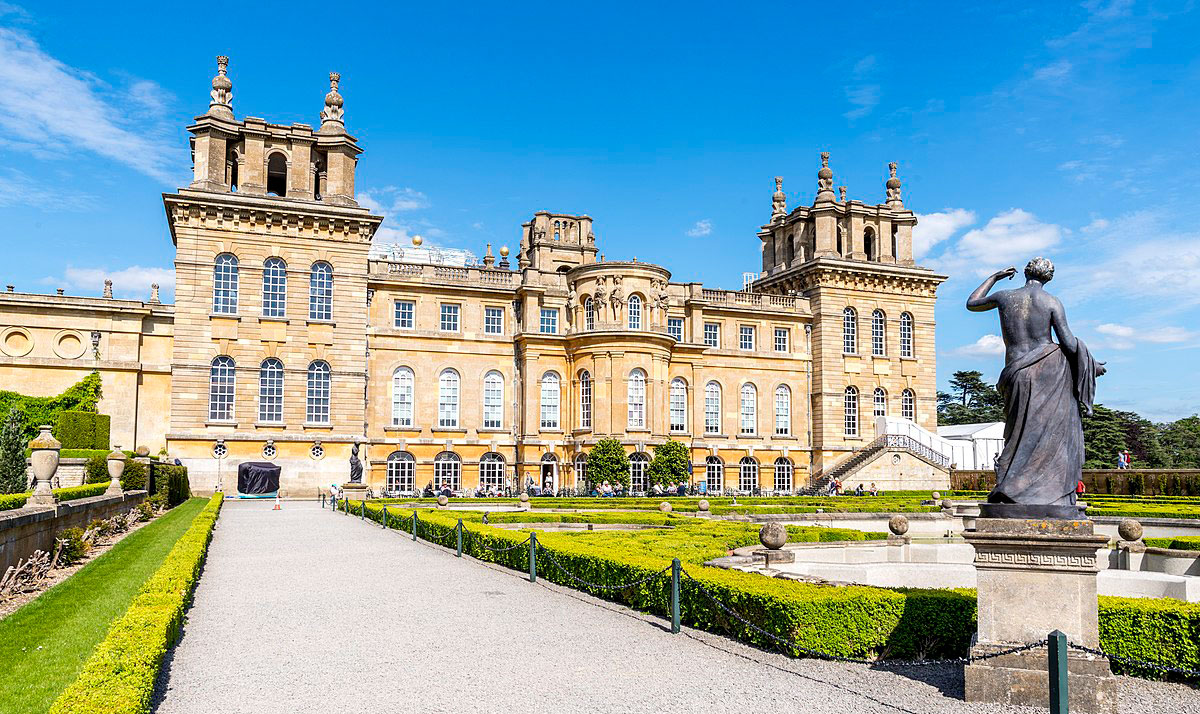
The Garden at Hidcote Manor
Hidcote Manor Park, located in Gloucestershire, is a world-renowned garden that has captivated visitors for decades. Created by Lawrence Johnston in the early 20th century, the garden is known for its innovative design and diverse plant collection. Visitors can meander through a series of intricately designed outdoor “rooms,” each with its own unique character and plantings. From vibrant flower borders to peaceful water features, Hidcote Manor Park offers a tranquil and inspiring experience for nature enthusiasts and garden lovers alike.
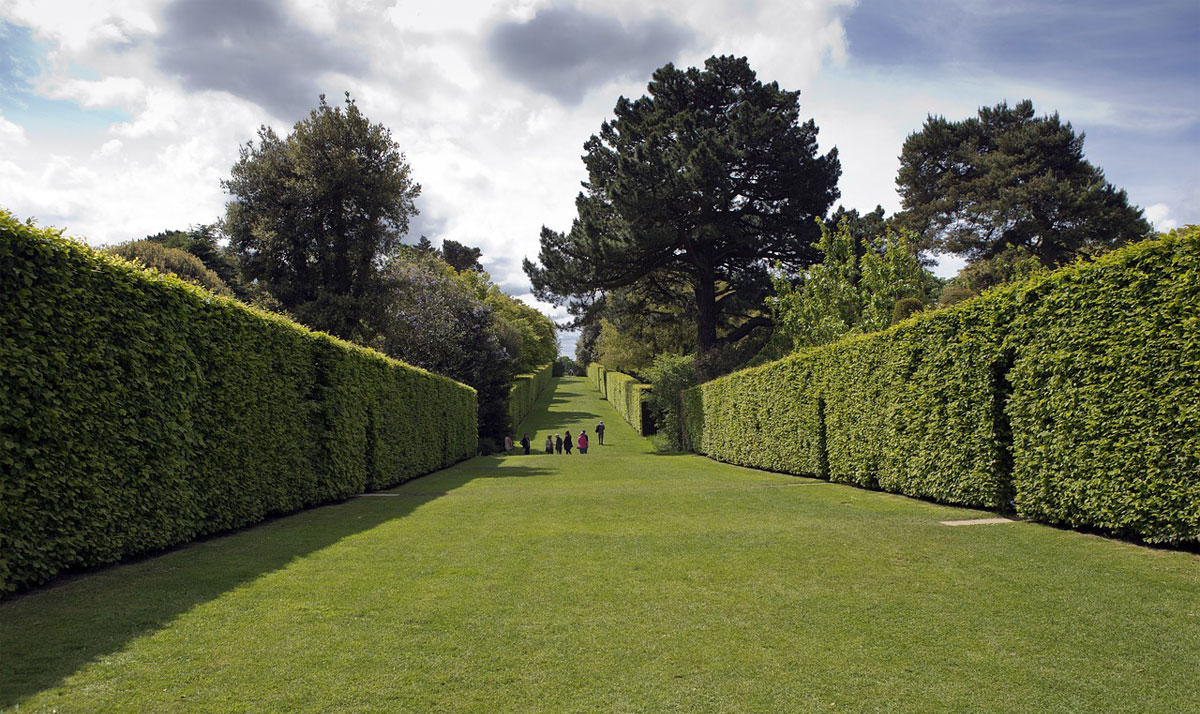
The Garden at Sissinghurst Castle
Sissinghurst Castle’s formal garden and grounds, located in Kent, UK, captivate visitors with their enchanting beauty. The centerpiece is the iconic White Garden, filled with an array of white flowers and greenery. The vibrant Rose Garden boasts an impressive collection of roses, while the herbaceous borders burst with color. The architectural elements, such as the tower and the moat, add a touch of romance to the surroundings. Sissinghurst Castle’s formal garden and grounds offer a harmonious blend of structure and natural splendor, creating a truly magical experience.
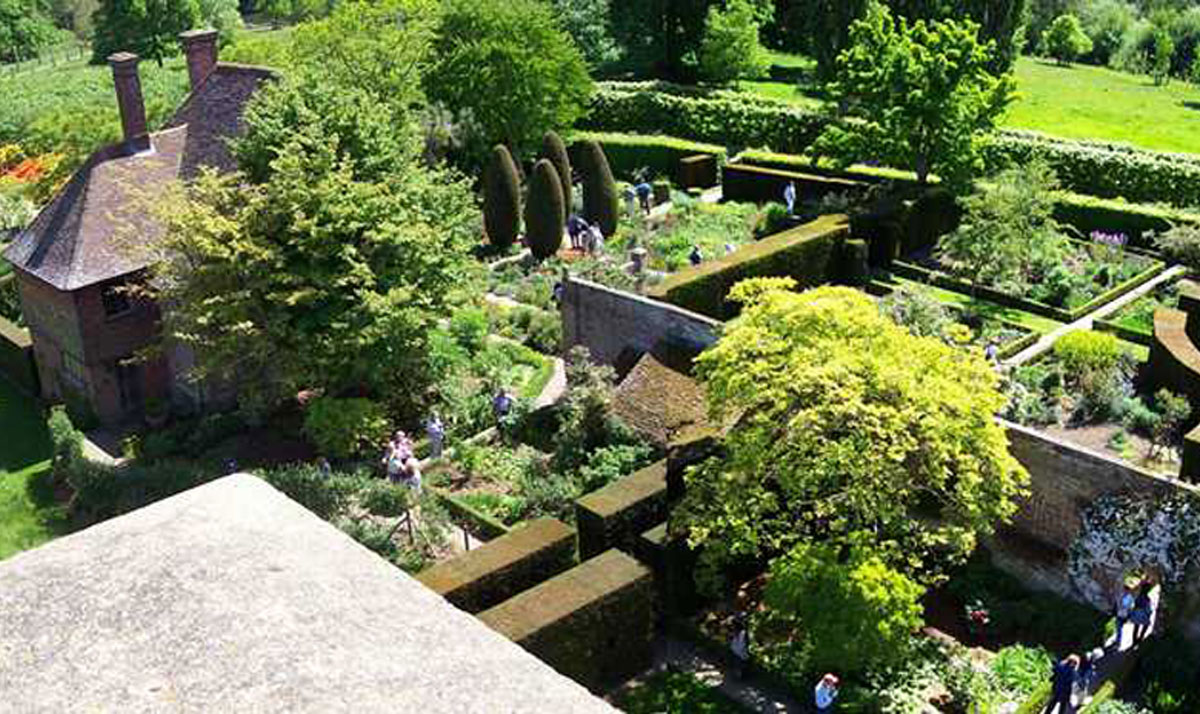
The Garden at Stourhead
Stourhead Garden is located in Wiltshire, UK. This picturesque landscape garden is famous for its enchanting lake, classical temples, and carefully designed vistas. The centrepiece is a stunning 18th-century Palladian mansion surrounded by meticulously maintained lawns, ornamental bridges, and lush woodlands. Visitors can explore the charming Grotto, wander through the vibrant Rhododendron Walk, and experience the timeless beauty of Stourhead’s carefully curated landscape, which is reminiscent of an idyllic painting come to life.
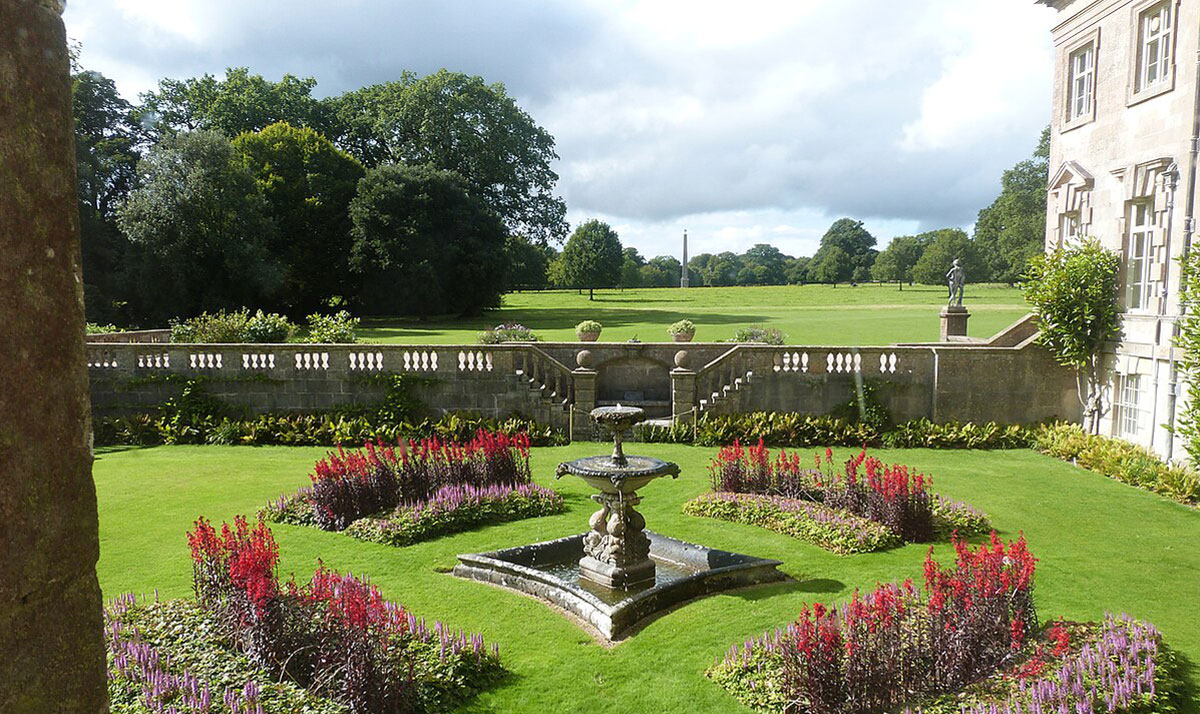
Ham House
Ham House, located in Richmond, UK, boasts magnificent formal gardens and grounds. The meticulously maintained gardens surrounding the 17th-century mansion feature geometric patterns, immaculate hedges, and elegant flower beds. The terraced lawns offer stunning views of the River Thames, while the sunken parterre garden showcases intricate boxwood designs. The serene wilderness area provides a tranquil escape, and the historic orangery adds a touch of grandeur. Ham House’s formal garden and grounds transport visitors to a bygone era of refined beauty and horticultural excellence.
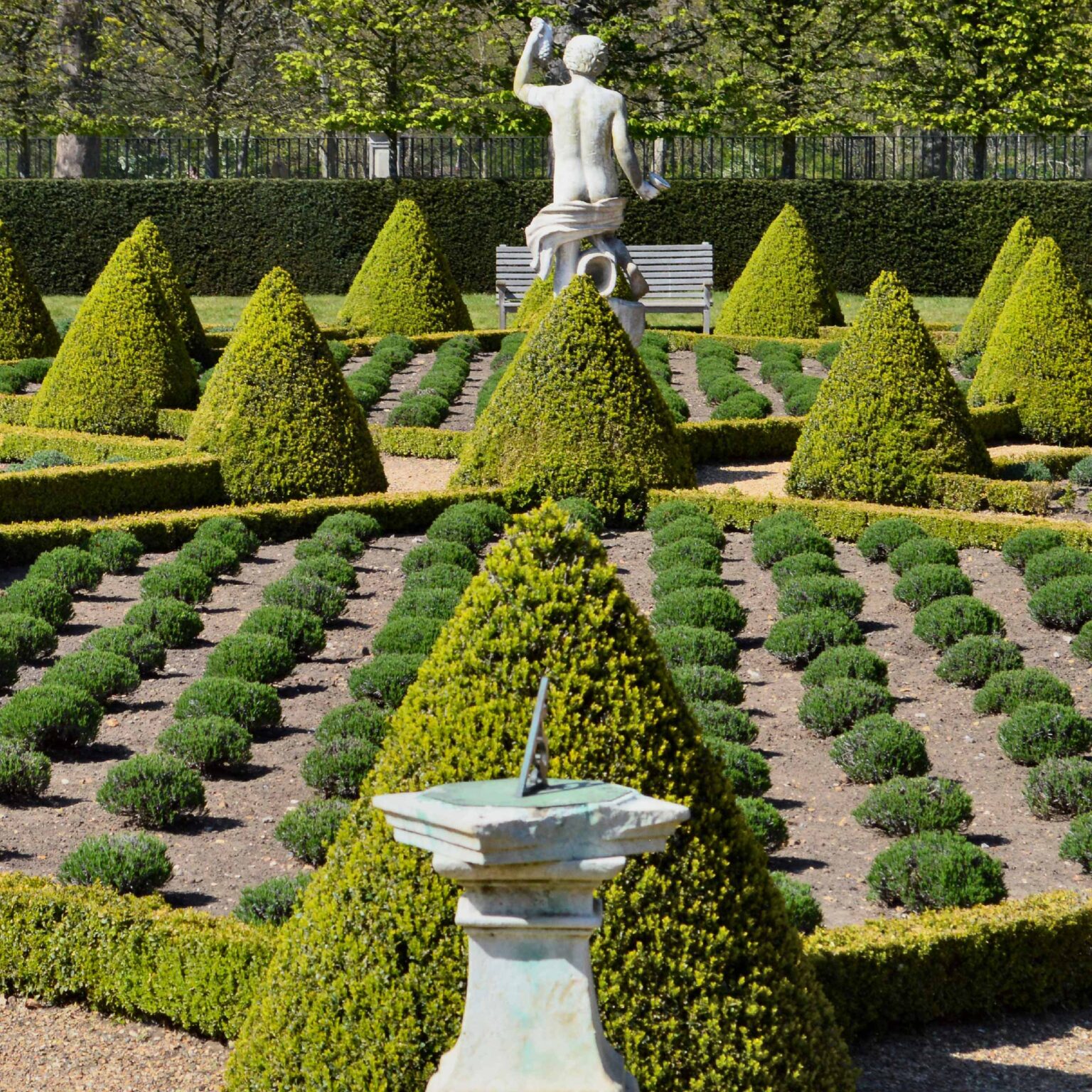
Chiswick House
Chiswick House, in west London, showcases a splendid formal garden and grounds. Designed in the 18th-century Palladian style, the gardens feature geometric patterns, symmetrical designs, and elegant pathways. The stunning conservatory, adorned with beautiful plants, is a highlight. The picturesque lake and cascading waterfall add a touch of serenity, while the classical statues and ornamental features lend a sense of grandeur. Chiswick House’s formal garden and grounds offer a harmonious fusion of artistry and nature, inviting visitors to immerse themselves in timeless beauty.
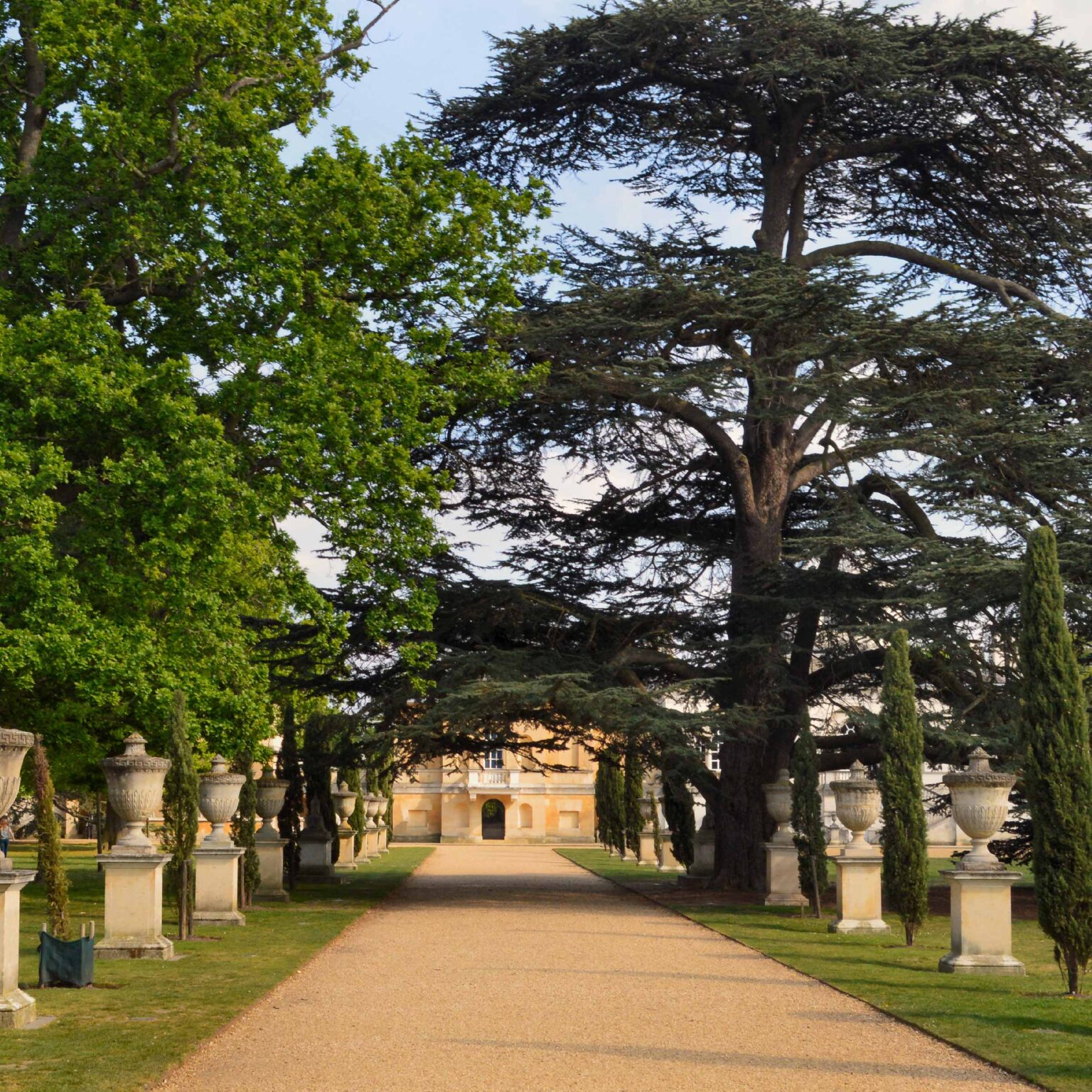
Bodnant Gardens
Nestled in Conwy, Bodnant Gardens is a haven of formal garden splendor. The meticulously manicured grounds feature terraced gardens with stunning views of the Conwy Valley. The laburnum arch dazzles with its vibrant golden hues, while the famous Italianate Terraces showcase a tapestry of colourful flowers. The tranquil water garden and its picturesque bridge provide a serene retreat. Bodnant Gardens’ formal garden and grounds offer a captivating blend of botanical delights and breathtaking vistas, immersing visitors in a world of natural beauty.
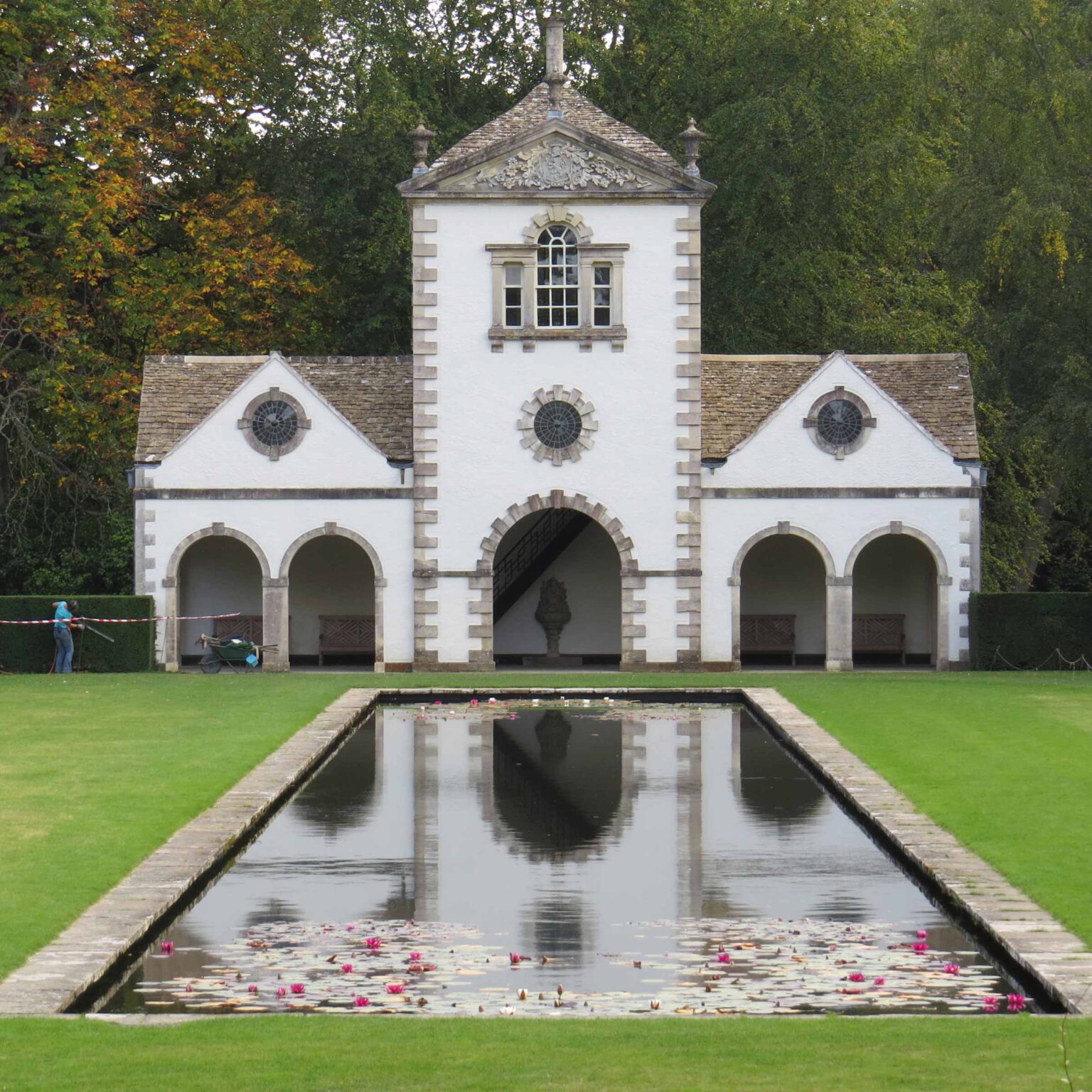
Key principles of formal gardens
Creating a formal garden can be challenging, but there are some design and maintenance principles that will help you achieve your goal. They are:
Symmetry
Symmetrical layouts create a sense of order and balance. Use pathways and viewing channels running through a symmetrical garden layout to create a formal appearance.
Geometry
Use geometric shapes, such as squares, rectangles, triangles and circles, to create a sense of order and structure. These man-made shapes provide a signal that nature is being tempered and controlled in an orderly manner.
Hardscaping & Paving
Formal gardens often incorporate hardscaping elements such as stone pathways, fountains, and retaining walls to create a sense of permanence, stability and an architectural style.
Plantings
The plants used in a formal are often chosen for their sculptural qualities and clipped geometric shapes, such as hedges, topiaries, or espaliers.
Colour
Colour schemes are often limited to a few colours, with an emphasis on green and white.
Maintenance
Formal gardens, owing to their connection with the grandeur of palaces and estates, necessitate consistent and meticulous upkeep to ensure that the edges are neatly trimmed, and the pathways remain unobstructed.
Compact formal garden.
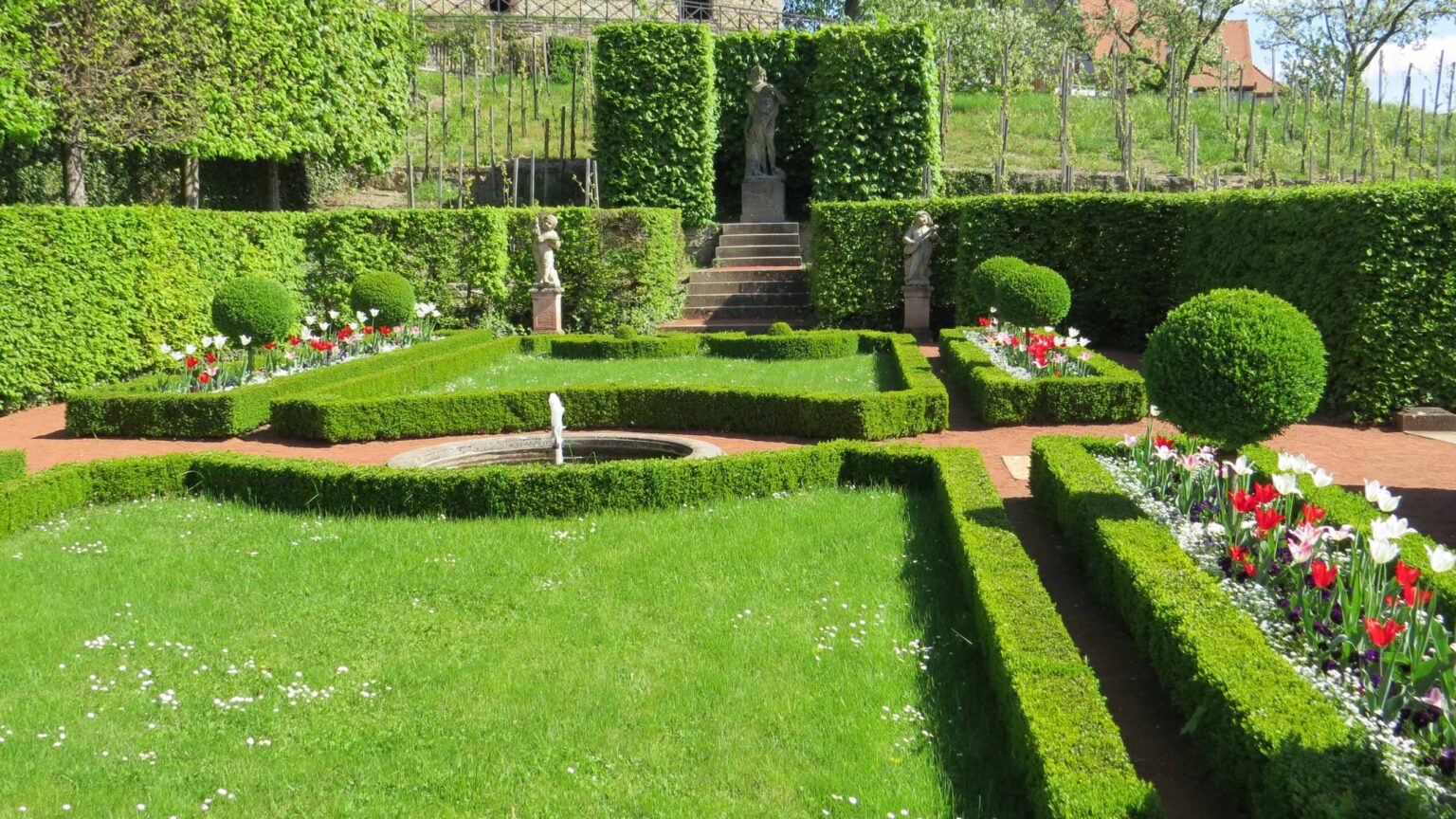
How to create compact formal gardens
When space is limited, you can still create a beautiful formal garden with these tips:
Opt for compact plants
Choose smaller varieties of plants and shrubs that fit well in limited spaces. Consider dwarf versions of roses, boxwoods, and ornamental grasses.
Focus on symmetry
Emphasize symmetrical design elements to create an illusion of space. Use geometric shapes and patterns, such as rectangular beds, a central focal point, and symmetrical plantings on either side.
Vertical gardening
Maximize vertical space by incorporating trellises, espaliered trees, or wall-mounted planters. Climbing roses or vines can add height and interest to a small garden.
Containers and raised beds
Utilise containers and raised beds to create layers and add variety. Group them strategically, varying their heights and sizes, and fill them with colourful flowers, herbs, or small shrubs.
Reflective surfaces
Install mirrors strategically to create an illusion of depth and make the space appear larger.
Lighting
Illuminate the garden with carefully placed lighting fixtures to create ambiance and extend the enjoyment of the garden into the evening.
Neatness and simplicity
Keep the design clean and uncluttered. Regular maintenance, proper pruning, and weeding are crucial to keep the garden looking its best.
By employing these strategies, even a limited space can be transformed into a stunning and inviting formal garden.
How to create a Formal Garden
Creating a beautiful formal garden involves careful planning and attention to detail. Here are some steps to help you create a formal garden:
Choose a design style
Decide on a design style for your formal garden. Some popular styles include French formal gardens, Italian gardens, and English gardens.
Each style has its own characteristics, such as symmetrical layouts, topiary shapes, and carefully manicured hedges.
Create a layout
Once you have chosen a design style, create a layout for your garden. This will involve deciding on the shape and size of the garden, as well as the location of paths, focal points, and plantings.
Add focal points
Incorporate focal points into your garden design, such as statues, fountains, and ornamental trees. These elements will draw the eye and add interest to your garden.
Install hardscaping
Consider installing hardscaping features such as walls, paths, or a water feature. These elements can add structure and definition to your garden design.
Maintain your garden
Regular maintenance is key to keeping your formal garden looking its best. Trim edges and topiary shapes regularly, weed the garden beds, and keep the lawn well-manicured.
There are more steps and processes that you need to go through prior to starting creating your formal garden, such as pathways, edging, soil preparation, lighting, maintenance etc.
When designing a formal garden, it’s important to consider the overall style, the desired mood, and the specific features you want to highlight. A professional landscape designer can help you create a customised plan that complements the formal garden’s design and meets your preferences.
Site Analysis
Assess the available space for your garden and consider factors such as sunlight exposure, soil quality, drainage, and existing features like trees or structures. This analysis will help you determine the best layout for your formal garden.

Design & Layout
Create a design plan for your formal garden. Consider elements like symmetry, balance, and geometric shapes commonly associated with formal gardens. Decide on the size and shape of your garden beds, pathways and focal points.
Focal point is a key point to design your formal garden. All elements that make your formal garden, such as plants, pathways and lighting, must naturally lead you to the actual garden with a focus point.
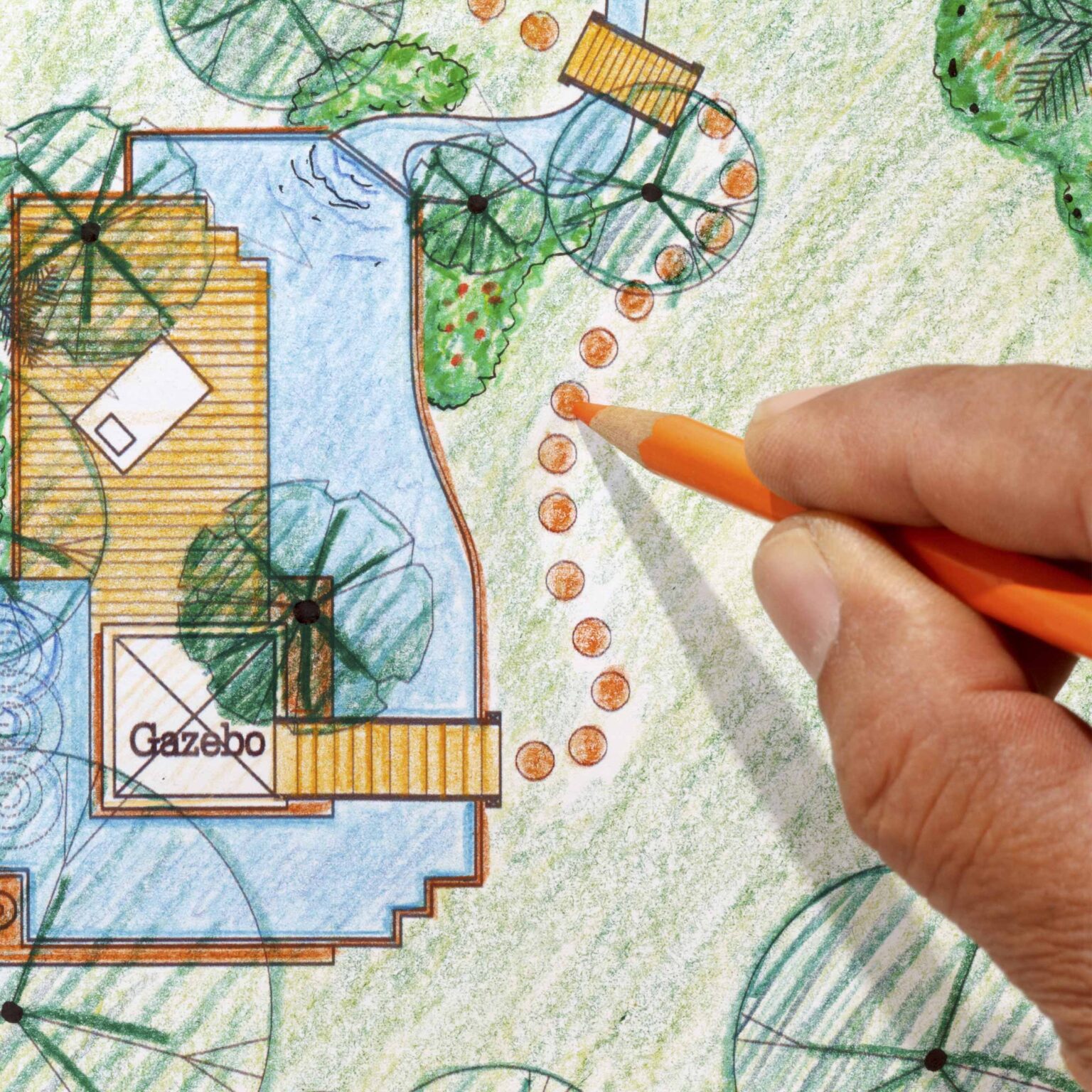
Clearing & Levelling
Level the ground if necessary to create a smooth and even surface. Note that is a very important step in the process of creating a formal garden. To flatten the ground is a long and expensive process. This can be done by a professional, and therefore the service will be charged, unless you are skilled to use a digger yourself to save money. Both options require a plan of how exactly you want your future formal garden to look like, so you know exactly what you are doing.
One element of levelling in a formal garden is terraces with retaining walls. They are common features in formal gardens, designed to create distinct levels and provide stability to the landscape. These structures combine functional elements such as supporting and containing soil on sloped or uneven terrain. By retaining the soil, they prevent erosion, minimise movement, and create flat areas for planting or walking.
Terraces with retaining walls are constructed using sturdy material such as stone, brick, concrete, or timber for their ability to withstand the pressure exerted by the soil behind them and ensuring long-term stability.
Finally, clear the site of any debris, weeds, or unwanted vegetation.
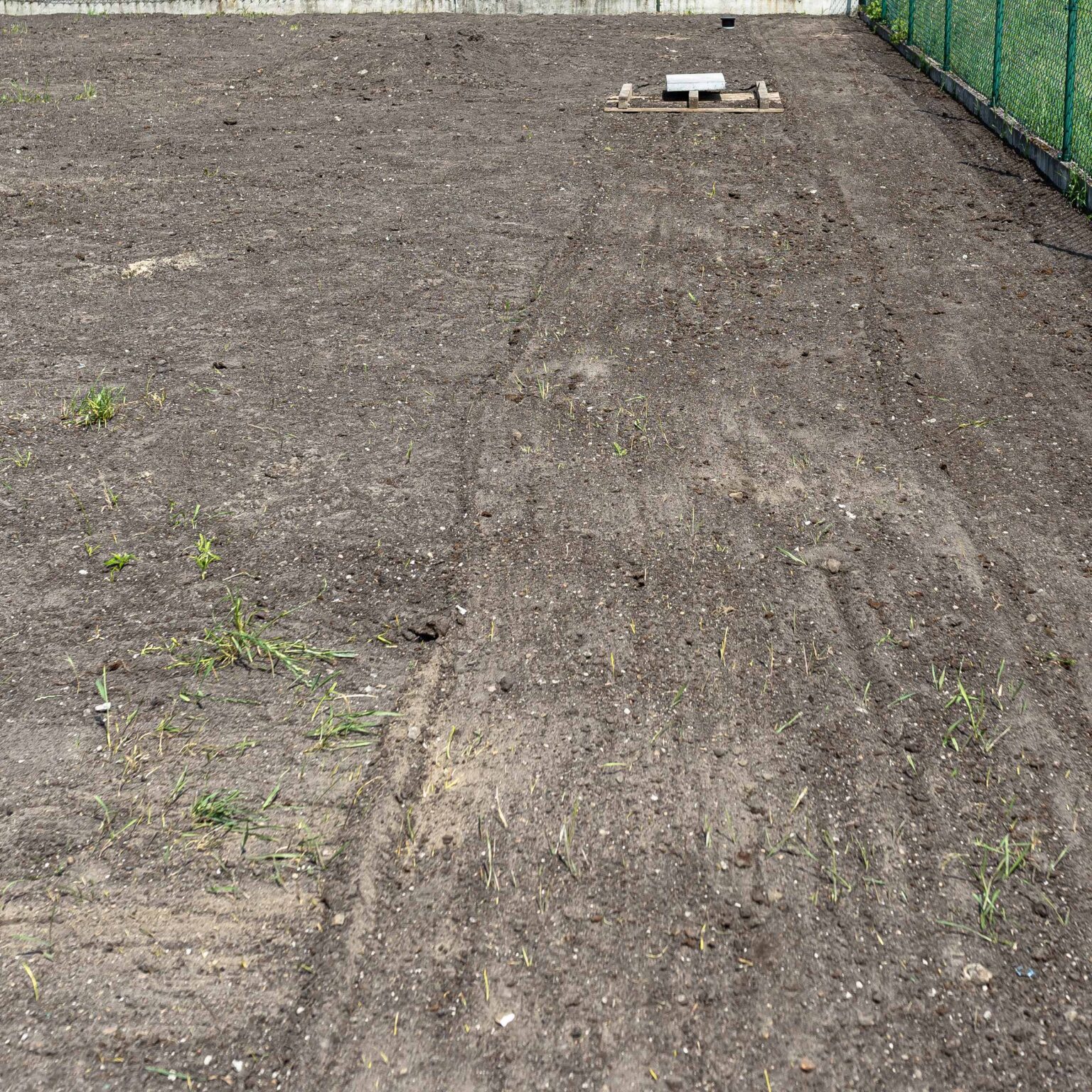
Conclusion
Formal gardens continue to captivate and inspire with their timeless elegance and meticulous design. These carefully crafted spaces are a testament to human ingenuity, showcasing the harmonious relationship between nature and artistry.
Formal gardens offer a respite from the chaos of the modern world, inviting visitors to immerse themselves in a tranquil and ordered environment. The symmetrical layouts, geometric patterns, and precisely cut hedges create a sense of balance and serenity, providing a sanctuary for contemplation and reflection.
Beyond their aesthetic appeal, formal gardens also serve as living museums, preserving and showcasing the horticultural heritage of different cultures and time periods. Whether in grand estates or public parks, formal gardens are a testament to our enduring fascination with beauty, design, and the power of nature to inspire the human spirit.
